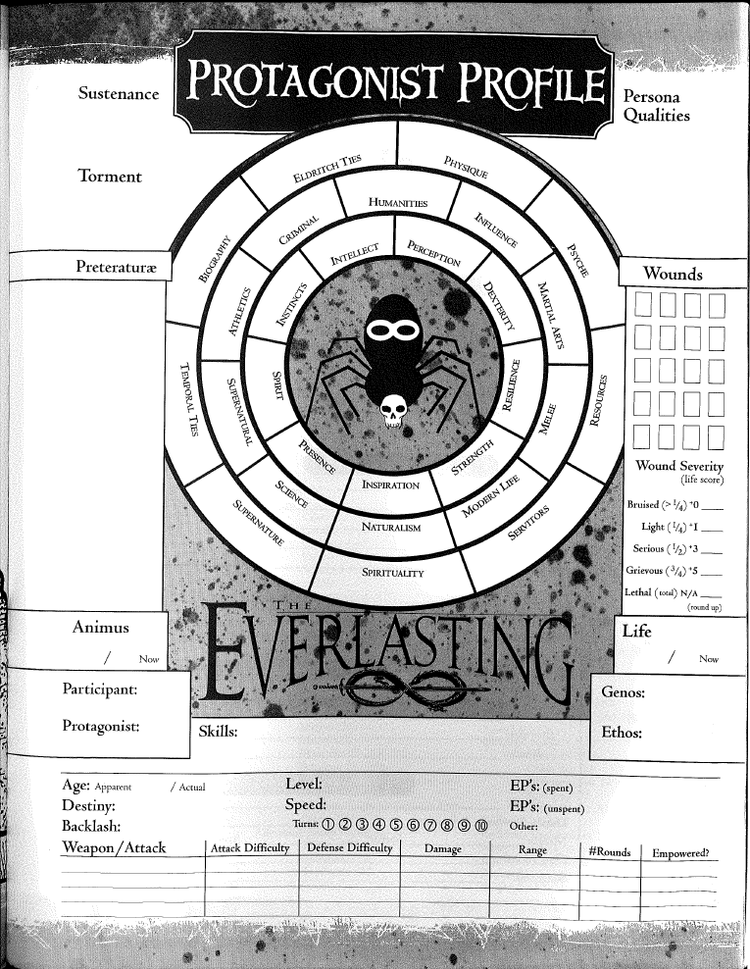The Everlasting: Book of the Unliving by Halloween Jack
Introduction
Original SA post
It's Halloween, motherfuckers! Strange things happen on All Hallow's Eve. I shave my beard so my zombie makeup will stick, and I actually start missing not only this thread, but old White Wolf heartbreakers. It's been too long since I trashed someone else's creative output. Mormon Star Wars started a review of this one which he had to abandon, and I don't blame him. My last review,
Immortal: the Invisible War
, unearthed an artifact of pompous 90s "modern fantasy" design. Continuing the trend of games with one foot in the grave and their head firmly up their ass, I present:
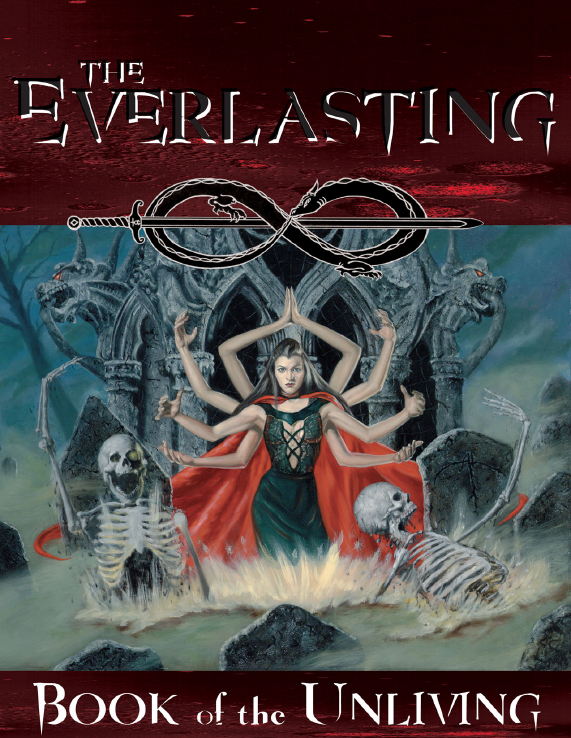
Look at those fucking skeletons! They're having a great time. That lady, though, she's either taking this way too seriously, or deadpanning like a champ until the other three dancers step out from behind her.
In this review I'll be looking at both the 1995 edition, which I bought for $2, and the revised 2005 PDF, which costs $26.80. That's a higher PDF price than anything from White Wolf, or by Greg Stolze, apropos of nothing.
As the Introduction page gladly tells you,
The Everlasting: Book of the Unliving
is just the first book in a series covering the "Secret World," that is, just like the modern world but with supernatural creatures in human form hiding behind every perpetually rain-slicked street, improbably gargoyle-bedecked building, and impossibly successful goth nightclub. This book covers ghuls (ghouls), vampires (Draculas), reanimates (Frankensteins), revenants (Crows), and dead souls (Boo Berries).
The
Book of the Light
covers angels, demons, daevas (pagan demigods), grail knights (one, two, five), and Wer (werewolves).
The
Book of the Spirits
covers gargoyles (sin-eating spirits), manitou (shapeshifting totems), the possessed (spiritual warriors possessing expendable bodies), astral spirits, dream spirits, somnomancers (dream wizards), and leviathans (demon dragons).
The
Book of the Fantastical
covers dragons (go fuck yourself), dwarves (go fuck yourself), elves (go fuck yourself), goblins (go fuck yourself), and orcs (go fuck yourself).
The introduction page also gives an Important Warning that this is all make-believe, and describes the game as "A Series of Legendmaking Experiences." That will be important later because, oh fuck it, I'm just going to type up the blurb on the back cover:
THE EVERLASTING is
The Interactive Legendmaking Experience
. It features many new concepts: communal protagonists, customizable rules, gamemasterless options, tips on achieving epiphanies, tips on rewarding guides, dream control methods, opening and closing ceremonies, and Personal Mythology. Legendmaking takes you beyond roleplaying and storytelling to a new level of intensity. Each participant chooses from playing card, tarot card, dice, and freeform options the system personally preferred.
Your journey into the realms of modern-day fantasy, horror, and mystery begins now. Enter the magical world you have always wanted to visit
the one you live in
.
You know what? I haven't even reached the table of contents, and I'm totally convinced. If you're a schizophrenic hanging out in a New Age bookstore, I'd bet my Vertigo Tarot deck that this is the perfect game for you.
Next time, on The Everlasting
I make fun of the author and probably his mother.
Credits
Original SA post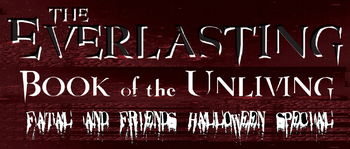
Though we still haven't reached the table of contents, I don't want to go further without singling out the credits page for special attention. Everlasting's credit page goes a few steps beyond the White Wolf convention of in-jokey credits pages that thank people for staying up all night whacked-out on Red Bull to get a book finished.
First, Brown lists the designers with arcane titles, then puts their real job in parentheses at the end of each section. He himself is credited as the "Inventor and Artisan" and "Scribe," meaning he's the creator and author. Other people responsible for this book--sorry, tome --include a Limner Administer (art director), Limners (artists), heralds (graphic designers), Illumination Administers (layout designers), an Illuminator (layout designer), Wise and Noble Oracles (business consultants), Sages of the Secret World (concept credit), and Errantry and Wisdom (all the playtesters).
I believe Crow T. Robot said it best . They might as well credit their stationer, ewer, and vending machine guy! I'll give Stephen Brown credit for remaining Stephen Brown instead of renaming himself something like Ravyn Darkchylde. Aside from that, I suspect he should have saved the legal tender (money) he probably spent on sacred herb (weed) and hired a redactor (editor).
On the same page is a Special Thanks section, which is long and includes some very peculiar mentions. No one is surprised to see Gary Gygax on the list, nor fellow White Wolf alumni Bill Bridges and Phil Brucato. His favourite prose writers include not just Ellison, Bloch, Lovecraft, Moorcock, and Tolkien, but Clive Barker and Anne Rice, while the list of comics writers includes not only alt-darlings like Moore, Morrison, Gaiman, and Wagner but innovative veterans like O'Neil and Straczynski. Then it gets weird.
He thanks The Artist (formerly known as Prince). He thanks George Lucas and Jim Henson. He thanks Shirley Maclaine and Robert Pirsig, who aren't crazy, just busy legendmaking . He thanks entire comics companies (Marvel, DC, Dark Horse), fictional characters (Lestat and Grendel) entire series (Highlander and Sandman), and individual books (the Bible). Blessed Be, says Brown, and the "blessings of heaven" upon them and their loved ones. Yes, Stephen loves me, for the Bible tells me so.
And a special thanks to the company that owns the copyright on the Rider-Waite Tarot, for saving them thousands on interior art.
Next time, on The Everlasting : He threw off his long black leather duster. He was dressed all in black--black tee-shirt, black leather boots, pants, and bandanna holding back his long black hair. His face and clothing were all blood-splattered. he wore a shoulder holster with four pearl-handle daggers, two on each side.
An October's Ending
Original SA post
An October's Ending
The Everlasting is a modern fantasy game published in the late 90s, so it must convey its setting through fiction. The preview from my last post is a direct quote from the opening story, "An October's Ending." I wish I could tell you that the story was crammed with such self-ignorant excess all the way through, because that would have made for a so-bad-it's-awesome read. Instead, the story is plagued with all the common diseases of amateur fantasy writers, including awkward sentence construction, telling instead of showing, lingering on descriptions of characters' possessions, tedious infodumps about why these people have superpowers, narrating fight scenes as a sequence of turns in a game instead of people trying not to die, and introducing every character by describing them in terms of their hair and eyes and clothes. The story is fairly boring considering its body count, racked up with kung fu, gun fu, sword-fu, knife-fu, machete-fu, and lightning-fu.
The opening paragraph makes it clear that the Secret World is a Dark Fantasy 1990s where every major city has Seattle's weather and Mogadishu's crime rate. We are introduced to Marshall, a centuries-old immortal who is planning to kill an even older immortal named Josiff. Marshall breaks into Josiff's mansion (which is stuffed with priceless artifacts just like Duncan MacLeod's house in Highlander), murders all his domestic servants, hack'n'slashes his ghost guardians, and saves his game before the Boss Battle with Josiff. The fight is like something out of a Star Wars video game, with Marshall using his pearl-handled-knife-fu while Josiff prefers floating around the room shooting lightning and telekinetically throwing his very sharp antiques collection at Marshall. Marshall finally prevails when he stabs Josiff with knives made of gold, which are poisonous to Josiff. He reveals that a demon extorted him into killing Josiff under threat of eternal torture, and finishes him off. Aaand cut.
The next scene features Tom and Jennifer, a young couple on a road trip in Thomas' fully-restored candy-red GTO with white drag strips. Tom is a younger immortal on his way to a meeting of "the fellowship" in the wake of Josiff's death. He's just asked Jennifer to leave her life beyond and move across the country with him, but he hasn't told her he's an immortal yet. He decides that this is the time, and proves it to her by pulling off the road, leading her into a cow pasture, pulling out a handgun, and blowing out his brains--which he quickly regrows, such as they are. He then treats Jennifer, and us, to a long boring infodump about how he's one of the daeva, a race of immortals who were worshiped as pagan gods. Aaand cut.
Scene three is about Luther de Fontaine, who is just leaving his girlfriend's house when a mob of demon-possessed derelicts drag him into an alley and attack him with bricks and bats and brickbats and whatnot. Just when he's on the verge of death, he tears off his shirt, flexes, and starts hitting demons with the Atomic Leg Drop and such. The author interrupts this fight scene to explain that Luther is a quester, who joined a secret order in the 1800s and became immortal when he found and drank from the Holy Grail. After his Duncan MacLeod style flashback, Luther beats all the demons to a pulp with his bare hands. Then he goes home, calls his girlfriend, and eats leftover Chinese food. That's right.
Our last protagonist is Margaret the vampire, who has demon problems of her own. Specifically, a mob of them just burnt down her antebellum mansion and she's running for dear unlife. She flees into her ghul catacombs and sets some Indiana Jones style traps behind her, then runs through the catacombs to a room filled with roses to mask the stench of undead dudes, and asks sanctuary from a scabby gross ghul named Revis Frome. She spends the next day chilling out in the
Class, can you see what's wrong with this story? There are four vignettes, and only one of them concerns the characters covered in this fucking book! Not only that, but it's the least eventful and informative out of all of them; a vampire asks a ghoul if she can crash at his pad for awhile, and we don't learn much about either of them or their kewl p0warz. This does not bode well for our heroes.
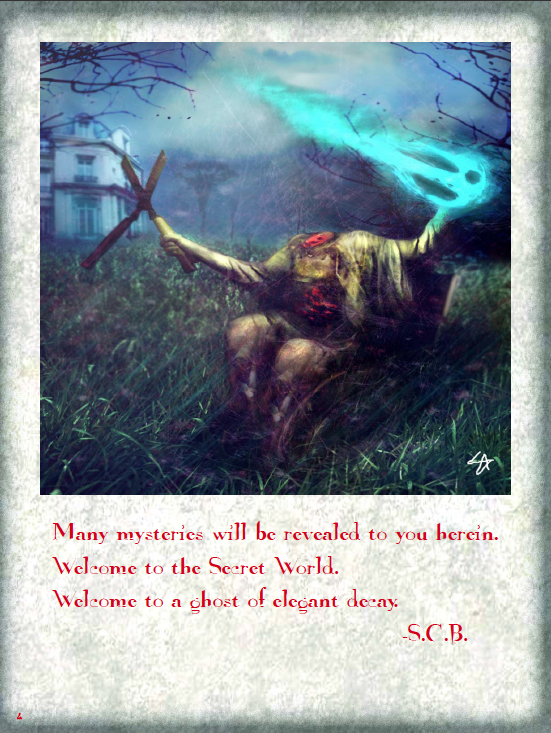
Welcome to the Secret World
Not a White Wolf game
We got elves and gargoyles
Plus we changed the name
Welcome to the Secret World
Of elegant decay
If you want some mysteries
Use Tarot cards to play
Next time, on The Everlasting : An overview of the setting, with so many sidebars and jargon words you'll think you're reading Immortal.
Entering the Secret World
Original SA post
Everlasting is difficult to summarize because it’s so poorly organized, and it’s not easy to convey confusion without being confusing yourself. The book doesn’t reach the schizophrenic depths of Immortal: the Invisible War , but from the very first chapter I notice much that it has in common with that game. It drifts from topic to topic, makes liberal use of sidebars, doesn’t discuss important topics where you’d expect, and its gamemastering advice is either simplistic or suggests bizarre methods. It also promises the possibility of deep personal revelation from gaming, and the first chapter ends with a lengthy glossary of setting jargon.
Chapter 1: Entering the Secret World is supposed to be an introduction to the setting, but it begins with a rambling appeal to belief in the supernatural. Like, are people fascinated with vampires and shit because it's fun, or is it something more? Are you religious? Because if you are then you totes believe in the supernatural. Just because you can't see it doesn't mean it's not real. Scientists know that there are, like, other dimensions, and what about the stuff science can't explain? The world would be a lot less interesting without believing in stuff you can't see. Like, how do you know atoms exist, can you see them? Anyways, it doesn't matter what your mean old dumb boring science says, billions of people believe in the supernatural. Do you?
There are too many fallacies to count, and it's only half a page. This is just one of many points in the book where I'm not sure if the author is telling us about the game, or inviting us to a Wicca ceremony with a bunch of flaky geeks to see if it "works for us." When you have to put up with this shit face-to-face, at least there's free weed.
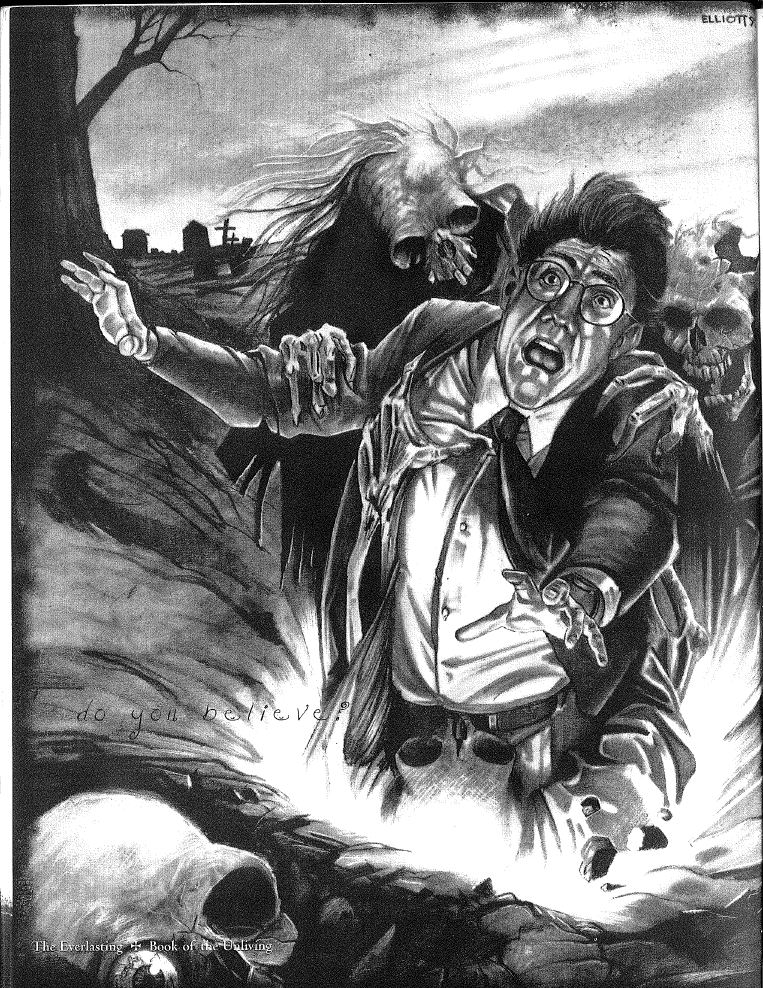
Do you believe this guy's body will be found with binoculars hanging over his dick?
Everlasting spends several pages on its introduction to roleplaying, and frankly, it would be damned boring if it wasn't so flaky. In the very first paragraph, it states that the goal of the game is “to take your own Hero’s Journey, developed by the great mythologist Joseph Campbell.” Then it reminds experienced gamers that Everlasting is "more than a game, it is a Legendmaking experience." It tells us to be open-minded about new methods which transcend the "roll-playing" we've learned from other games. Jesus wept.
The book only spends three paragraphs on “What is Roleplaying?” before jumping into those new methods. We get one paragraph suggesting you try live-action roleplaying, and most of that is caveats against touching, violence, or scaring people in public. Then it devotes an entire page suggesting "communal Protagonists," in which PCs are traded around the group from session to session. We learn that Everlasting PCs are called Protagonists and the GM is called the Guide, and it’s hinted that rotating, sharing, or splitting the Guide’s duties is considered normal in this game. Sidebars bear the weight of explaining that Everlasting can use cards (Tarot or standard) or dice (d4,d6,d8,d10, but mainly d12), that you need character sheets and pen-and-paper, and that you might want some minis and counters.
A brief section on storytelling acknowledges that roleplaying is storytelling. (Hey, 90s game design got some things right.) It says that storytelling teaches us things about ourselves, but that most of us receive stories from mass media instead of using our own imaginations. Roleplaying is an opportunity to take that back. I can get behind that. However, Everlasting’s love affair with itself continues in a section on Legendmaking and being a good Legendmaker . What is Legendmaking ? I’m not sure the author or any of his fellow creators actually knows. I do remember that Visionary Entertainment had a spokesperson on forum.rpg.net back in the day, who couldn’t satisfactorily defend Legendmaking as something above and beyond roleplaying. Here’s what I learned from the Legendmaking section:
1. Legendmaking allows you to build your own Personal Mythology .
2. “...the best place to begin is by consulting Joseph Campbell’s works, especially The Hero with a Thousand Faces and The Power of Myth.”
3. Legendmaking allows you to find the magic within yourself,” “explore magickal places,” “experience mythology,” “gain practical wisdom,” and “transcend the mundane.”
4. Legendmaking is italicized about 50% of the time.
5. The purpose of a legendmaker is to flip out and kill people.
The next page is seriously titled “ A Higher Plane of Consciousness ,” but it’s just more drivel about imagination and storytelling and magick. The only eye-catching line is when it outright states that in Everlasting, the Guide’s duties will normally be split between several people so everybody can play a Protagonist. I can’t wait for the GMing chapter to explain how that’s supposed to work.
After a page and a half of this crap, Everlasting finally, finally gets around to introducing the setting. In this game, there are many races of supernatural beings, called the Eldritch. (That’s awkward, but better than White Wolf fans discussing “supernaturals” for lack of an official catchall term.) The Eldritch includes everything from elves and wizards to vampires and gargoyles, and they inhabit the Secret World which lurks just under the surface of the everyday world.
This blends into an explanation of the game’s primary “themes.” The most important is “Ignorance and intolerance will be the death of us.” This makes itself known in the setting as a metaplot event called the “Death Knell,” which unleashed an army of demons upon the world. If the different Eldritch races can’t get along, we’re all doomed. Another is “Loneliness is a way of life.” Living for centuries while all your loved ones die is hard, and it hardens you. Who waaants to liiive foreveeer? The last is “It’s easy to lose touch.” A lot of people hold on to a familiar worldview while reality leaves them behind, and this is an easy vice for immortals.
Next is a page of “ milieu elements .” This is really a list of all the things people look for in roleplaying games, like action, exploration, and romance, but with some definite emphasis on things that were popular in the 90s, such as conspiracy, gothic ambience, dark fantasy, and splatterpunk horror.
On the next page we finally get into the nitty-gritty of the Secret World . The Secret World, is separated from the “Real World” as most people understand it by the Reverie , a magickal reality which overlays the ordinary world, and which only Eldritch and a few gifted individuals can see. Beyond the Reverie is the Otherside , a catchall for all of the parallel dimensions--and there’s a shitload of them. The Astra (astral realm) contains everything from the Jungian collective unconscious to the Netherworlds where demons live. The Faery Kingdoms contain forgotten fragments of reality. The Underworld contains dead souls and other strangeness, while the Dreamworlds comprises warped versions of all of the above.
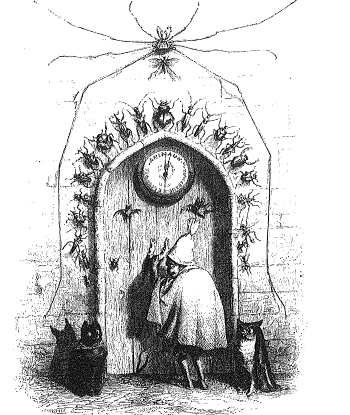
"What? You mean I have to go all the way back to the Insect Castle? I hate this game.
Much as it is in the World of Darkness, the Eldritch used to play a prominent role in human affairs, but this diminished over millennia and now they tend to congregate in major cities so they can interact with more of their own kind. Most of them are concerned about the Death Knell. The daevas, those Highlander demigod guys, have the power of prophecy, and most of them predicted that they would all go down fighting in a ragnarok against a demon army, and usher in a new age. That didn’t exactly happen, but an army of demons did arrive, the Otherside was rocked with cataclysmic events, and most of the daevas died or disappeared. Since then, something called the “Convergence” is drawing Eldritch of all kinds to North America, which has become a battleground in the demon war.
And now there is jargon. All of it.
Aceldama : Meaning slaughterhouse, a word for a region or city that’s become a violent battleground.
Adapan : A lost race of prehistoric humans who coexisted with dragons.
Aethyr : A realm within the Astra.
Agartha : “outer realms existing as alternate dimensions outside the human consciousness.” Okay.
Agarthic Sphere : Any realm within the Agartha. Earth is one.
Antediluvian cities : Ancient Adapan cities.
Antediluvian civilization : The Adapan civilizaiton. Destroyed by the “Great Deluge” in the “Cataclysm,” of course.
Ashura : The founders of the first immortal clans.
Astra : the spirit world.
Athanasia : Immortality. Okay.
Azhi Dahaka : An Eldritch who’s eaten the soul of a dragon, gaining its power.
Blood Feud : Fighting between two factions or races of immortals.
Changeling : An immortal in the process of transforming into a faery.
Children of the Night : the undead.
Collective : An astral realm which is the collective human unconscious.
Condemned Soul : a dead soul.
The Convergence : A ripoff of The Gathering from Highlander, some mysterious force drawing immortals to North America.
Corpse-Eater : ghul.
Crusader : A quester.
Cycle of Reincarnation : What mummies call the cycle of reincarnation they go through. Okay.
Daeva : Immortals who resemble mythic demigods, and who have powers linked to time and fate.
Dead Soul : A disembodied spirit dwelling in the Underworld.
Death Knell : The metaplot event that killed more than half of all daevas and kicked off a series of unfortunate events. It began about 20 years ago.
Deathless : A catchall for daevas, questers, and undead, since none of them age.
Demon : a living incarnation of negative emotions.
Daodine : Faeries who were once human (or other eldritch).
Discarnate : Intangible spirits.
Dogs of War : warmongering immortals who spur on conflict.
Dominion : An eldritch’s territory.
Doomsday : The theoretical end of all magick and immortals. And possibly all life on earth.
Dragon : They’re dragons. They think they’re the oldest and the wisest.
Dragon Cities : The Antediluvian cities (see above).
Dreamlord : Powerful dreamers who control a realm in Phantasia, part of the Dreamworlds.
Eldritch : A supernatural creature, including the everlasting, faeries, dream entities, spirits, and demons, but excluding mortals with magick powers.
Empyrean : An older, equally awkward word for the Reverie.
Eternal One : A term of respect for the really really old immortals.
Ever Reborn : The Osirians.
Everlasting : All immortals, including daevas, dragons, manitou, Osirians, possessed, questers, and unliving.
Everlasting Society : The society of the Everlasting. Derp.
Faery : Creatures from the faery realms; they may or may not be immortal.
Faeryland : Their home dimension. It consists of fragments of reality “stolen” from Earth and other realms.
Fantast : A mortal who can perceive the Reverie.
My fingers hurt and I’m only on letter F.
Fellowship : A group of immortal allies. In other words, the term for your adventuring party.
Final Battle : The ragnarok against the demons, predicted by the daeva.
Freak Show : Showing off your powers to mortals.
Fringe : Yet another synonym for Reverie.
Fringy : spending too much time among immortals so you act like a space case.
Frontier : North America.
Genos (pl. Gentes ): A race of eldritch.
Ghul : Subterranean undead eldritch who eat corpses.
Godling : Derogatory for daeva.
Gotterdammerung : A prophesied time the daeva will all die and be replaced by cool new gods, like Metron and Mister Miracle.
Grail Knight : an order of questers dating back to Arthur’s roundtable.
Hellbound : Anyone who’s traded their soul for demonic power.
Hellspawn : The hybrid child of a mortal and a demon.
Household : A group of daevas who organize themselves kind of like a familial pantheon.
Kith and Kin : An immortals’ loved ones.
The Legacy : Immortality.
Leviathan : Demons made from dragons’ negative emotions.
Lyncanthropes : The wer.
Magick : The way to spell real magic.
Manitou : Nature-serving immortals created by binding an animal totem to a human.
Menagerie : The collective unconscious of animals, from which totems come.
Merodach : The first immortals, chosen by dragons to rule their cities. They betrayed the dragons and were killed.
Merodachian : An adjective meaning “of the merodachs.” Yes, this is an entry.
Mindscape : The Astra.
Minion : a mortal who serves an eldritch.
Mundane : Mortals who only perceive the Real World.
Nightmare Lands : A dreamworld where shadows live.
Nimbus : the magickal aura of an eldritch.
Ochelum : a dream entity that possesses and preys on mortals.
Old Soul : A very old immortla.
Osirian : Mortal sorcerers who reincarnate, remembering their past lives upon reaching adulthood.
Outcast: An eldritch shunned by their own kind.
Phantasia : A series of kingdoms in the dreamworlds.
The Possessed: The mortals possessed by ochelum, via a magic gem.
Preternatura : Any kind of supernatural powers.
Quester : Humans who became immortals by pledging themselves to a good cause and receiving divine blessing. For example, the Grail Knights.
Rapture : A ripoff of the Quickening from Highlander, which happens when an immortal dies.
The Real World : The “normal” world most people perceive.
Resonance : The traces of supernatural powers and energy.
Reverie : The magickal energies that overlay normal reality, which only eldritch and sorcerers can see.
Seelie : Benevolent faeries.
Secret World : All the magickal truths of the world that mortals can’t usually see.
Serpent Lord : An azhi dahaka.
Shadows : Dreamworld creatures which turn dreams to nightmares and feed on fear.
Shapeshifter : A wer or a manitou, or any eldritch with shapeshifting powers.
Sempervivium : Yet another word for immortality.
Skinchanger : Yet another word for wer.
Sluagh : Generally evil faeries.
Sojourn : When an immortal abandons their life to start over.
Somnomancer : A mortal dream wizard.
Somnorium : Each person’s own personal dream realm.
Templar : The obligatory mortal secret society that’s aware of eldritch.
Temporal Society : what immortals call the ever-fleeting human society and pop culture.
Therianthrope : A wer that’s not a werewolf.
Those Who Are Soon Gone : a term for mortals.
Titan : A merodach.
Totem : The animal spirits which turn mortals into manitou.
Un-dead : The unliving.
Unliving : The un-dead.
Vampire : Undead immortals who must drink blood.
Vattan : The Adapan language.
Verdant Lands : The astral realm of the collective unconscious of plant life. Seriously.
Void : Realms of utter nothingness.
Vortex : Magickal rifts in time and space.
Wakanda : Nature spirits.
Warhawk : Immortals who engage in internal disputes.
Wer : Mortals infected with the “changing virus” that causes them to transform into werecreatures.
Wisdom of the Ancients: The philosophy by which many immortals live; it preaches secrecy and nonintervention.
Zone : The Reverie.
Zoner : A fringy eldritch.
Next time, on The Everlasting : All work and no play makes Jack Command+B. All work and no play makes Jack Command+B. All work and no play makes Jack Command+B. All work and no play makes Jack Command+B. All work and no play makes Jack Command+B. All work and no play makes Jack Command+B. All work and no play makes Jack Command+B. All work and no play makes Jack Command+B. All work and no play makes Jack Command+B. All work and no play makes Jack Command+B. All work and no play makes Jack Command+B. All work and no play makes Jack Command+B. All work and no play makes Jack Command+B. All work and no play makes Jack Command+B. All work and no play makes Jack Command+B.
Getting the Creation On
Original SA post
Now hold on a minute, before we go much further
Give me a buck, so I can buy a rubber
--Revolting Cocks, “Do Ya Think I’m Sexy?”
Before we go any further, a brief aside for a comment I neglected in my last updates.
I want to give The Everlasting credit where credit is due. Although I haven’t even read their book yet, I’m glad that this setting has immortal grail knights, fate-spinning demigod Highlanders, sin-eating gargoyles, people possessed by animal totems, and dream wizards. That’s more original than the progression of Hammer Horror monsters that every other White Wolf ripoff slogged through. I like the fact that the game states from the outside that all the Everlasting are part of a larger community; that’s actually better than what White Wolf did, where every “race” got a discrete game, then they crossed them over hurly-burly to compete with each other in all their awfully-balanced glory.
That being said, do you get the impression that this book about the undead is...not? The undead characters hardly feature in the opening fiction, and outside of the glossary, they don’t feature at all in the setting metaplot, which is far more enamored with demons and daevas. This being a White Wolf heartbreaker, I expected the author to be totally high on vampires, with everything else shoveled in as an afterthought. Instead I get the impression that he can’t wait to dispense with this vampire crap so he can tell us about the daevas, who are all black belts in karate and have uncles who work for Nintendo.
Moving along.
Chapter 2: Protagonist Creation :
I am picky when it comes to how books are organized. I get really mad at games--including a lot of games you guys love--for trying to walk me through the “C’mon, create a character, it’ll be great!” like I’ve never picked up a RPG before, and before I know anything about the character traits or the basic die mechanic.
The Everlasting is certainly guilty of that offense. The first thing it asks us to do is pick our genos (plural gentes), your monstrous race. Wow. White Wolf and most of its ripoffs at least paid lip service to the idea that you should come up with a character concept before you pick your flavour of Dracula, but not here.
About that “genos” thing: Like Immortal , whenever The Everlasting needs a jargon word, it misappropriates either mythology or Latin.
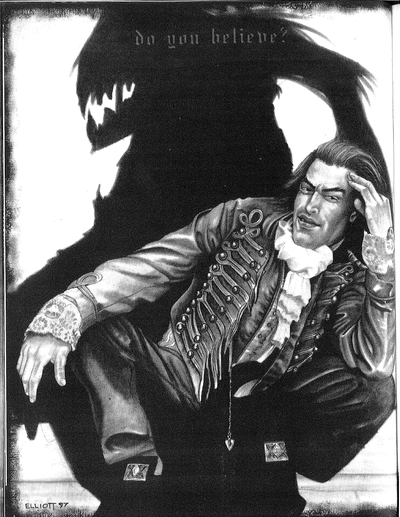
Do you believe he’s wearing that to the mall? It’s 100 degrees outside.
Step 1: Genos
This book covers three gentes: Ghuls , Revenants , and Vampires . Each has subtypes for you to pick, and in some cases, factions. The entries also tell you what bonuses and penalties you get to your traits--but we haven’t even seen a sample character sheet yet.
Ghuls are humans who consumed an “elixir of life” called Anecro, which grants immortality but curses you to sustain yourself by eating dead human flesh.Ghuls control vast networks of underground tunnels--caverns, catacombs, and sewers--and live in packs ruled by the strongest and fiercest, like wild dogs. Many ghouls are corpselike and deformed, and what’s worse, most of them will eventually degenerate into mindless pack animals. Ghuls are physically powerful, and their magic combines alchemy, shapeshifting, and animal control, among other things.
About 60% of ghouls are bhutas . They are “typical ghouls,” which we won’t really understand until we read Chapter 4. Most of them retain self-control for a long time, but only the most willful and intelligent avoid eventual degeneration. Faitours are ghouls who received exactly the right dosage of Anecro, so they retain their human appearance. Grotesqueries , on the other hand, got an overdose, and their bodies are bestial and deformed. Vetala are ghouls who got an especially good batch of Anecro, making them smarter and stronger. The downside is that they can’t eat fresh corpses, only rotten bodies. Ghouls who have mentally degenerated into animals are called mindless ones . You can't play one. Unlike revenants and vampires, ghouls don’t have political factions.
Revenants are dead souls--ghosts and other underworld spirits--who have taken up permanent residence in a body. (That rules out Frankenstein’s monsters, I suppose.) They feed on the living by draining their life force, which induces premature aging. In contrast to the Crow ripoffs you might expect, revenants are secretive and spend most of their time manipulating mortals through organizations called “Kingdoms of Night.” Their powers include necromancy, telepathy, and superhuman toughness.
There are two types of revenant. Sarkomenos are dead souls who possess corpses--not necessarily their own. They get a bonus to socializing with dead spirits, and a penalty to socializing with mortals. They can also spend 3 animus (which I gather is the “mana points” stat) to shift between any of four “shrouds of death,” corresponding to a time in their body’s life. There’s the breathing form (lifelike), death form (time of death), burial form (when buried), and ashen form (what your body would look like if it had been rotting all this time). Gross. The ekimmu are much simpler--they’re living bodies possessed by ghosts, forcing the original owner’s soul to take the ekimmu’s place in the Underworld. Besides being a dick move, this means ekimmu still have to eat, breathe, and sleep, and take a penalty to socializing with spirits.
Revenants have three factions. The Salariati are members of the Salariat, the collective name for the Courts of Night. Wait...Courts of Night? Didn’t you just call them Kingdoms of Night, on the same page? Fuck you, Everlasting . Anyway, about half of the revenants are members of the Salariat, and they do stuff. Secretive, manipulative, kingly courtly stuff. Another third of revenants are renunciates , who refuse to join the Salariat. They can still play politics or control a mortal cult, but they don’t need none a your tight ass country club, ya freak bitch. Less than a tenth of revenants are Abaddon , the title they take when they join the Ankou, or grim reapers. Besides having three different fucking titles, these revenants serve Death. They can sense mortals on the verge of death, and seek them out to drain their last bit of life. They’re all Sarkomenos, and they also have the power to appear as traditional grim reapers. They dislike other Un-dead, and actively try to destroy other revenants for the crime of cheating Death.
Hm, Salariati, a bit over 50 percent, renunciates, something over 33 percent, Ankou, less than 10 percent...math is hard when you’re dead, guys.

There are two full moons in this scene.
Vampires ! They call themselves “dark angels, for many possess a dark, immortal beauty that lures mortals to their deaths.” Okay. Most vampires live in small covens. They don’t all have the same strengths and weaknesses, but their powers include shapeshifting, weather control, mind control, and superhuman strength and toughness. They drink blood.
There are three forms of vampire. Founders are Draculas, mortals who committed such unforgivable sins in life that they can’t rest in death. Many of them were pious in life; if so, they’re vulnerable to sunlight and holy symbols. Most of them are old and powerful. Scions are your standard vampire, created by another vampire. They share their creator’s strengths and weaknesses. Last are the dhampirs , humans who drank so much vampire blood they became blood-drinking immortals. They have to sleep, breathe, and eat normal food, but they’re immune to sunlight.
Scions and dhampir have to pick a consanguinity , a bloodline. There are so many of these, I’m making a list.
Bathora : Descended from Elizabeth Bathory. “They are among the most hip and seductive of the vampires.” They’re sunlight immune and know blood magic, but have no fangs.
Cihuateteo : They’re descended from the Peruvian Moche god, Ai Apaec, a seriously scary motherfucker who was usually depicted as a spider or a dude cutting people’s heads off. Go look it up. Anyway, they have spider-powers and illusion-powers, and prefer bleeding victims with their knives. They get a free Magickal Path.
Dakinis : From the Indian god Kali, most of them are assassins who can shapeshift into an eight-armed form resembling their progenitor.
Dracul : Dracula’s descendants share his array of powers, and they were responsible for the Age of Lamentations, the Blood Wars among vampirekind. (Goddammit, why does every fucking thing in this game have two names?)
Kingu : Descendants of the Babylonian god, these guys are either grotesque carnival freaks or incredibly beautiful. (Mechanically, they all get a physical deformity or a mental illness.) They’re really good wizards.
Lamiae : Descended from an ancient Libyan queen, most of them are female and they can transform into, you guessed it, great white worms.
Lilim : Possibly the oldest bloodline. They can command spirits and birds of prey, and have demonic features like strange eyes, tails, little horns, and bat wings. They go as “slutty devil” for Halloween every year.
Nosferatu : Spawn of Czarnobog, the Black God of Slavonic myth, these fuckers look like, y’know, Orlok from Nosferatu. They’re immune to disease, masters of vermin, and have a power to make their face temporarily human.
Obayifo : North African zombie-masters who wear metal mouthpieces since they don’t have fangs. Is that cool? I think that’s cool. Like HHH in Blade: Trinity, but black.
Penanggalans : Malaysian wizards who can detach their heads and limbs and send them flying around. Other vampires consider them insane, because they are jealous.
Tantalusi : Greek vampires descended from the mythical Tantalus, they are honor-bound peacekeepers of the vampire world.
Xiang Shi : Descended from a Chinese warrior-king, they’re immune to many traditional vampire weaknesses. They also get a bonus to Martial Arts. Seriously. Because they’re Asian. Seriously.
The bonuses and flaws of the different consanguini--fuck it, bloodlines don’t appear particularly well-balanced. I didn’t list them all here, both because it would be tedious and because sometimes the fluff description doesn’t match. For example, Kingu are called master magicians, but in parenthesis it says they just get a deformity and Supernature +1. The Bathora’s reputation for blood magic isn’t represented here; they just get Presence +1. And so on.
Overall, the selection of character types is...so-so. Ghuls and revenants got short shrift compared to vampires. The selection of vampire bloodlines is broad and frankly less Eurocentric than Vampire: the Masquerade . On the other hand, unless they do a good job developing them in the vampire-specific chapter, anybody could have done the same by picking blurbs out of a “vampire encyclopedia” like the one I bought from the Green Valley Book Fair ...around the time this book was published.
Moving along.
Step 2: Concept (Twenty Questions)
We’re instructed to flesh out our character concept by answering 20 questions. I won’t listen them all here. They range from shallow, no-brainer stuff like your sex, age, and appearance, to more meaningful stuff like your character’s hobbies, religious beliefs, cultural background. There are some good ephemeral questions that you don’t see in many other games, like your characters major successes and failures, virtues and character flaws, how you make a living, and specifically, what evils have you committed, or turned a blind eye toward?
Step 3: Ethos (Optional)
This is what you want, this is what you get.
This is what you want, this is what you get.
--Public Image Ltd., “Order of Death”
This is the part you were waiting for. “In order to have real legendmaking, a protagonist must undertake a Hero’s Journey.” Everlasting asks you to choose an ethos for your character, representing the character arc of their Hero’s Journey. To be honest, deciding what sort of character arc you’re looking to create with your character, and sharing that with the GM--that’s good advice. The game also says that it’s optional. However, as you’ll soon see, there’s no reason to believe that this isn’t going to be a central feature of the rules. It also suggests that you choose an archetype that represents your own Hero’s Journey, lived vicariously through your character. Why take your meds when you’ve got Legendmaking ?
Here is a heroic list of heroically journeying archetypes for you to legendmake your heroic journey legend, with a very brief description of the expected character arc.
Child : Personal growth from naivete and weakness to maturity and power.
Craven : Facing your fears and going from a reluctant hero to someone willing to risk himself for others.
Crusader : Championing an ideal. The crusader will either defeat their foes once and for all, or realize their crusade was wrong.
Enigma : Amnesia plot. You don’t know who you are. You have to find out the good, and the bad.
Explorer : Exploring new things, acquiring power and knowledge, taking a stand for or against what you’ve found.
Fatebound : A D&D 3rd edition prestige class. No, wait, it means you’re bound to a terrible destiny which you must embrace or escape.
Gloryseeker : You want to be The Best. If you do, you’ll either revel in it or move past it to be part of something bigger than yourself.
Healer : Your goal is to help others. You can also be a “dark healer” who exacts vengeance on behalf of the wronged.
Lover : Nothing will stop you from finding and protecting your true love.
Martyr : Sacrificing yourself for the greater good.
Outsider : Going from being one of those Dark Loner types to becoming a valued member of a group or society.
Penitent : You did something terrible, you have to make up for it. Then you and the Outsider form a Dark 90s Antihero squad.
Progenitor : You feel the need to create something great. If you do, you might preside over the period when your creation passes out of “childhood” and your control.
Promethean : You have to adventure to find something of great value which you will bring back and share with society. Then the Vault Overseer exiles you and you shoot him in the face.
Prophet : You know that something terrible is coming. It’s not enough to oppose it yourself, you have to convince others.
Schemer : Your life revolves around creating and bringing about some Master Plan. Your life is full of ridiculous, improbable events, and the name “J.J. Abrams” is tattooed on your ass.
Scourge : You want to destroy something. Very likely you were wronged, and you want revenge. You may or may not be a half-Dracula.
Trickster : You survive by taking advantage of the naivete and conformity of others.
Wisdomseeker : You must overcome challenges and temptations to gain knowledge that will enlighten the world.
Overall, these aren’t bad. Some of them, like the Schemer, state outright that they’re best used for antagonist NPCs.

I do not eat...rice cakes.
Step 4: Persona (Optional)
Okay, this is where the Heroic Legendmaking Journey crap gets annoying as fuck. Everlasting wants you to pick Persona traits to represent your character’s personality. You must have a minimum of 4 (one for each category), a maximum of 9, and they’re rated 1-6. Remember, we haven’t even been told about the ratings for Strength and Dexterity and Underwater Basketweaving yet!
There are three recommended methods for assigning points to your Persona traits. You can allocate 15 points, roll 2d12, or draw two cards--jacks are 11, queens are 12, kings are a re-draw. (This is the most insight we’ve received into the basic mechanic so far.) Having zero in a trait means indifference or average; you don’t write down traits with zero. A rating of 6 means you’re a fanatic. I don’t know why I want more points in my persona traits; being a fanatic for multiple beliefs and personality traits would make life difficult for me and everyone around me. Anyway, like I said, there are four categories of Persona traits.
Beliefs are political, religious, and moral opinions. Examples: Christianity, Islam, must protect innocents, not bound my mortal laws, filial piety, belief in aliens.
Outlooks are personality or behavioral traits. Examples: hedonistic, depressed, generous, level-headed, scatter-brained, angry.
Passions are your motivations and goals. Examples: Control Chicago, collect ancient manuscripts, play football, gambling, find a worthy pupil.
Relations are your attitudes toward other people, whether individuals, groups, or categorical prejudices. Examples: love sister, treat mortals as children, fear of the opposite sex, harm the weak, fear sorcerers.
If you wind up with a mental illness, these are called Dementia and treated as persona traits. If you get too many, the young vampires will put you in an assisted unliving facility.
Okay! This is already a long, long update, and we still have to do Steps 5, 6, 7, 8, and 9--the part where you actually create a character with stats for doing stuff more concrete than “like football” and “be Christian.” (Tim Tebow would make a terrible vampire.)
Next time, on The Everlasting : Character creation more or less as it exists in normal, sane roleplaying games.
Protagonist Creation Continued
Original SA post
Chapter 2: Protagonist Creation, Part 2 :
My last update devoted 2,800 words to character creation in Everlasting, and we never got around to little details like “things that the PCs can do.” The Everlasting is focused on more high-minded things, like picking from 31 flavours of Dracula and assigning point values to Jungian archetypes and your character’s devotion to the Pope and fantasy football.
A footnote on assigning points to those goofy Persona traits: I don’t know when or why you’d want high scores. The game tells us that the Guide can require tests if they think you’re acting out of character. If it’s ever to your advantage to be fanatically devoted to something, the game doesn’t say...yet.
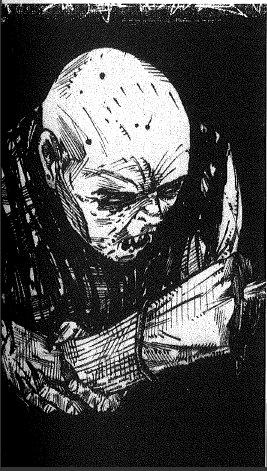
Orlok’s real weakness was just a rolled-up newspaper.
Step 5: Aspects
Basic ability scores in Everlasting are called “aspects.” There are 9 of them, and no, they don’t correspond to White Wolf’s. The normal human limit is 6 (with rare prodigies reaching 7) while the limit for eldritch is 12, though of course “some claim” they can reach higher.
The physical aspects, Strength , Dexterity , and Resilience , are exactly what you expect.
The mental aspects are Instincts, Intellect , and Perception . Instincts represents common sense, intuition, situational awareness, and “gut instincts.” Among other things, it factors into combat initiative. Intellect is the intelligence attribute, covering knowledge, memory, and problem-solving. Perception covers sharp senses and general observation.
The “spiritual” aspects are Inspiration, Presence , and Spirit . Inspiration represents creativity and imagination--you need it to perceive the supernatural, because this is the 90s and that’s the trendy cliche. Presence is the charisma attribute, covering charm, magnetism, and leadership, but not necessarily beauty. Spirit is the willpower attribute; it includes self-confidence, discipline, and mental fortitude, and is used to resist mental and magical assault.
Step 6: Abilities
The Everlasting has an interesting skill system. You want your 90s Design big-ass skill list? We got it right here. However, skills are grouped together into “Aptitudes.” There are 10 aptitudes containing 7 skills apiece; if you have Athletics 3, you automatically have all its sub-skills at 3, plus whatever points you want to spend on them individually.
The default, point-allocation method gives you 15 points for Aptitudes and 30 more points to spend on individual skills. If you wanted to play a lighter game, you could just play with Aptitudes.
Athletics : Accuracy, Acrobatics, Climb, Dance, Focus, Run, Swim
Criminal : Espionage, Firearms, Legerdemain, Murder, Security, Stealth, Streetwise
Humanities : Antiquities, Artistry, History, Language, Music, Religion, Research
Influence : Deception, Eloquence, Empathy, Intimidate, Persuasion, Question, Romance
Martial Arts : Blind Fighting, Block, Evasion, Grapple, Kick, Punch, Takedown
Melee : Axes, Clubs, Knives, Flails, Polearms, Staves, Swords
Modern Life : Alertness, Area Knowledge, Computers, Driving, Management, Profession (choose one), Social Awareness
Naturalism : Animals, Equestrian, Herbalism, Hunt, Orienteer, Survival,Track
Sciences : Engineering, Life Science, Mathematics, Medicine, Physical Science, Psychology, Rationalize
Supernatural : Arcana, Astral, Dream, Eldritch, Empower, Illumination, Intuition
As you can see, the groupings are goofy--”unarmed hand-to-hand combat” is a group, and so is “all the hard sciences and all branches of medicine and psychology.” I suppose this leans toward balance in a genre that is very much about dark urban superheroes punching each other, their trenchcoats and ponytails flapping in the wind.
Some of the individual skills may seem odd, and the game realizes this and explains them immediately. Is there a more detailed explanation of all the skills, later in the book? I don’t know.
Accuracy : throwing.
Focus : “Channeling internal energy” and controlling your body.
Murder : There is a specific skill for plotting and investigating homicide.
Question : Interrogation, including torture.
Social Awareness : Voting socialist. Just kidding! It means knowledge of current events, issues, and pop culture, very relevant to the setting.
Animals : Identifying, empathizing with, training, and tracking animals.
Orienteer : Navigation.
Rationalize : A specific skill for convincing mortals that they didn’t just see monsters dueling with katanas.
Arcana : Real-world mysticism, from astrology to Kabbalah.
Astral : Astral projection and navigation.
Dream : Lucid dreaming; traveling and manipulating the Dreamworlds.
Eldritch : Knowledge of eldritch races and the ability to identify them on sight.
Empower : Infusing magick into people and objects.
Illumination : Perceiving the supernatural.
Step 6: Distinctions
Distinctions are another aspect of the game that is interesting and unique, but of questionable value. Generally speaking, they’re a measure of your social standing within both mortal and eldritch society. They get weird when the game starts recommending that you get benefits and drawbacks based on your rating.
Your rating in a distinction can go from -9 to +9, and by default you have a +9 balance to divide among the 9 distinctions. The game doesn’t say that the rating is a straightforward bonus or penalty to any actions, and more importantly, it gives few guideposts on exactly what a rating of +3, -7, etc. means in the setting.
Biography essentially measures your effect on history and whether or not you’ve done anything meaningful with your life as far as the outside world is concerned. A positive rating could mean that you inspired a folk legend, or even that you were a historical figure (probably under an assumed name). A negative rating can mean that you are a literal folk devil, that you committed atrocities, or just that you’ve lived a reclusive life, and other eldritch see you as a naive hermit.
Eldritch ties is a measure of your connections and status with other eldritch, especially your own genos. A positive score means that you have friends, contacts, and respect, a position of authority, and a good reputation. A negative score means enemies, rivals, outcast status, or a reputation for being a low-down dirty snake.
Physique is weird and stupid. It’s a measure of your physical appearance and unusual physical characteristics, and doesn’t seem to fit in with the other, more “big picture” distinctions. A positive score represents health, beauty, an imposing appearance, and even odd physical talents, like contortionism. A negative score may mean that you’re ugly, unhealthy, disabled, disfigured, have poor hygiene, or have some particular physical disability, like being sterile. Tell me, when is that going to matter?
Psyche measures your mental, social, and psychological stability. A positive score represents intelligence, coping ability, strong convictions (in the form of Persona traits), and peculiar talents such as photographic memory. Negative scores indicate mental illness, unstable personality traits, and anachronistic behaviour. Like Physique, it seems that it tries to measure traits already covered by aspects and Persona, and admits as much.
Resources covers wealth and property, both mundane and supernatural. Positive resources can indicate not only money, valuables, and real estate, but rare assets such as state-of-the-art technology, priceless antiques, and restricted weapons. It also covers eldritch-related assets, like magical artifacts, a secure sanctum, or a dominion. “Wait,” you may ask, “does that mean if I’m broke, I can just take -9?” That’s a bad idea. A negative score can indicate that you’re not only broke and homeless, but deep in debt to both humans and eldritch.
Servitors are your servants, and how loyal they are. A good positive score indicates that your servants are numerous, skilled, loyal, and possibly supernatural creatures with unique abilities of your own. As with resources, a negative score doesn’t just mean you can’t find good help--it means you have servants you can’t trust, or former servants who have gossiped about you or are actively working against you.
Spirituality reflects your “attunement to your spiritual side.” Okay. A positive score indicates that you’re very spiritual, have some special destiny, enjoy good luck or literal blessings, or have strong ties to other dimensions. A negative score means you are “spiritually tormented” or have some special doom hanging over your head.
Supernature is not social; it’s a measure of your affinity with the supernatural. Again, something already well-handled by other rules. A positive score means that you are especially handy with or resistant to magick, that you lack one of the weaknesses common to your genos, some minor beneficial supernatural quirk, or that you are especially adept at passing for normal. A negative score indicates that you find it difficult to pass for a normal person, that you have no talent for magick, that you’re especially prone to the problems peculiar to your genos, or that you’re cursed.
Temporal ties measures your connections and status in mortal society (beyond the Igors and Scoobys that do your dirty work). A good rating indicates friends, supporters, contacts, social status, and a position of prominence in a social institution like politics, media, law enforcement, business, etc. A negative score means enemies, detractors, being a wanted criminal, or being targeted by an underground mortal group like a cult or an organized crime syndicate.
Besides the categories that just don’t seem to belong, here’s where distinctions get weird: The game recommends you use them as the base for a Benefits & Drawbacks system (analogous to WoD’s Merits & Flaws). Benefits and drawbacks are traits beyond your aspects and abilities, each of which are associated with one of the distinctions.
You can have both positive and negative traits for one distinction, as long as their value adds up to your value in the distinction. For example, if you have Biography +1, you could have both the Mythical Hero (+3) and Lengthy Absence (-2) traits. It also says that whatever bonuses or penalties you get should be equal to the value of the Benefit/Drawback. That’s all well and good in theory, but not only is it extremely vague and prone to abuse, Everlasting’s own examples don’t stick to it.
Some of the listed B/Ds (ha, ha) don’t mention any mechanical bonuses or penalties, and don’t give any advice on when to employ them. Others seem to throw them around at random. The physique trait Catfall (+1) allows you to make an Acrobatics test to reduce falling damage by 1 point per success, while Lost Eye (+1) gives a +1 difficulty to several skills. Okay, those stick to the bonus/penalty guideline--but what about the Psyche drawback Paranoia (-2), which gives you a Paranoid persona trait at 7?
I like the idea behind distinctions; PCs can’t ignore them the way they can neglect to buy social assets in many other games (including WoD games). There are some neat benefits and drawbacks, like True Love (which allows two people to share Destiny points) or Unique Anatomy (which grants things like flexible bones or a second heart). But using the former as a middleman to regulate the latter produces goofy results even in theory, and in practice the whole thing is very open to abuse, even by accident--a “beloved celebrity” benefit could give huge bonuses to a lot of rolls.
Step 8: Preternature and Magick
Innate supernatural powers are called “preternaturae,” because when this game needs a name for something, it goes straight for “cumbersome Latin.” Magick is a separate thing, because this game’s author is a Wiccan.
Ghuls, Reanimates, and Vampires refer to their preternaturae as Nekrosia, whereas Dead Souls call their powers Phantasmata. Again with the funky Latin. Magick is divided into Paths, from Voodoun to Neo-Shamanism to weird paths developed by and for eldritch. “All osirians, and only osirians, practice Ureret (osirian Ur-magick), the most powerful and pure magickal path known.” This book can’t shut up about the races it doesn’t even cover. Magick is covered in detail in Chapter 11, so I think we can leave it alone for now.
Protagonists get a default 30 points to split up amongst various preternature and magickal paths. Each genos also gets some powers for free.
Ghuls get Direction Sense, which not only grants flawless sense of direction but the ability to easily retrace steps, intuitively map surroundings, and even navigate other dimensions with shifting physical laws. They also have Enhanced Senses, Leaping (height/distance is tripled), regeneration, the ability to speak ghoul gibberish and the language of rats, and thermovision.
Revenants get Enhanced Memory, allowing near-perfect recall and photographic memory, enhanced senses, Heightened Grace (perfect balance even on a tightrope), regeneration, a sixth sense that detects spirits, and Abaddon get the reaper form--the ability to appear as a grim reaper, armed with a scythe that counts as “an empowered large polearm.”
Vampires? Vampires. They get body weaponry (fangs) which cause “debilitating damage,” enhanced senses, Heightened Grace, and regeneration.
Oh, it looks like they don’t even list the preternaturae here. We’d have to skip forward to another chapter to complete character creation, which isn’t necessary in Vampire: the Masquerade .
Step 9: Last details
First, level. Level in this game is, I think, just a dividend of your stats. You start off at level 3. Then come the derived stats. Speed is Dex/2. Life is your hit points, and equals Resilience+Strength+Spirit.
Last is Animus , your Magic Stuff Fuel. It’s Inspiration+Presence+Spirit. This is important because not only do all eldritch lose Animus each day, you automatically spend Animus to power your regeneration if you’re wounded. If you run out, you start taking 1 point of “insidious damage” every 8 hours. An eldritch with no Animus, having lost all Life to insidious damage, lingers helplessly in pain and weakness forever or until some kind soul gives you sustenance.
Sustenance ! Hey, that’s important. Ghuls gain sustenance by feeding on dead human flesh. A hand or foot is worth 1 point, a half-arm or lower leg is worth 3, chest or back meat is 5, thighs are 6, the head is 3, and organs are two apiece. I’m not going to calculate how much a single human body is worth, but the idea of of a ghul getting by on a diet of human feet is funny and gross at the same time.
Revenants feed by draining the animus right out of people, usually with a kiss. For every 3 points they draw, the victim ages one year (children just have their lifespan shortened). Revenants can also feed on plants and animals, though they don’t enjoy it and it isn’t worth as much. Destroying an acre of crops (by kissing an ear of corn?) grants 1 animus, killing a large and ancient tree nets as much as 5, and feeding on animals grants 1 per year the animal is aged, so you could get by quite well on stray cats.
Vampires gotta have human blood. It works out to a point of animus for each point of “insidious damage” inflicted through blood loss. Draining half or more of a mortal’s animus makes them into a “drone.”
Mortals, who are listed for the sake of comparison, restore animus through eating, sleeping, and meditating.
Torments: the Downward Spiral
Hey, that would make a good title for a White Wolf game. Anyway, “Angst and self-torture are a part of existence that the everlasting cannot escape.” Jesus wept. Each genos has a Torment, and each Protagonist’s Torment rating starts at 3, which can go up and down during legendmaking. Giving in to Torment gives you Destiny points or some other benefit, but your Torment score increases. When it hits 13, you’re completely consumed and become an unplayable character, most like a “short-lived antagonist.”
You can add your Torment score to a test when it’s appropriate, but that automatically increases it by 1. The Guide can also decide to arbitrarily fuck you over by requiring you to test your Spirit against your Torment. If you fail, you “give in to your dark urges.”
Ghuls’ torment is Degeneration . Most ghuls eventually become more animal-like in both mind and body until they’re just beasts of prey.
Revenants’ torment is Detachment . Most have little or no connection to the living, or even with their own kind, since they’re just haunting a body. Most feel very alone and that loneliness eventually breeds callousness, cynicism, and even cruelty.
Vampires’ torment is Damnation . They’re constantly aware of their dark side; they have to literally feed it to sustain themselves, and it always wants more blood, cruelty, and evil. Vampires who resist damnation gain a sense of “nobility and tragic heroism” and probably sparkle.
Destiny points are Plot points that you use to help your Protagonist. You start the game with a pool of 10. You can also spend them to succeed at rolls, or even to alter major plot points in your favour.
1 DP (ha, ha) nets you an automatic success--that’s the only purely mechanical use. You can spend 2-7 DPs to alter anything from a minor detail to a major event drastically in your favour; a pool of unspent DPs is a license to wreck the story the Guide was planning. Hm, on second thought, maybe White Wolf should have used this
The Guide is expected to award 1 DP to everyone each session, with up to 3 for especially good contributions, and up to 7 for doing something that greatly benefits the group “such as buying pizza for everyone.”
The other way to get DP is by killing fellow eldritch, because here we are! Born to be kings! We’re the princes of the universe, in a world with the darkest powers! The phenomenon is known as the Rapture, and the killers get to divide up the victim’s BP however they like--it really isn’t explained on a setting level.
Backlash points are bad karma you get from violating the laws of magick, nature, or what the Guide thinks you were supposed to do. “It is almost a ‘you reap what you sow’ law for the Secret World, (though some of us believe it affects people in the Real World as well).” Christ on a spike. The Guide, after giving you BP, can spend those BP to turn your successes into failures or hit you with temporary or permanent bad luck or curses. Any character can also spend the Backlash of any character they’re acting against.
All protagonists, except dragons, start with no Backlash points. Dragons start with 30 Backlash points, and fuck you Stephen we don’t give a flying fuck about the fucking dragons that aren’t even fucking covered in this fucking book, okay?
Gaining Backlash from magick is dumb because, get this, you get Backlash from using magick to hurt someone who doesn’t deserve it. So there are no evil wizards, I guess, because they all backlashed themselves to hell. Ghuls gain a Backlash point from intentionally touching a living human with their bare skin, while revenants and vampires gain a point for killing someone by feeding.
Guides are downright encouraged to use Backlash for legendmaking. “Whining about Backlash being unfair is pointless, since it is meant to be unfair.” There’s a chart telling the Guide what they can do with spent Backlash points, from spending 1 point for a temporary Dementia 2 Persona trait, up to 13 points for a permanent, serious curse.
Experience points aren’t the same as Destiny points. There are a couple paragraphs devoted to saying that powergaming and getting all the points in all the cool stuff and all the cool artifacts and shit really isn’t what the game is about, but the only important thing is for everyone to have fun and keeping the characters balanced against each other. Protagonists should get 1-4 experience points per session and 2-7 at the conclusion of a storyline. Protagonists should also be required to explain (verbally or in writing) how they’re improving a trait with points.
After the experience chart is an example of character creation. The mark in question is Michael Von Prankh, a Christian knight who became a vampire in the 1400s. He has long blonde hair and a light beard and moustache, and green-grey eyes, and he’s very handsome.
The details of Michael’s character sheet are too boring to write down, but the last page of character creation comes with some amusing suggestions. One is to keep a journal written from your Protagonists perspective, in order to “develop a deeper understanding” of the character. Because to hell with my fiancee and my free time and any serious writing I might want to do, I need to work on my relationship with an imaginary vampire swordsman. “Keeping a protagonist journal is extremely creative,” we are told, because it’s always creative to do what a book tells you to do, and fanficcers are extremely creative people.
After this is some no-brainer advice on describing your protagonist’s aspects and skills in terms of what they are actually like and how they were educated. Then comes the recommendation that the PCs should remain mysterious to one another, and keep their character sheets secret.
I’m going to be as brutally honest as I can: The character creation section reads like its intended audience is the gamers you used to hang out with at the gaming store, the ones who are perpetually underemployed and unwashed, who devote hours and hours to their RPG characters because they have nothing else in their lives .
Next time, on The Everlasting : “Basic Guidelines,” because only fascists insist on rules , man.
Basic Guidelines
Original SA post
Chapter 3: Basic Guidelines :
The Everlasting is the most pretentious game I’ve read, but it is amusing, even when it glosses over basic character stats in favour of quantifying Joseph Campbell. That said, the rules chapter makes me angry. It offers you the choice of three different resolution mechanics, a bunch of extra rules, and typical 90s complexity underneath. Like the introduction, it moves me to pity for anyone whose first RPG purchase was The Everlasting. Both chapters are too busy pontificating about imagination and casually throwing around ill-considered options to explain basic concepts in a straightforward manner, and the organization of topics is consequently scatterbrained.

Do you believe people really eat chocolate-covered grasshoppers?
The cover page for chapter 3 explains that The Everlasting has no rules, only guidelines. This is explicitly to stick it to rules-lawyers and roll-players . The chapter proper begins with a two-page glossary of rules jargon. Besides simple terms like “action” and “difficulty,” it includes campaign jargon like “chapter” and “module,” and highly specific stuff like “debilitating damage.” I’ve never had a game confront me with a rules glossary before explaining how to roll dice. Turns out it’s a shitty idea.
The Everlasting allows each player to choose their own means of task resolution: cards or dice. If you use dice, they’re d12s. If you use cards, aces are worth 1, jacks are worth 11, queens are worth 12, and kings are usually worth 0. Cards are the standard; several optional rules rely on them.
Either way, the basic mechanic is a pool system. You draw/roll a number of cards/dice equal to your Aspect. Any that come up (Difficulty-Skill) are successes. Let’s say you’re chopping off your enemy’s ponytail with your katana. If you have Dexterity 5, Swords 3, and the difficulty is 9, then you draw 5 cards, and anything higher than 6 is a success.
(The standard difficulty of 9, but there is a difficult chart ranging from 5 for “nearly effortless” to 18 for “virtually impossible.” That’s a meaningless guideline in a game where starting characters are badass immortal monsters.)
If that sounds too simple, don’t worry! There are a bunch of advanced and optional rules to make basic task resolution a living hell.
An optional rule is different dice . In this system, children roll d6, mortals roll d8, supernatural mortals roll d10, eldritch roll d12, and “extremely powerful” eldritch roll d20. I guess superhuman stats and magickal powers aren’t enough.
The Everlasting system has disasters , which are a ripoff of White Wolf’s botch rule. Every 1 you roll/draw subtracts a success, and if you pull more 1s than successes, you fuck up royally. Getting -1 success means humiliation or a minor injury, while -5 successes means you seriously maim yourself and injure your friends in the process.
Extended actions are kind of vague. You have to keep making rolls as often as the Guide demands until you get the total number of successes you need, and a disaster negates your progress.
Combined actions are pretty simple. Everyone gets to roll, and the highest number of successes counts for the group. The Guide can give you a circumstantial bonus or a penalty; it’s easier for 3 people to work together on a house than on a car engine. Makes sense.
Then there are contested actions , which is the fucking worst. The worst. The basic rule for it is simple; unless one of you is getting a situational bonus or penalty, you both draw/roll against difficulty 9, and the highest number of successes wins. However, by default every contested action is subject to gambling and bluffing .
Whenever there’s a contested action, anyone can bet 1-3 destiny or experience points on who will win; before any cards are drawn. Then the two contestants draw their cards and put all but one of them face-down on the table. You can look at your own cards and spend a destiny point to redraw one or two cards. You can spend up to 2 DP this way, and once a particular card is redrawn you can’t redraw the new one.
Every single combat action is a contested action. Not since Phoenix Command has a game worked so hard to drive the ratio of realtime-to-game-time so high.
A very important advanced rule is The Mystical Thirteen . Long story short: You can choose to spend 1 DP before you roll to increase the number of the largest number you roll. A 7 becomes 8, etc. But if you roll a 12 or draw a king, instead of the 12 being 12 and the king being an automatic failure, they’re worth 13, which has “great mystical significance.” You get to choose one of the following benefits: 5 successes on this test, the ability to alter the story as if you’d spent 3 DP, or three free successes you can “hold” and spend any time during the course of the story.
Even more complicated is Double or Nothing. Whenever you roll a success by drawing a queen, you can choose to draw one single card--a success doubles your successes, and a failure loses you all your successes. If you drew an ace, that’s an automatic disaster. If you once again draw a queen, you can try to double or nothing again, up to three times.
Combat Guidelines
Combat is part of “mythological adventure” so The Everlasting has a detailed combat system “to keep the legendmaking running smoothly.”
A round is called a combat cycle, which lasts approximately 12 seconds and is split up into 10 turns. (This is the only game I’ve ever seen define the length of a combat turn at 1.2 seconds.) The Everlasting uses a timing system to determine actions, with the character’s Speed attribute determining how often they can act. Many actions require more than one turn, so you can keep track of whether or not one character is still diving and rolling for cover when another begins their action.
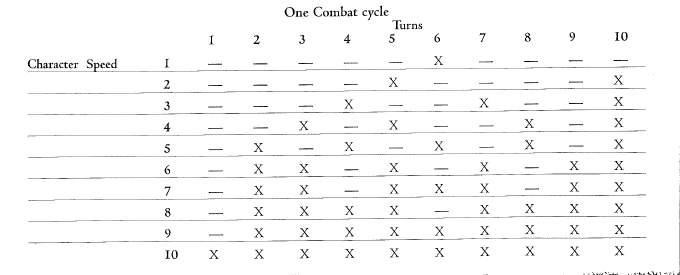
Initiative is also complicated and terrible. The game actually leans toward allowing one party to ambush another unless they were honestly expecting a fight, and warns you not to “abuse Initiative” by expecting a stand-up fight. If the ambush is successful, the entire party gets a free action.
Initiative, as you saw, works on a countdown system. All the characters acting in a given turn declare their actions in order of least to greatest Instincts. Whenever you’re attacked, you can trade your next action to make an active defense, giving you two extra cards/dice.
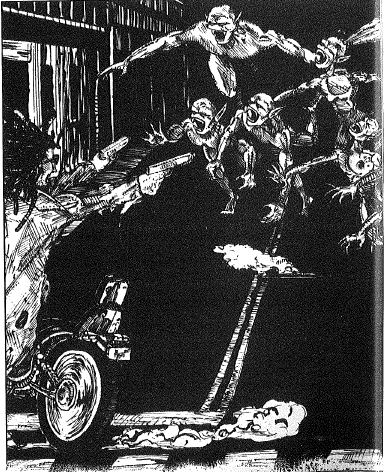
Before you ask, I have not seen any rules for motorcycle legs.
Basic combat resolution is not that complicated, per se. Once again, the problems creep in when you start using the advanced rules and the stupid bidding system. Remember, every attack is a contested action and by default subject to the bidding system.
For hand-to-hand combat, the attacker rolls Dexterity/Weapon skill, and the defender rolls Dexterity/Block or Evasion. The most successes wins.
Ranged combat is more complex. It seems they stole their conception of how ranged combat should work from the Storyteller system; dodging is based on cover and movement, with fuzzy guidelines on how much cover characters have or whether they count as moving while they’re doing other shit. If you’re behind cover, you get 0-8 dice based on how much, and roll against difficulty 7. If you’re moving, you roll Dexterity/Evasion with the difficulty based on whether you’re charging, running away, diving for cover, or running in an “evasion pattern.” Running always costs 1 turn, but diving for cover costs 0 and is basically a free defense roll. (But wait, you say. What if I’m moving and I have cover? Answer: Shut up.)
Without running it myself, it appears the net effect is that ranged combat is very powerful, because while unskilled characters won’t be able to hit anyone who isn’t a sitting duck, at high levels attack will quickly outpace defense, just like in Storyteller.
After resolving attacks, any net successes for the attacker are added to the weapon’s damage. The defender gets to roll Resilience (or Spirit to defend against magick) against difficulty 7 to reduce the damage, unless the damage is insidious. So that’s what that means.
If you lose more than half your total Life points to a single attack, you must make a trauma roll. Fail, and you’re knocked out. Even if you succeed, you now have to make trauma rolls every time you take damage.
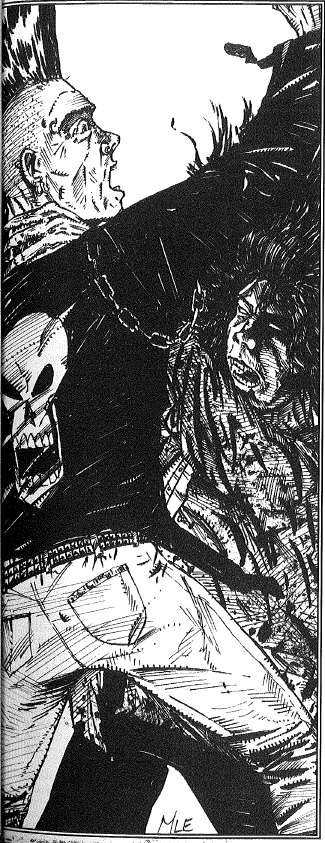
This game comes down firmly on one side of the goth/punk divide.
There’s a full page of situational modifiers for melee and ranged combat. These range from the simple (higher ground, invisibility) to the hard to adjudicate (flank attack, “firing while moving quickly”) to ones I’m surprised they thought of (fighting while swimming, extreme temperatures). Like just about every single game I played in the 1990s, the situational modifiers can make combat much harder for whoever doesn’t have the GM’s favour. Unlike, for example, Masterbook or later-edition D&D, there’s no maneuvering system for applying status effects to enemies. It’s up to the Guide’s discretion to decide that you’re fighting in close quarters, in the dark, from lower ground, with poor footing, while retreating quickly.
The melee weapon chart has a bit of mechanical intricacy I actually like. The average difficulty to hit with weapons is 10, but some are slightly harder or easier, and some give a bonus or penalty to the person dodging them. (I haven’t run the math, but I believe the differences in difficulty aren’t as drastic as in the Storyteller system, where knives were “broken” due to their low difficulty.)
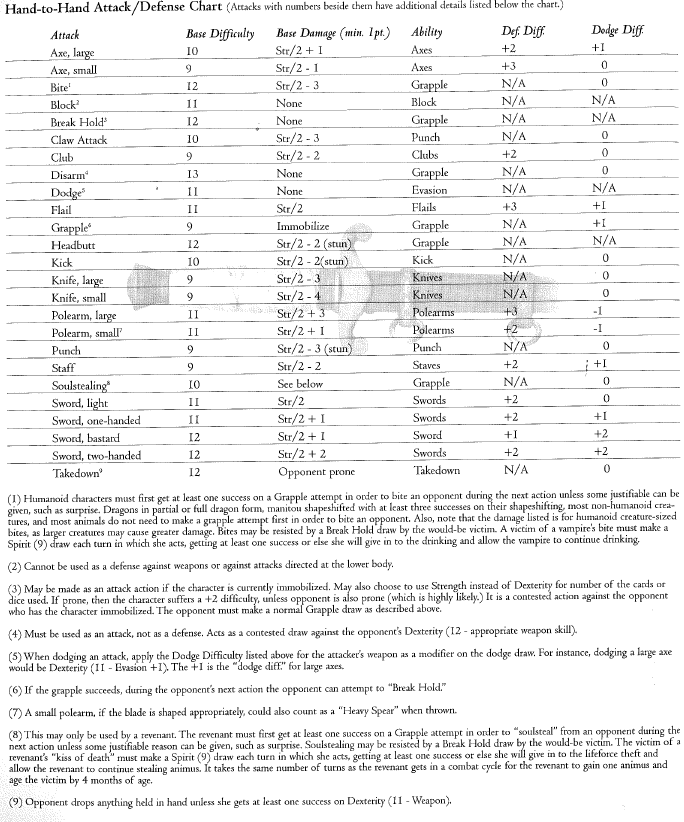
Pretty sure no other game has “soulstealing” on its weapon chart
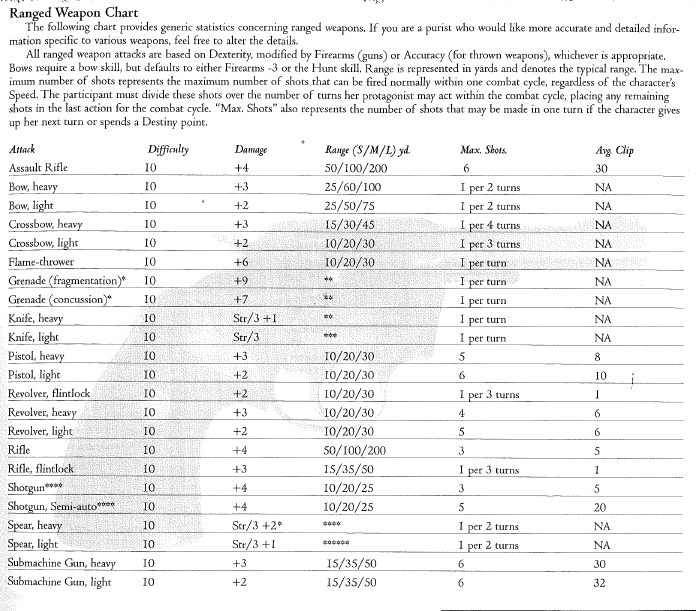
The ranged weapon chart isn’t so realistic as to track individual calibers. The base difficulty is always 10, and ranged weapons have limits on how often you can fire them over a combat cycle, regardless of your Speed.
However, after the weapon charts comes a very very bad rule, “ Unloading .” If you give up your next action or spend a Destiny point, you can fire as many shots as you normally could in one cycle, in one turn. So if you have Speed 10, on the first turn of the cycle you could fire 3-6 bullets depending on your weapon. This game doesn’t have “autofire” rules; every shot from an assault rifle is an individual attack.

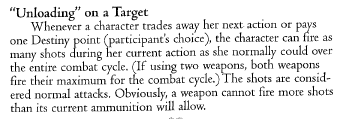
This rule is also terribly written; as you can see, I have to go back and forth between the weapon chart heading and the rule itself to figure out what it means. If I have Speed 10, does that mean I can fire 6 bullets on turns 1, 3, 5, 7, and 9?
Either way, the way to win combat in this game is to have a gun, be skilled with it, ambush your target, and completely unload on them. I suppose that’s “realistic,” but I doubt it’s the result of playtesting.
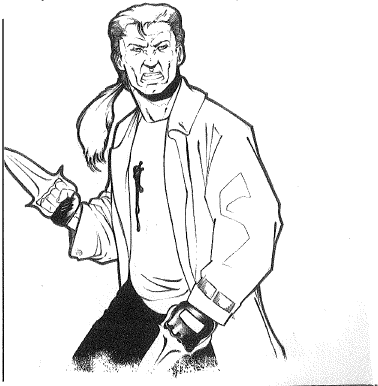
90sactionhero.jpg
After all these rules on killing people, there’s a section on using medicine to heal them. All the unliving have Regeneration (2), meaning they regain 2 Life at the end of each combat cycle, including the ability to regrow limbs and such. We also learn about their vulnerabilities and what can actually kill them.
Some things, such as magickal weapons, cause debilitating damage to the unliving, meaning they only heal one point every 2 minutes. Each genos also has ways to die the Truth Death--lose all your Life to certain kinds of harm, and you’re dead, dead, dead.
Ghuls have the least to worry about on this front. They take debilitating damage from fire, and they can die the True Death by fire, decapitation, having their heart removed, or being eaten alive, which is no small risk in the ghul world. Revenants take debilitating damage from fire and silver, and can die the True Death by fire, decapitation, silver, or being eaten alive. Vampires are the most vulnerable. They take debilitating damage from fire and sunlight, and can die for realsies-no-dealsies from fire, decapitation, sunlight, or being eaten alive.
Next comes the rules for wound penalties. It’s simple; you get increasing difficulty to all actions when you lose a quarter, half, and three-quarters of your Life.
Percentiles ! Holy shit! After all that, wedged completely out of order near the end of the chapter, there’s a whole page on using percentiles instead of cards or dice pools. Fuck you, Everlasting, I’m not even reading it, nor will I spend a page ranting on how to integrate it with gambling and bluffing and all those other stupid kludge rules.
Tarot Cards in The Everlasting
You’ve been waiting for this. Don’t lie.
The rules for incorporating Tarot into your game are not nearly as dumb as I expected. I thought it was going to be an alternative to using standard playing cards for task resolution, prompting the Guide to be “imaginative” in interpreting results such as “You stab the ghoul with your katana and do (draws) Moon damage.”
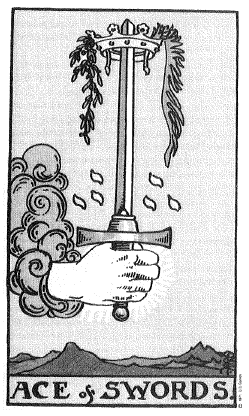
Ace of Katanas not pictured.
You certainly can use the Tarot cards in place of playing cards, by removing the Pages and letting the Knights replace the Jacks. However, “The major arcana represent the portion of the tarot that makes the biggest impact upon legendmaking.” After separating the major arcana, each player draws three. They can play these at any time to temporarily take control of the plot.
In theory, playing major arcana puts the player in the Guide’s seat for a moment. In practice, they’re very limited in what they can affect.
Thematically, “a card must be played in a manner such that what it symbolizes is central to how the participant affects what is going on.” Fair enough. You can’t play the Death card to heal yourself or get a lifetime supply of candy. But they also “cannot alter the entire plot drastically or impact other characters negatively without their controllers’ permission first.” As far as mechanical benefits are concerned, “The major arcana cannot be used to boost scores, alter card draws, or otherwise affect guideline mechanics.”
So what can they do? Well, the book only gives one example.
The Everlasting posted:
For instance, if a participant decided to play the Tower, she might have her protagonist become bound by some addiction, or have him and his fellow protagonists become entombed in a catacomb they are currently exploring.The participant might also point out a supporting character’s self-destructive behavior a nd suggest that it should somehow lead to her demise. The participant might have a supporting character get captured by the antagonist, or have a willing participant’s protagonist suffer some personal tragedy. She might even have her own protagonist fail in an attempt to save some innocent bystander, resulting in the bystander’s death and the protagonist suffering long-term guilt.
Apparently, The Everlasting expects you to use Tarot cards to arbitrarily instigate a subplot that fucks over your PC. Oh, here’s another quote. “Those who use their major arcana to disrupt the legendmaking or simply to glorify their own protagonists can receive Backlash points or have their cards’ effects nullified, if the Guide wishes.”
The rest of the Tarot section is sermonizing on the history of the Tarot and its usefulness as a “tool for self-exploration,” along with a page of associations for the Major Arcana.
The very end of the chapter is a few pieces of gaming advice. There’s a bit more drivel about “developing your personal mythology,” but most of it is common sense. Don’t metagame, work together with the other players, don’t solve everything with combat, and take the initiative instead of reacting.
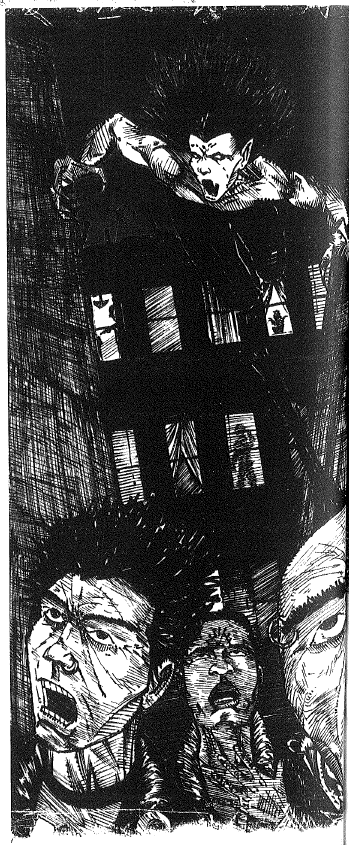
Hey Dave, there sure is a lot of static electricity in this alleyway...Dave?
Am I the only one with the mounting suspicion that The Everlasting is, well, a fraud? Yes, the rules seem poorly-playtested, and yes, the combat system is too detailed, but those are forgivable. The thing I can’t stand about The Everlasting is that despite its interminable rambling about the imagination, creativity, and personal mythology of the Protagonists , all the rules in The Everlasting come down firmly on the side of the Guide as all-controlling auteur.
Ethos? Can’t change it without the Guide’s permission. Persona traits? High ratings are presented as desirable, but mechanically, they only come into play when the Guide wants to take control of your character. Destiny points? They’re truly only useful for boosting rolls and strokes of good luck, not altering the direction of the plot. Tarot arcana? They get their teeth yanked so you explicitly can’t do anything the Guide doesn’t like.
All of the legendmaking rules in this game are really sticks for the Guide to beat you with if you’re not roleplaying--sorry, legendmaking --in accordance with their vision. The rules for Backlash points are quite explicit about their role as a tool for the Guide to punish players.
Oh, and all that radical alternative GMing stuff in the introduction? Those things chewed up a lot of pagecount in Chapter 1, certainly, but they haven’t been mentioned since. How do all these legendmaking rules and the final authority of the Guide work with “communal protagonists” or when the duties of the Guide are split among multiple people? I have a feeling the answer is that they don’t, because the author never had to deal with it. I’d bet money that those ‘innovations’ are methods that Stephen C. Brown would like you to experiment with, but damned if he bothered thoroughly playtesting himself. It’s probably hard to find a gaming group when you can’t shut up about Wicca and Tarot and Joseph fucking Campbell.
Next time, on The Everlasting : To all the ghuls I’ve loved before.
Art Interlude
Original SA post
A brief interlude: The art of Everlasting
All the art you've seen so far is from my copy of the original first edition. I wanted to give credit where it's due and show you some samples of the revised PDF.
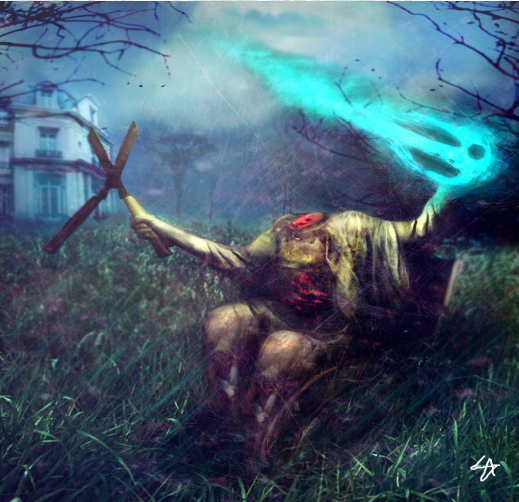
What is this I don't even
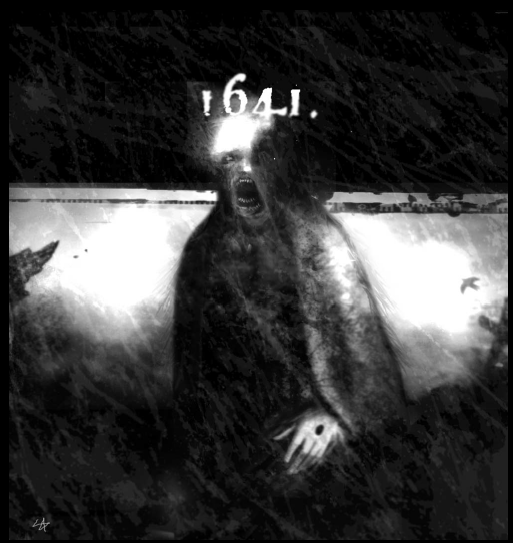
The weight of history.
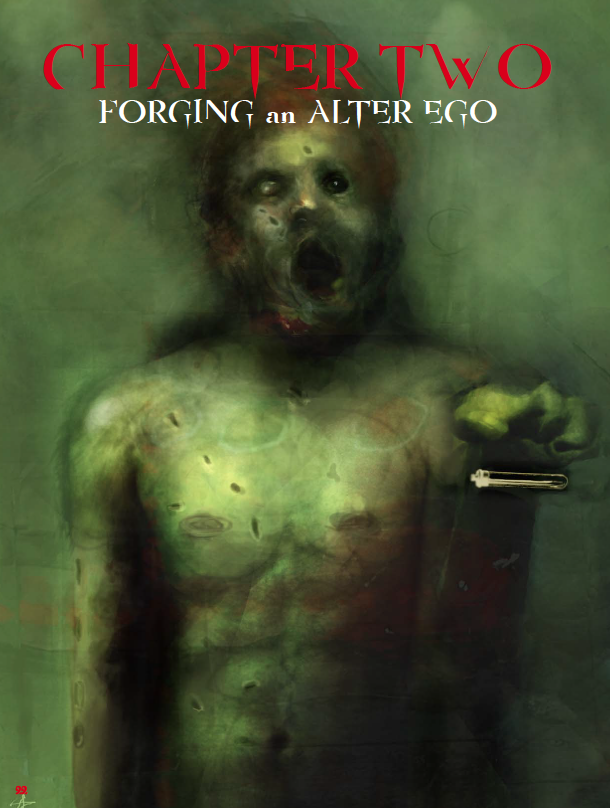
Rub some lotion on it.
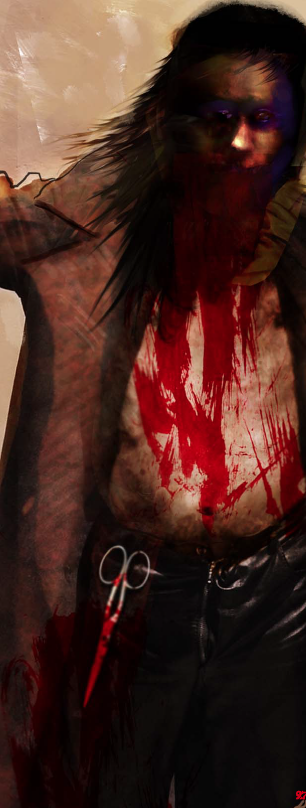
I told you not to run with those.
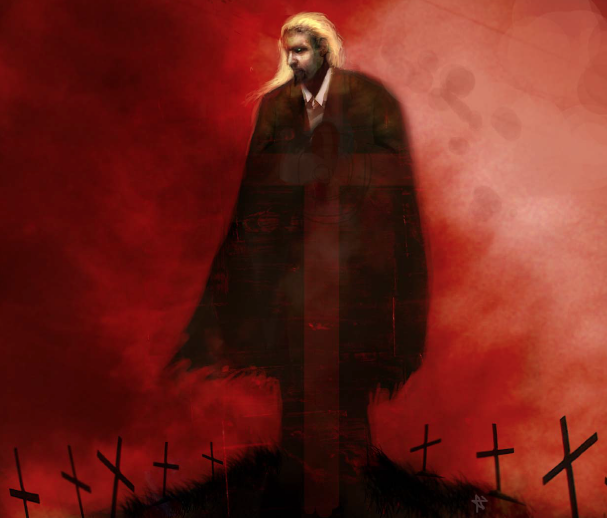
Hellsing!
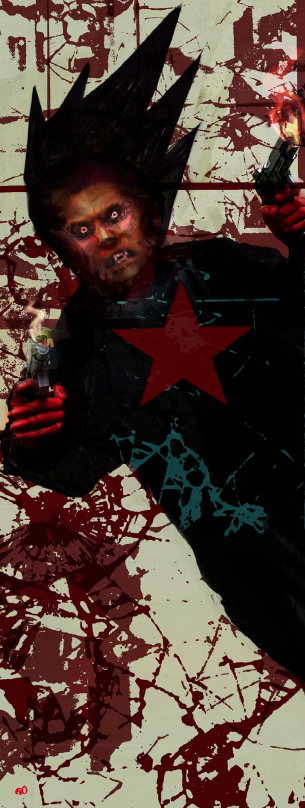
Commie Hellsing!
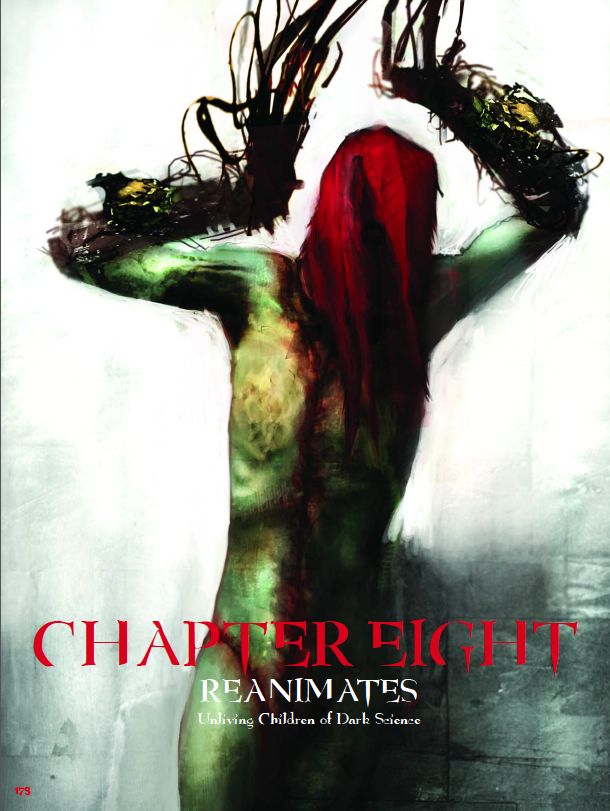
Your poison womb is making Heaven too fucking crowded.
It's not the bestest art in the whole world, but I like the Ben Templesmith + Hellsing Ultimate look.
We're only like half done with the book, but the sloggiest parts are done, I believe. Unless I hear otherwise, I'm going to do Dune: Chronicles of the Imperium next. UA was more popular, but I didn't realize it has a huge thread devoted to it. Some other stuff I'm considering doing is a bunch of Eden Studios and Masterbook.
Cyphoderus posted:
Loises are named after Lois Lane, while Tituses are named after Titus Andronicus.
Ghul Talk
Original SA post
Chapter 4: Ghul Talk
The ghul chapter opens with references to Lovecraft and Bloch, which is pretty boss. It also has 2 sidebars full of ghul-specific jargon, but the 90s giveth and the 90s taketh away.
References aside, ghuls are not a subhuman species in The Everlasting . They’re humans who received immortality by drinking an alchemical elixir called Anecro. Most of them were ignorant of the raw deal they were getting, no pun intended.
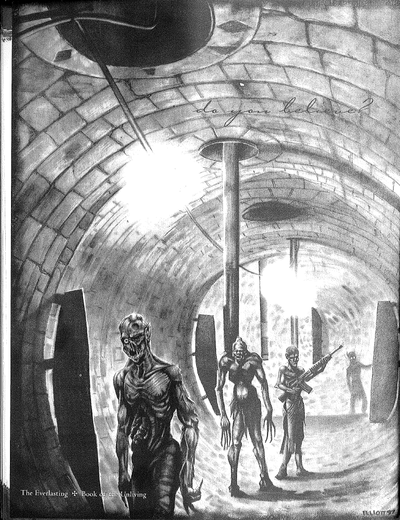
Do you believe I missed this Fallout 2 level on the first playthrough?
The first ghul was an ancient alchemist and utter douchebag named Azazel. He thought he stole the secret of immortality from demons, but they punked him, and the elixir he made turned him into a ghul. Azazel was so bitter that he deliberately seeded occult texts with lies and the formula for Anecro, to trick more alchemists into becoming ghouls. He intertwined his formula with the Hermetic lore of the osirians, which really pissed them off, and it’s rumoured that they’re torturing him for eternity.
The pattern of ghuls duping more mortals into drinking Anecro continues to the modern day, so ghul society is still based on fraud and victimization. Anecro itself is an amber liquid that smells like jasmine and tastes like honey, so a hapless ghoul-to-be has every reason to believe it was made by an Indian restaurant and not a corpse-eating wizard. Anecro induces a process called Metastasis, which inflicts slow, agonizing death and turns you into a ghul.
Ghuls must eat human flesh. If they don’t, their bodies rot and their minds degenerate, until they become twisted, mindless beasts. All ghouls smell like corpses, especially their breath. They have enlarged hands, feet, and ears, and their nails become sharp black claws while their teeth gradually fall out and are replaced by big sharp ones. Many are hunchbacked. Their senses become sharper and their bodies, especially their legs, become much more powerful. When ghuls don’t eat enough carrion, rot comes in the form of peeling, blotching, running sores, and a combination of hair loss and unusual hair growth. Ghuls who want to fit in on the surface wear gloves and carry weapons to avoid touching people, and mask their stench with perfume and breath freshener. Subterranean ghuls are filthy motherfuckers who steal clothes from corpses and wear them until they fall off.
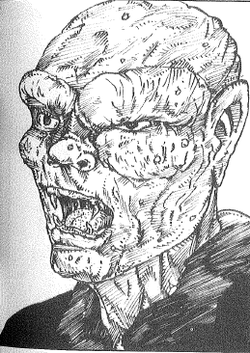
Yes, I tried putting ice on it.
About 60% of ghouls are bhutas; typical ghouls. They can remain physically and mentally stable for a long time, but almost all of them degenerate eventually. Faitours are ghouls who received exactly the right dose of Anecro. Their Metastasis is completely internal, so they appear completely human. Faitours excel at tricking humans into becoming ghuls, not telling them that most ghuls aren’t as lucky as the faitours. Grotesqueries are ghuls who took too much Anecro, and are consequently monstrous and deformed as a result. They’re stronger and tougher than other ghuls, with thick rubbery hides and weirdly knotted muscles. Most of them stay in their burrows and feed on buried corpses. Vetala are ghuls who got especially good Anecro, and consider themselves superior to other ghuls. They become taller, stronger, and smarter, but they can only feed on thoroughly rotten meat. Vetala usually either become pack leaders or seclude themselves in study. Last are the mindless ones, ghuls who have degenerated into corpse-eating animals through hunger or consuming a “bad batch” of Anecro. Other ghuls use them as pets, but some become lone hunters. Most are afraid of the surface world, so mindless ghuls killing humans is a rare occurrence.
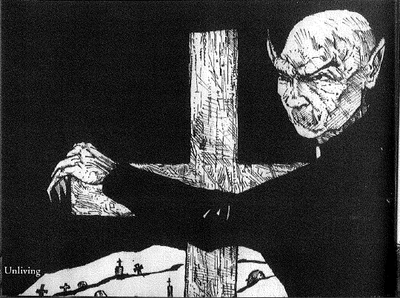
I’ll put up my Christmas decorations when I fucking please.
Ghuls live in a vast realm of underground tunnels called the Catacombs , and they come to the surface world to steal corpses or hunt people for food. When they’re not prowling for food, they spend their time studying what they call the Secret Arts , a mixture of alchemy, Western occultism, and weird science. Ghuls are not spiritual, but they are fixated on death and mortality. No one knows why, but ghuls are fascinated by death and usually have a completely morbid sense of taste. Some ghuls even commit torture and murder or stage accidents for entertainment. Faitours in particular are fond of building houses on the surface world which are chambers of horrors, full of hidden passageways and traps. They kidnap mortals and use drugs and magick to turn them into crazed, deformed, obedient slaves. Then they kidnap more hapless humans, setting them loose in a house-of-horrors full of gimp slaves.
One of ghuls’ Secret Arts is skincrafting, which allows them to take on a human’s appearance by wearing their skin like a suit. It doesn’t solve the problem of their repulsive stench and breath, but their body does reshape itself to fit the skin, and ghuls are masters of voice mimicry. They can still be given away by their eye color, or by the grossly-stitched seam running down their back.
Few ghuls live more than a few centuries before dying the True Death, usually by degenerating into mindlessness and being eaten by fellow ghuls. When a ghul is truly dead, their
Ghuls must consume about 10 pounds of flesh every day. Technically, they can subsist on a diet of raw animal meat, but it tastes horrible. They can’t stomach any other food besides water, blood, and embalming fluid. Ghul senses are generally enhanced, but with a number of peculiarities. Not only do they have thermal vision, they can navigate in complete darkness by their own body heat. They can hear like a dog, have an innate sense of direction, and can estimate the lifespan of mortals just by looking them over.
Ghuls suffer Degeneration when their hunger gets the better of them, drowning out their own thoughts. In game terms, they become incredibly hungry when they have 3 or less animus, and have to make rolls not to attack the closest living thing for food. If it drops to zero, they gain a point of Degeneration. Whenever they gain a point of degeneration, Faitour gain 2 points in a Dementia quality while other ghuls gain a monstrous physical feature, ranging from things like peeling skin and festering boils to things like growing extra digits, twisted limbs, or horns and hooves.

If I only had some brains
Ghulish culture, such as it is, consists of colonies of a few dozen ghuls, divided into packs with a few members each. Packs are lead by the toughest ghuls, and they basically put up gang signs to mark out their territory--every ghul wants a den with emergency exits, proximity to graves, sewer access, and secret caches for storing food. The most significant cultural touchstone for ghuls is the Grimoire of Abraxas , a combination Ghul Bible and Being A Ghul for Dummies . It contains origin stories, wisdom supposedly passed down from Azazel, the basics of ghulish alchemy, and a guide to the Underworld. It also contains five ghul laws: do not create more than one ghul per year or have more than three “children” living at the same time, do not directly harm the living, do not live on the surface, protect your own kind, and only the strongest ghuls may lead. Only the last one matters.
The history of the Catacombs begins in the early Roman empire, when ghuls dug hundreds of miles of catacombs near the roads outside the city. They struck a deal with mortal politicians to protect Rome in exchange for Christians and Jews being buried in the catacombs for the ghuls to harvest. The Catacombs are now so old and so extensive that they criss-cross entire continents. In fact, part of the reason that ghuls are not spiritual is that the Underworld is a place they can physically walk into, simply by delving deep enough. Below the Catacombs is the “Deep Below,” a dangerous realm full of things that don’t like ghuls.
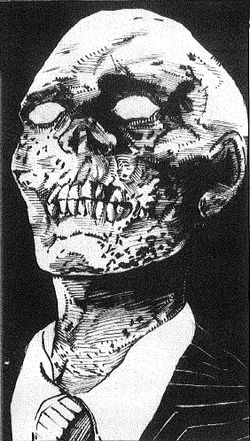
I’d like to diversify my holdings. Specifically, the women locked in my cellar.
Closer to the Underworld, the setting suddenly becomes Tim Burton’s Dungeons & Dragons. Beyond the Deep Below is the labyrinth-city of the Iblis , a mysterious race of pseudo-ghuls who control access to the Underworld. They have coal black skin, big eyes, pointy ears, short skinny builds, black clothes, a slave labor force of all kinds of monsters, lots of magick, and an underground kingdom of their own. Sound familiar?
The iblis demand a silver dollar for each soul passing in or out of the Underworld. There is an untouchable caste of ghuls called ghaddars who do business with the iblis and the dead souls of the Underworld. They kidnap mortals and sell them to the iblis or to revenants looking for a host body. They bring in guns and ammunition and bring out magical metals and materials harvested from the bodies of Underworld monsters. Some ghuls like the Underworld so much they decide to stay there, which is pretty awesome, actually. Ghuls can eat ghost food, live in ghost castles, fight ghost monsters, work for ghost governments, fuck ghost whores, marry ghost brides, and adopt ghost kids. It’s so great I don’t know why all the cool ghuls don’t move there right now.
The vast majority of ghuls have little or no contact with other eldritch besides ghosts. They’re indifferent or disdainful towards most of the fantastical or heavenly races like angels, questers, elves, and dragons, and don’t particularly care for other undead, either. They’re mostly interested in other subterranean races, like dwarves and orcs.
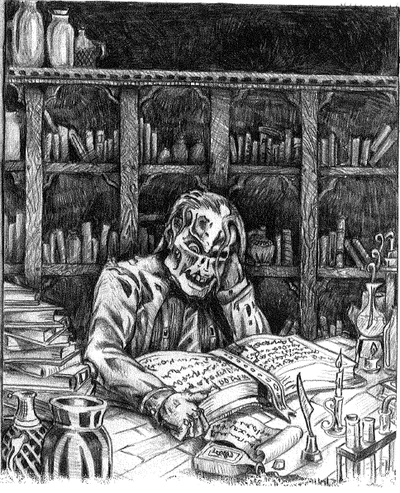
Let’s see, Saturday: Youth group breakfast, Iron Maiden cover shoot, spin class
Ghulish magick isn’t covered here, but along with a rehash of ghul character creation, we do get a list of Nekrosia (innate powers) for ghul characters to buy.
Eyes of the Dead : By eating a corpse’s eyes, you can see what they saw in their last few minutes of life.
Ghastly Quickness : Permanently increases Dexterity.
Hand of Death : You can kill mortals with a touch.
Hidey Hole : You can sense the best hiding place nearby, and hide supernaturally well.
Horrid Potence : Permanently increases Strength.
Lifescent : You can “smell” the auras of living things and “read” something about their personality.
Meat Hooks : Your claws become long, hooked daggers.
Quickdig : You can burrow fast enough to travel 5 yards per turn.
Rat Master , Roach King : You can summon hordes of rats or roaches. They don’t do much damage, but they’re hard to kill.
Rubbery Hide : You gain permanent armor, but your skin becomes a hide with welts and blotches.
Slip Away : You simply vanish from attempts to guard or pursue you.
Vomitory Attack : You attack people with acid vomit made of liquid corpses.
The chapter wraps up with some scant advice on roleplaying ghuls. The game admits that by and large, ghuls are filthy, depraved, disgusting creatures with few redeeming qualities, and that any ghul PC will have to be an exceptional case. On the other hand, ghuls are the only undead who don’t have to hurt people to feed, and they’re the only eldritch who can cross back and forth between the mortal realm and the Underworld. Some suggested stories for ghul characters are trying to become human again, finding Azazel, or having completely Underworld-focused adventures. I don’t think they thought this through.
Let me end this chapter by complaining about how difficult it was to summarize. There’s no legendmaking bullshit, but the organization is terrible. I now realize that they put big glossaries at the beginning of every chapter so that you’ll understand what the book is discussing as it drifts from topic to topic. The bridge between a section on ghulish culture and the history of the Catacombs is broken up by a page on magick. Once the sidebar is done with glossary terms, it just keeps going with setting information, so half the chapter is now in running sidebars for no good reason. I finally settled on summarizing the info page-by-page, then cut-and-pasting paragraphs and trimming redundancies. Let’s hope the layout guy--sorry, illumination administer --was awake and sober for the next chapter.
Next time, on The Everlasting : The walking, talking, wrestling, legendmaking dead.
Revenantin`
Original SA post
Chapter 5: Revenantin’ :
The chapter on revenants begins with a reminder that to many superstitious cultures throughout history, burial rites are very much about ensuring that the dead stay dead. It links these superstitions to a belief in “psychic vampires” and in people who return from near-death experiences but seem to be completely different people. I’m impressed. This is a much more original starting point than just ripping off The Crow.
That being said, I’ve got to knock this chapter for scraping the bottom of the barrel for its White Wolf style quotes. The good: Sandman , The Invisibles , and two apiece from Lovecraft and Poe. The bad: Two from an obscure novel named They Thirst , one from Poppy Z. Brite, and one from Man-Bat. Yes, Man-Bat. The ugly: Two from The Crow 2: City of Angels and one from Bloodlust: Subspecies 3 . The psychic vampire element got my hopes up for quotes from Carrion Comfort and “The Transfer,” and instead...well, I got the answer to the question “What kind of person wrote this book?” Someone who watches horror movies on HBO at 4:00 in the morning.
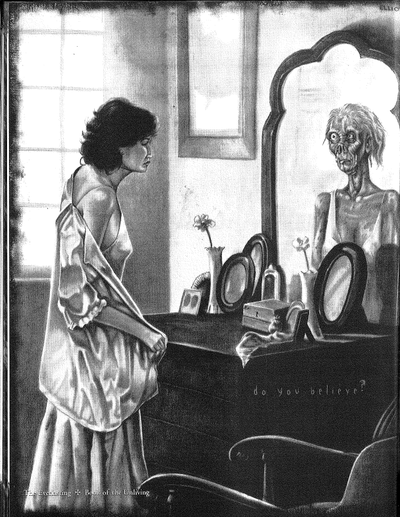
Do you believe I drank five of those fucking things? What did the bartender call it? A corpse reviver?
So. Revenants. When mortals die, sometimes their souls are condemned to the Underworld. I don’t see why that’s a big deal, since we’ve already established that the Underworld is where all the coolest ghuls hang out, but...I suppose the grass really is always greener on The Other Side. Revenants are condemned souls who escape from the Underworld by grafting themselves to a soulless human body. They stalk the “living lands” as undead predators, sustaining themselves by draining years from the lives of mortals.
The most basic division among revenants is between sarkomenos, those who reanimate dead bodies, and ekimmu, who possess living ones. They aren’t different kinds of spirits, it’s just down to your...choice of venue, so to speak.
Sarkomenos, or cold-bloods , become revenants by returning to the world as ghosts and reanimating a dead body--not necessarily their own. The grafting process undoes the work of time and the undertaker, but a fresh corpse is easier to reanimate than an enbalmed, rotted, stitched-up one. Cold-bloods are indeed cold-blooded, and they don’t need food, sleep, or air--just the lifeforce of their victims.
Ekimmu, or warm-bloods , become revenants by possessing a living body whose owner has been ripped out and forced to wander the Underworld in the ekimmu’s place. There are several ways for condemned souls to find their way into a suitable body, including pacts with mortal sorcerers and mad scientists. The only method that is fully explained is dealing with the ghaddars, the outcast ghuls who traffic fresh bodies and kidnapped mortals into the Underworld so that dead souls can inhabit them and return to the “living lands.” The ghuls are “paid handsomely” for their services, but with what? It doesn’t say. Maybe if you believe the theory that Casper is Richie Rich’s ghost...in any case, ekimmu are warm-blooded and alive, but in addition to draining lifeforce, they need to keep eating, breathing, and sleeping to maintain their immortal bodies.
Revenants drain life from mortals by touching them, usually with a kiss. This causes an extremely pleasurable high for both the revenant and their victim, and it’s the most intense sensation revenants can experience. They call this soulstealing , despite the fact that it doesn’t harm the victim’s soul--it drains years from their lifespan and causes premature aging. Mortals who die this way crumble into dust--far less troublesome than a rotten or bloodless corpse.
Like other unliving, revenants lose animus points daily, which they must regain by soulstealing. It takes a year of mortal life to sustain a ghoul for a single day. They can also feed from animals, even trees or acres of crops, but this is far less nourishing and not satisfying in the least. If they run out of animus, they age rapidly and fall into a coma, with their mind fully aware and trapped in an immobile body.
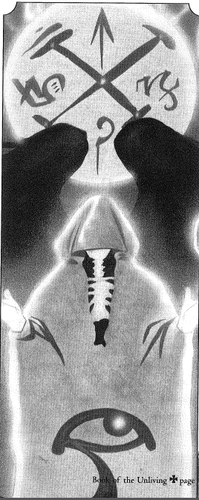
My third eye is rolling itself at this game.
Revenants can die the True Death by decapitation, silver weapons, or being torn to shreds. Like the other unliving, when a revenant dies there is a totally-not-the-Quickening-from- Highlander event. Their body crumples to the ground while the condemned soul remains standing, temporarily visible along with any other bodiless spirits in the room. They get the chance to deliver a parting monologue before fading back into the Underworld, and any living creatures present absorb their stolen vitality, becoming younger. If there are any grim reaper spirits nearby, they’ll appear as vague silhouettes to grab the errant soul and drag them kicking and screaming back to the Underworld, which is definitely not a rip-off of Ghost .
All revenants are naturally pale and gaunt. The atrophy of their internal organs makes them even more pale and gaunt, and if they don’t feed, they become more, you guessed it, pale and gaunt. That said, they are usually very attractive, because why wouldn’t you pick a body that’s young and fit? Revenants dress in “ever-so-sheik” (sic) styles and blend in with mortal society, but they’re also supposed to prefer all-black clothing with black lipstick and black nail polish. (Is it just me, or did White Wolf and its imitators do this a lot? “These people are rich and classy and blend into high society, except when they dress like club kids.”)
Both cold-bloods and warm-bloods gain access to the memories of the person whose body they’re inhabiting. This makes it easier to take over their host’s mortal life, which many of them enjoy. It’s one of the principal ways to stave off Detachment, the revenants’ form of Degeneration. You see, although revenants clawed their way back to the land of the living to experience life, they have a hard time enjoying it. They perceive the decay in everything, and when they look in the mirror they see themselves as if they’d been rotting in the grave. Soulstealing is such an intense high that ordinary pleasures pale in comparison. They throw themselves into careers, relationships, studies, and other activites to regain that spark of life, but nothing is ever quite enough. Detached revenants become increasingly bored, depressed, lonely, and isolated, and often commit terrible crimes just to feel something. If their Detachment maxes out, they commit suicide in a fit of insanity, and their soul descends deep into the Underworld, never to return.
Revenant culture is supposed to be vicious and Machiavellian, and it is, but the basic setup is very simple. The worldwide revenant community is the “Kingdoms of Night,” divided into domains with major cities as its focal points. This system was set up by the Old Ones, the revenants who have been around for at least 500 years. The Old Ones also created six laws. They themselves are above the law, because no one can discipline them without starting a war over it.
1: Protect the secrets of the dead. Revenants know all kinds of shit about spirits and the Underworld, but they’re not telling you. Revenants are poorly understood by other eldritch--many think they’re just some kind of psychic vampire--and they like it that way.
2: Respect the Court of Night, which is made up of the Old Ones and the rulers of the revenant domains.
3: Keep the existence of revenants secret from mortals.
4: Only kill mortals to protect yourself or your assets.
5: Never kill another revenant.
6: Do what the Old Ones say, or else.
About half of revenants are part of the Salariat, meaning they align themselves with a particular kingdom and intrigue against each other for power and influence. The how and why is not explained. Many other revenants are renunciates, meaning that they refuse to participate in revenant politics, but for practical reasons they still have to obey the laws. About a tenth of revenants are part of the Ankou, also called the Abaddon, a cult of grim reapers. They hate other revenants, they have a special power that lets them appear as grim reapers, another one that lets them sense mortals about to die, and only feed by draining the last bit of life from them. I find them boring.
Revenants prefer living in large cities, since they need people to prey upon. Cold-bloods prefer homes that are large, private, intimidating, and close to cemeteries, and often summon spirits and undead to serve as their minions. Warm-bloods prefer homes that are opulent and comfortable, and use mortal or faitour minions. Revenants can empower mortal minions with superhuman strength and the power to see ghosts. Unlike other unliving, almost all revenants live alone. It says that revenants enjoy manipulating mortals and are rarely hurting for money, but we’re not told why they should have an easy time amassing wealth.
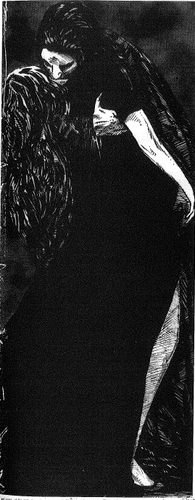
Our braces are stuck again.
Revenants don’t have much contact with other eldritch, except for other unliving. They have a wary respect for vampires--in fact, they have a sort of extradition agreement with them; a revenant who harms a vampire (or vice versa) is judged by their peers as if they’d harmed their own kind. They regard ghuls as minions to be used and discarded, and generally despise the holy eldritch such as angels and questers.
There is a little section telling us that especially Detached revenants sometimes make their lairs into a “chamber of horrors” where they torture and terrorize mortals, much like faitours. We already know that evil revenants commit terrible crimes, so I don’t know why every chapter needs to give us what seems to be a special dispensation for a slasher film or a dungeoncrawl.
In addition to the innate powers described in previous chapters, here are the Nekrosia that revenants can buy:
Adumbration : Produces a cloud of total darkness rising from the ground.
Call the Black Storm : Changes the weather into a terrible spooky storm.
Corpse Candle : Creates an eerie will-o'-the-wisp that lures mortals and eldritch.
Deathly Grandeur : Permanently boosts Presence.
Ephemeral Speed : Permanently boosts Speed.
Gravewalk : With a simple touch you can induce a terrible chill.
The Keening : You can emit a terrible wail that induces intense despair.
Mesmerism : Mind control with simple commands.
Mindsight : You can read surface thoughts.
Mirrorgate : You can walk into one mirror and out of another “anywhere in the vicinity.”
Poltergeist : Telekinesis.
Shadow of Death : You can merge with the shadow of a passing person or object and travel unnoticed.
Spectral Armor : Permanently boosts Resilience.
Zombie Mastery : You can animate corpses to serve you.
The section on roleplaying revenants emphasizes Detachment, and on the way revenants see everything as being in a process of decay, though that’s not supported with rules or even with any thematic powers. Suggestions for a revenant campaign include fighting the Abaddon or other races of eldritch, wars within the Kingdoms of Night, or trying to become human again--which makes little sense, since you already lived a mortal life. Perhaps you could earn your way into a better afterlife, but you gotta buy another book for that!
Next time, on The Everlasting : I wonder if Stephen Brown caught this one on TBS .
All the Damn Vampires
Original SA post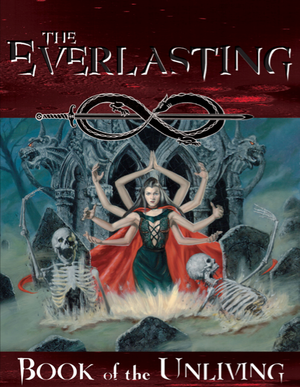
Chapter 5: All the Damn Vampires
This chapter has been a long time in coming, and not just because of the holidays. You see, while the ghul chapter is 19 pages and the revenant chapter is 15 pages, the chapter on vampire PCs is a sprawling, side-bar laden 45 pages, and it gets more than its fair share of character options, pointless jargon, and the art budget.
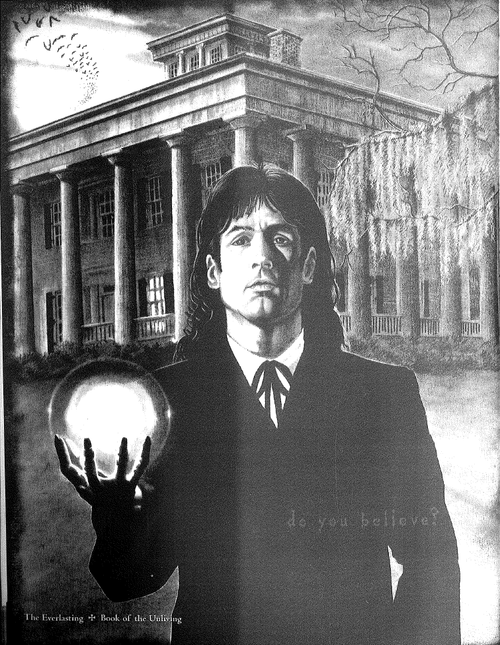
Do you believe Todd wore a string tie to the semiformal?
The intro page is the same appeal to stupidity to which we’ve grown accustomed. Do you believe in vampires? The Catholic Church blamed them for the Black Death, dontchaknow. There are medical conditions like porphyria that are kind of like vampirism. Lots of people like reading stories about vampires. “Have you not hoped that Lestat is real?” Yes, that is really a sentence in this book.
The most important thing to know about vampires--more meaningful than their lineages, political factions, cool powers, or the one hundred and four bits of vampire jargon littering this chapter--is that they’re the elves of the Everlasting setting. By which I mean they are immortal, beautiful, sensitive, sensual, cultured, and better than you at everything, but they’ve got angst because...well, a norm like you could never understand. Vampires call themselves “dark angels.” It doesn’t say why, but probably because that sounded impressive in ancient Sumeria, and again in 1992. When a mortal becomes a vampire, they shed most of their internal organs and body fat, becoming very lean, very pale, and androgynously pretty. Their senses are supernaturally sharp and precise, and they can shout like a megaphone or speak so softly only other immortals can hear them. They’re supernaturally strong, tough, and dextrous, immune to disease, heal rapidly, and don’t need to breathe. They have excellent, infrared night vision, and their eyes turn cool inhuman colours when they’re excited. It even says that they all have great hair and nails.
All this for the low low price of sleeping at least 4 hours a day, staying out of the sunlight, and drinking human blood.

A willing victim, or a cleverly disguised tree?
Blood ? Let’s talk about that. Vampires need blood from living humans. They can feed on animals, but that’s like a heroin-addicted food critic getting by on a diet of methadone and plain oatmeal. So vampires develop tastes for feeding in particular ways, from particular arteries, or from people of a certain sex, age, race, etc. Some prefer virgins.
Vampires lose 3 animus per day, and get 1 animus point for each pint of blood they drain. They don’t need to kill their victims (a dab of their own blood will rapidly heal the wound they create) but most do. Victims who are exsanguinated to death simply die, while those who lose most of their animus but survive become drones. Drones become nocturnal, infatuated with the vampire, and uninterested in their own lives. They recover in a week, unless the vampire feeds regularly. Some vampires learn how to communicate and control their drones telepathically, using them as pawns.
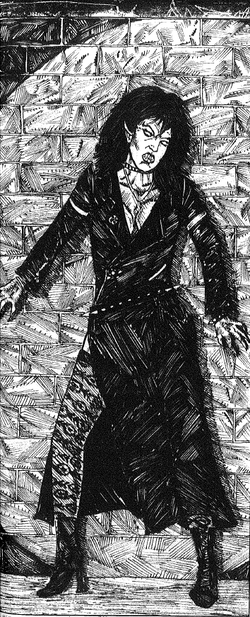
Don't be afraid to show a little femoral.
Vampires have a Blood Potency system, and while it may seem like a ripoff of Vampire: the Masquerade , it’s actually a rip-off of the way things work in Anne Rice’s vampire books. Blood Potency increases with age, or by drinking enough blood from a more potent vampire. Blood Potency decreases when a less potent vampire drinks your blood, or when you create a new scion. Drinking from a stronger vampire is addictive. This creates a dynamic which is absent from Vampire . You can create and enslave weaker vampires to serve you, but this will eventually strengthen them and weaken you until they have as much Potency as you
While you don’t have to sleep more than four hours a day, vampires feel weak and tired for as long as the sun is in the sky, so most of them sleep through the day. (If you spend a few days underground, like say you’re hanging out with your ghulbros, this problem goes away.)
Having a stake lodged in your heart will put you in a coma until it’s removed. It doesn’t have to be a wooden stake, either; a knife or an arrow will do. Decapitation does much the same: your head and body will shrivel, but put ‘em together and they’ll seal right up. Now, being eaten alive by such as a ghul? That’s a true death. Torn to ribbons? That’s a true death. Vat of acid? That’s a true death. Fire and sunlight? First you smolder, then you burst into flames, then you
A vampire’s not-Quickening causes every living thing in a quarter-mile to feel a deep sense of peace as the vampire’s soul goes to the afterlife. This seems pretty weird if the vampire is dead because you were chopping him up with an axe and screaming “Die motherfucker die!”
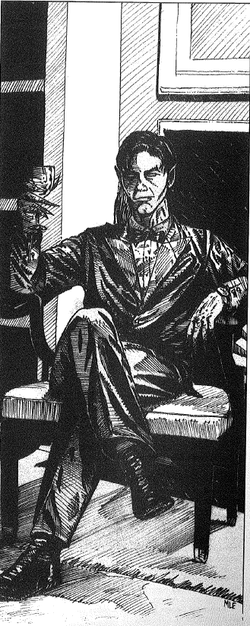
For a relaxing time, always make it Suntory time.
Vampires’ particular Torment is Damnation. It’s impossible to be a vampire without doing evil, but at the same time, you can’t just discard all the beliefs and values from your mortal life without losing your mind. We’re told that most uphold a weird code of honor where they practice “honor among thieves” with other vampires and won’t commit outright betrayal.
Damnation starts at 3, and if it reaches 13, say good-bye to your character sheet. Damnation plays into the Aspect system, too; as it increases, you must add points to some appropriate trait such as Hedonistic or Killer Instinct.
Many people have criticized Vampire: the Masquerade ’s Humanity system for being simplistic, but the rules for Damnation are much more vague. A vampire gains a point when they “give in to inhuman depravity beyond their current experience” but can make a Spirit roll to resist their urges. When Damnation reaches 13, the vampire has lost all hope, or they will “go underground for a very long time...to find a way to destroy herself.” Since any vampire can commit suicide by watching the sun rise, I suppose that means the vampire wants to commit suicide, but doesn’t have the nerve. In any case, it’s clearly inspired by the part of the Vampire Chronicles where Lestat, overcome with guilt, retires to a decaying mansion and allows himself to wither away.
Vampires are supposed to be creatures of “inner conflict, tragedy, beauty, damnation, loneliness, self-denial, self-delusion, violence, cruelty, boredom, guilt, and estrangement...intense passion and contrast: loving yet destructive, monstrous yet beautiful.” Yes, seriously. But Damnation is merely an awkward attachment to the Aspects rules, and it serves as a stick for the Guide to beat you with for not roleplaying the way they think you should.
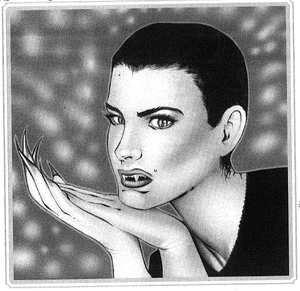
Each vampire bloodline has its own cultural heritage, but the ecumenical vampire culture is sketchy at best. It’s similar to that of the revenants, and the vampires participate in the same “courts of night.” (In fact, vampire fashion is exactly like revenant fashion: we’re paradoxically told that they dress in trendy clothing to fit in with mortals, but oh yeah, most of them wear all black and their taste in accessories leans toward blood-red rubies, silver, occult symbols, and swordcanes.) The book tells us outright that vampire culture is like a social club for privileged, smart, beautiful serial killers, and that their society is all about power-plays. Besides their country club drama, most of them maintain more-or-less normal lives and careers, despite the fact that they can’t conduct ordinary business during ordinary business hours. There is a strong assumption, sometimes explicit and sometimes unspoken, that all vampires are rich, urban, and attractive.
So why do vampires act like characters from American Psycho with high school drama? To “relieve the tedium of immortality,” which is another way of saying “for no particular reason.” This is another example of the authors assuming and hoping you’ll roleplay your characters a certain way, but without giving you much reason to do so, either in the rules or in the setting. You should play your vampire PC as a catty, amoral, neurotic brat because that’s the way they act in the books and movies the writers have been watching.
Necromancy and consanguinity, unliving in perfect harmony
And now we get to the real reason this chapter is longer than three others put together: The consanguinities . Ghuls come in four varieties, revenants have two varieties and three factions, but vampires have not only three subtypes but 12 major bloodlines, each of which gets at least a full page. It’s ironic how poorly this space is used. Many of the consanguinity writeups elaborate too much on the history of their founder--in 1993, I could look up Vlad Tepes in my school library. Every writeup says that, although the consanguinity may have its roots in one country, it has members of all races and nationalities. They all list at least half-a-dozen occupations as common for that consanguinity, which almost always includes either “wealthy dilettante” or “cult leader” or both. It’s as if the author was scared that you’d be afraid to make an atypical character if he didn’t give you his express permission. The White Wolf writers never had to worry about that!
Genitors , also called the self-cursed, are vampires who were not created by another vampire, but were damned by some higher power by committing atrocities. It’s extremely rare, but possible, for people to become self-cursed in modern times--butchering hundreds of people just to watch them die is given as an example of something that might be evil enough. Genitors get their name from the fact that if they create more vampires, they have founded a new consanguinity. The genitors of the existing lines are a matter of legend. But if one dies, their weakest descendents will either become mortal or die themselves, depending on their Blood Potency. (Exactly how humans can become damned to vampirism, and what power does the damning, is a mystery. Vampire legend points to some sort of “Dark Prometheus” who stole a twisted version of immortality from the gods.)
Scions are your standard vampire, created by another vampire draining them dry and then feeding them vampire blood. Being transformed into a vampire this way causes drastic personality changes--in rules terms, you add up all your Persona trait points and reshuffle them, possibly gaining and losing some traits in the process.
Dhampirs are mortals who became vampires by drinking vampire blood. The weakest need a steady supply, but once their potency increases their vampirism sustains itself. Dhampir need to eat, sleep, and breathe in addition to drinking mortal blood, but they look human, and sunlight is only a mild irritant.
And now the consanguinities. Yes, they’re called “consanguinities.” It’s clunky, but remember that the building blocks of Everlasting are Joseph Campbell, Carl Jung, Shlock Horror, and Bad Latin.
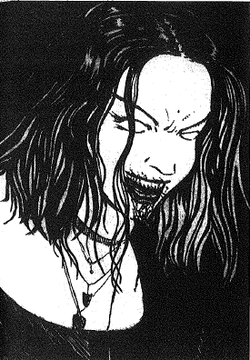
Brain Waster? This whole game is a brain waster.
The Bathora are descended from Elizabeth Bathory, who became self-cursed by torturing, starving, and killing more pretty young girls than Paris Fashion Week. They’re friendly with the revenants, hedonistic, and their claim to fame is being the sole possessors of Blood Magick, which allows vampires to do things like temporarily appear human or withstand sunlight. Some of them are cult leaders or wealthy dilettantes. On the other hand, they have two particular weaknesses: holy water and holy symbols burn them with aggravated insidious debilitating damage, and they don’t have fangs, so they carry picks and razors for feeding.
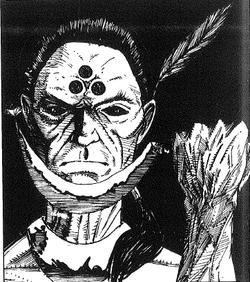
Step out of my parlour, paleface.
Cihuatateo is one of the most interesting bloodlines. They’re descended from Ai Apaec, the “decapitator god” of the ancient Peruvian Moche people, a very real and thoroughly brutal culture whose religion emphasized human sacrifice, torture, and sexual slavery. The Cihuatateo are up to their necks in the drug trade and other black-market activities, but they’re also known for their vast libraries of books in anthropology, the occult, and magick. Some of them are cult leaders. They have red points in their pupils, and the oldest Cihuatateo start growing multiple red-black eyes up their foreheads, like a giant spider. In game terms, Cihuatateo get free points in a Magickal path, and they are vulnerable to blessed mirrors and the blessed blood of a virgin child, which is probably less worrying than what their mafia rivals are packing.
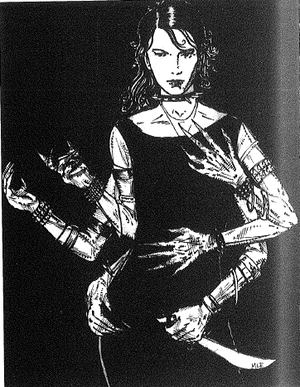
Be a dear and pass the thalidomide.
The Dakini are descended from the goddess Kali, and were the founders of the Thuggee cult. They are “cult leaders, assassins, artists, terrorist leaders, religious scholars, doctors, healers, fortunetellers, architects, inventors, necromancers, and dark scientists.” See, this is the kind of all-over-the-place crap I was talking about. Anyway, all of them still have a creepy assassin vibe, and they like to live in lairs with bones and antique weapons and depictions of Kali everywhere. Dakini kill people without compassion, but they swear an oath to serve humanity as a whole. Many of them are involved in the war against the demons. (Yeah, remember that big metaplot discussed in the introduction, which provides an easy reason for PCs to work together, but which this book has totally ignored throughout? Yeah, that.) Their weakness is that they have to keep a piece of human bone on them at all times; many embed it in their body. They get free points in Intimidate and Melee. “Melee” is not a skill in this game.
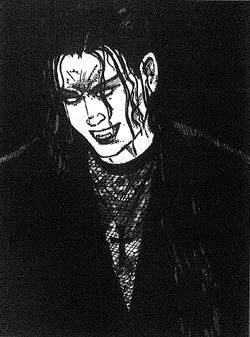
Ha! Ha! I’m wearing my mom’s pantyhose!
The Dracul are descended from you-know-who, and I don’t have to tell you his backstory. After becoming a vampire, Dracula instigated a centuries-long period of war among vampires called the Age of Lamentations when he declared war on several other bloodlines so that he and his scions could gain mad XP from drinking all their blood. (The novel Dracula was actually a coded message announcing to the world that Dracula had finally been hunted down and killed.) As a result, the Dracul are widely despised not only because of the wars but because because relatively young vampires with high Potency makes them noveau riche among bloodsuckers. Anyway, the Dracul writeup is particularly obnoxious about stating that the Dracul are very diverse; some live in covens while some are loners, many are all about manipulating mortals while some don’t care, and so on. Some of them are cult leaders. In game terms, being a Dracul isn’t so great: They get Strength +1, but have several weaknesses in the form of shadows that move about independently, appearing translucent in mirrors, vulnerability to holy water and symbols, and needing to sleep with Carpathian earth in their coffins.
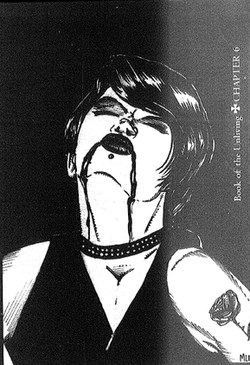
Vampire duckface.
Kingu are weird. Their legendary origin comes from a vampire who was worshipped as Tammuz in ancient Mesopotamia, but their schtick is devoted to the narrow subsubgenre of “horror movies based on circus freaks.” Kingu keep to their own kind, in traveling carnivals and spooky museum-of-horrors lairs. Some of them are cult leaders. The Kingu even control their own alternate dimension called Hubur, which is full of strange freakish creatures. (This raises the same “Why don’t they just move there?” question as with the ghuls and the Underworld.) Kingu get weirder and more twisted as they age. Rules-wise, Tod Browning’s Kingu get a +1 to Supernature, and must have a physical deformity or mental illness. They’re vulnerable to garlic.
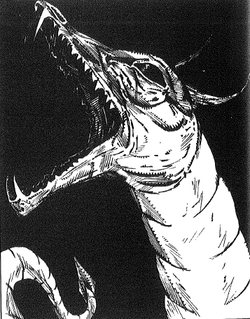
No. Enc.: 1d6 (2d6)
Alignment: Gothic
Movement: Wicca
Attacks: The Patriarchy
The Lamia are descended from the Greek mythological queen, who was transformed into a child-eating monster. The Lamia are almost entirely female, and cluster together in wealthy, aristocratic covens. Some of them are cult leaders and most are wealthy dilettantes. All Lamia spend a few nights every few months and a couple of months out of the year transformed into giant white worms, winding their way through tunnels underneath their coven houses. Their genitor is still around, and spends most of her time in worm form. They get a bonus to Dexterity, and the ability to transform into worms for their Arrakis National Guard duty is both compulsory and free. They’re vulnerable to saint’s blood, holy relics, and wild rose petals.
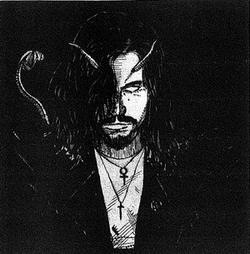
Isn’t Dave Navarro devilish enough already?
Lilim are descended from the mythological Lilith, and are believed to be part demon. They’re known for fighting both for and against demons. Lilim is possibly the oldest consanguinity, and they have a reputation for being knowledgeable about spirits and vampire lore, and their lairs are full of priceless ancient artifacts. Many of them have one or two demonic physical oddities, like horns or a tail. They get a bonus to Arcana and Illumination, and their only particular weakness is to certain Kabalistic magic.
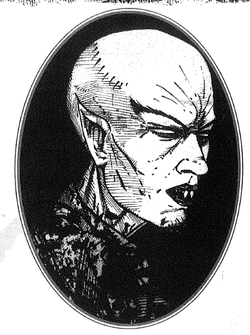
Ugliest locket in the thrift store.
The Nosferatu are descended from Czernobog, the “black god” of Slavic myth, which is the rationalization for them all looking like Count Orlok. Nosferatu experiment with disease, and their gnarled, ratlike, rigored appearance is believed to be the result of an experiment gone wrong. Besides this, their schtick seems to be a complete and total ripoff of the Nosferatu in Vampire--they keep company with rats, live in tunnel networks, and control mortal information networks from a distance. Some of them are cult leaders. All Nosferatu have the advantage of looking like, well, Nosferatu. They get a bonus to Resilience, complete immunity to disease, and the ability to temporarily make their face appear normal.
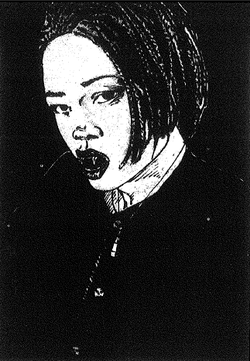
Blood’n’Pepa.
Obayifo are African vampires with a reputation as voodoo masters, shapeshifters, and cult leaders. They’re descended from a zombie master who led a bloody reign of terror across much of Africa many centuries ago. They usually congregate in religiously-oriented covens, and keep zombie servants. Ironically, though they spent centuries ruthlessly lording over Africa, many of them believe in protecting Africa from foreign exploitation. They get a free, unique Obayifo magickal path, and their only particular weakness is to certain African traditional magics.
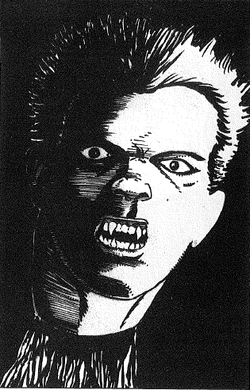
Cyberpunk was a terrible album. Get over it.
The Penanggalans are the scions of a Malaysian sorceress who sought redemption, but was killed and cursed to never find peace before she could do so. Only mortals with strong psychic potential can become penanggalans, and many of them are scholars, psychic detectives, or wealthy dilettantes. They aren’t numerous, but they’re spread all over the world. They can learn the unique ability to detach their limbs and control them telekinetically. They get a bonus to Spirit and Empower. Penanggalans are vulnerable to jeruju leaves, thorns coated in human blood, and particular Malaysian magics.
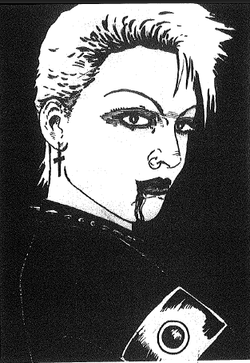
Her eyebrows weren’t fit to survive.
The Tantalusi are a line of cold, hard bastards who follow a weird code of ethics wherein they cull the human population to promote “survival of the fittest.” They act as a peacekeeping faction among vampires and have been the architects of many political achievements in human and vampire society, stretching back to ancient Rome. Their founder was the mortal son of a daeva who wanted immortality for himself, and achieved it by practicing depraved acts of cannibalism until he became a vampire. He’s supposed to be still locked in a hellish alternate dimension where the daevas imprisoned him as punishment. They have a history of being judges, lawyers, architects, historians, economists, bankers, entrepreneurs, artists, writers, philosophers, and teachers, but not wealthy dilettantes or cult leaders. Tantalusi are even more pale than most vampires, and some have stark white hair and brass-coloured eyes. Animals find them unnerving, and Tantalusi can be incapacitated by placing a knotted rope on their sleeping body; they’re compelled to untie all the knots, giving you plenty of time to kill them. They get a bonus to Influence.
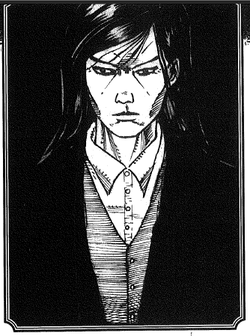
I know karate. And the lyrics to every Karate song.
The Xiang Shi are mostly Asian and primarily Chinese. They have a reputation for being great investors, crime bosses, poets, and martial artists, because duh, they’re Asian. Their origin story is funny. There was an ancient Chinese warrior-king who sought the secret of immortality and conquered everything in his path. A rival petty king taught him about vampirism, in order to save his own country from being conquered. The warrior-king refused to be bound to another vampire, so he set out deliberately committing atrocities in order to become a genitor. He died a mortal, and surprise surprise, the petty king became a genitor because he was the architect behind all the conqueror’s atrocities. Anyhow, the Xiang Shi are masters of martial arts and have invented their own. They’re too busy practicing kung fu to have time to be wealthy dilettantes or cult leaders. Some of them are hackers, because Asians are good with computers. Most are Buddhists who believe in self-perfection through poetry and martial arts. They can be warded off by rice and iron filings, and they get a bonus to Martial Arts.
After the consanguinities we get a little more on vampire culture . Vampires get grouped based on their age, from “newborns” who haven’t lived longer than a mortal lifespan to “ancients” who are literally so, and are rarely seen subjects of legend. Right now, vampires as a whole are embroiled in skirmishes which might be the prelude to another war. Inter-bloodline covens called “murder circles” are actively hunting down enemy vampires to drain their blood or set fire to their lairs. Many vampires gather in covens; some are hierarchical families within one consanguinity, some are the “family” of a parent vampire and their scions, while others are inter-bloodline covens who gather because they have something in common.
Vampire lairs can range from derelict buildings to palatial estates, but what most of them have in common is that they are spacious, modified to block out sunlight, and contain traps and secret escape routes. Even so, many vampires have minions to protect them during the day. Sometimes they make humans or animals into dhampir servants, but they also rely on well-paid mortal thugs.
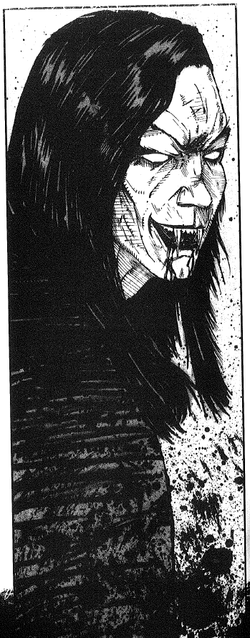
If this was supposed to be Marilyn Manson, it aged better than he did.
As far as their relations with other eldritch are concerned, I can sum it up by saying that they really don’t care for any of them. They’re indifferent to angels and daevas, consider the Tolkien races beneath their notice, and regard questers and spirits as something to be avoided.
Kewl Vampyre Powarz
Vampires get more than their fair share when it comes to the innate powers, too.
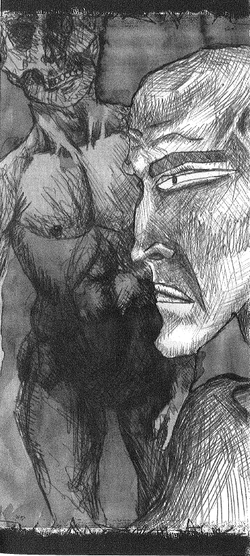
Fortunately, none of them make you look like this.
Aura of Dread : Induce terror with eye contact.
Avatar of the Kali Ma : Dakini only; you transform into a giant, black, six-armed monster.
Black Reverence : Forces nearby mortals to regard you with, y’know, reverence.
Black Widow Walk : Walk up walls like a spider.
Blood of the Immortals : Bathora only; Causes a mortal to age at half the usual rate. Must be reused each year.
Cadaver of Nightmist : You can transform into a glowing mist, and start a terrible metal band.
Deather Crafting : Obayifo only; animates a zombie servant.
Deathstorm : Causes nasty weather.
Erase Feeding : Causes a mortal to forget you fed from them.
Form of the Beast : Each time you buy this one, you learn how to transform into a bat, wolf, rat, raven, or owl.
Hardened Skin : Permanently increases Resilience.
Haunting Reflections : Produces an illusion which is “real” to one sense per success. Illusions can deal damage if the target doesn’t roll to disbelieve.
Inhuman Strength : Permanently increases Strength.
Legacy of Lilith : Lilim only; this nekros allows shapeshifting with few limits. You can change your face, voice, overall body shape, and produce weapons from your body.
Lightning Speed : Permanently increases Speed.
Mesmerism : Mind control through eye contact and simple verbal commands.
Mind Reading : Read a subject’s thoughts.
Night’s Embrace : Raise a cloud of impenetrable black fog.
Nightbeasts’ Kin : Compel animals to regard you kindly.
Ride the Nightwinds : You can fly.
Self-Dismemberment : Penanggalan only; you can detach your head and/or limbs and control them telekinetically.
Shadowmask : Hide your mind from psychic detection.
Song of the Nightbeasts : You can summon and control swarms of rats, bats, or wolves.
Un-dead Sensitivity : You can sense nearby eldritch.
Unholy Splendor : Permanently increases Presence.
The Unseen : Become invisible.
Vampiric Ballon : Permanently increases Dexterity. Thank you, Everlasting, for teaching me the word “ballon.”
Vanishing : Allows you to seem to disappear while quietly escaping.
Weather Mastery : You can alter the weather to your liking.
Will’o the Wisp Body : Obayifo and Xiang Shi only; you can become an intangible, floating orb of green light.
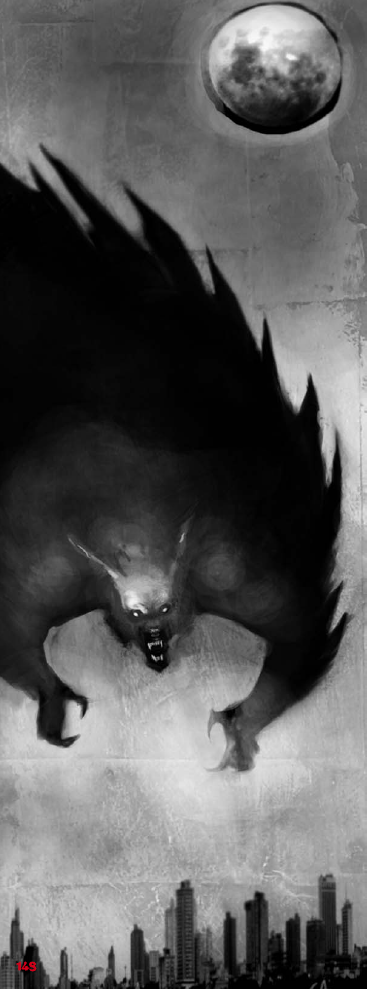
Sawblade Werewolf is not a power, I’m afraid.
Although the author has spent the entire chapter telling us that vampires are damned, selfish, cartel-running, cult-leading wealthy dilettantes with no regard for human life, the section on roleplaying vampires tells us that vampires are no fun when they embrace their evil nature and that this game is about heroes. We’re told to accomplish this by playing up guilt, remorse, and self-loathing at every opportunity. However, the suggested themes for a vampire campaign emphasize common enemies in the form of daevas, demons, vampire hunters, a rival consanguinity, rival kingdoms of night, and finally “Quest for Redemption.”
Next time, on The Everlasting : Holy shit, this isn’t the last character class. Ghosts, everybody!
Fuck You, Ghost Dad
Original SA post
Chapter 7: Fuck You, Ghost Dad
Do you believe this chapter doesn’t begin with a tedious “Do you believe in ghosts?” screed? I don’t. Ghosts are a character type in this game; you can play them, I guess. Ghosts don’t receive as much attention as vampires, only getting 15 pages and 69 unique jargon terms.
Sometimes when you die, your soul doesn’t get to go through the tunnel of light to the Afterlife, and you’re not cool and pretty enough to become a revenant, either. These ghosts, called Dead Souls are disembodied spirits who wander around the Underworld being all sad and stuff. Nobody knows how or why Dead Souls get stuck with such a terrible lot in unlife, which is why they’re also called the condemned.

Do you believe someone saw Mary on the stairway?
Dead Souls’ ethereal bodies are called “cadavers,” which is confusing, because they’re not zombies, they’re disembodied spirits. Their bodies are made of soul-stuff called “nekrum.” By default, they look (and smell) like they did when they were buried, but they can learn to reshape their nekrum into other forms. Like other eldritch, Dead Souls lose animus every day. Regaining it is much, much easier for Dead Souls than for everybody else, but remember that their unlives are really shitty, and regaining animus is no exception. They can eat the unpalatable “rotting food of the Underworld” or they can sleep, which regains animus very quickly but which they experience as a nightmarish fever-dream. They can also steal life-energy from other spiritual beings they encounter by literally pinning them down and sucking it out of them like some kind of wrestling fetish video.
Dead Souls aren’t exactly stuck in the Underworld, either. They can learn to slip into the Reverie and the Dreamworlds, and can even pass through those realms to the real world, where they can float around, walk through walls, and moan and be spooky and stuff. When they’re in the real world, people nearby can feel their “ultimate gloom and sorrow” and touching a person results in chills and depressing visions. Being a Dead Soul is like living on the far side of town with a shitty apartment and a crappy dead-end job for all eternity.
Like revenants, Dead Souls have deathvision , meaning they can sense “the inevitable end of things and the various stages of degeneration and change.” So when a Dead Soul sees a boy playing in the street, he can see the boy, what the boy will look like as an old man, and even that he’s not likely to become an old man if he doesn’t stop playing in a street where 12 animals have been hit by cars in the past month. They notice decay that other people overlook, and have a hard time appreciating beauty because they perceive everything in terms of inevitable entropy. Being dead is really sad, okay?
There’s some more on the ankou from the revenant chapter. They’re not just one faction of revenants who are dicks, they’re law enforcement for all of the dead and somehow connected to Death itself. When a soul bounces off the tunnel of light leading to the Afterlife, the ankou judge them in the “Courts of Death.” Most are just left alone, but some are sentenced to years of literally Sisyphean labor. Those who try to escape are sent to the Circles of Atrocity, which are basically Dante’s Inferno.
There are several types of Dead Souls. The first is the Earthbound , who are free to roam Ethereus, the first level of the Underworld, but can’t go further without help. By and large, Earthbound are very attached to the living world. There are several subtypes, including Undying Obsessives , who want to finish some life’s work, Harbingers of the Dead , who try to warn humans of danger and protect them from evil spirits, Breathstealers , who possess the living because they’re obsessed with enjoying life, Night Haunts , who haunt people for fun because they’re assholes, and Guardians of the Night , who do the same thing as the Harbingers but with different wording.
Phantoms are powerful Dead Souls who live in a self-created Shadoworld, a pocket dimension created by their own mind. Phantoms spend most of the time trapped in their own little world, literally, reliving their own lives. Sometimes they suppress their hallucinations long enough to travel around a bit and even contact humans in the real world. Phantoms aren’t all bad, and some even try to help humans they used to know on a regular basis; the human experiences the phantom’s shadoworld as a daydream. But Phantoms are bad news because even when they suppress their shadoworld, they carry it with them wherever they go, and other Dead Souls can be trapped in it.
Shades are Dead Souls who can travel anywhere they want to in the Underworld. Most of them want to forget their past lives, so they travel past Ethereus and live in the Dreadlands, which aren’t pleasant but at least don’t constantly remind you of how much better it was to be alive. The Praxor is the ruling class of shades. They organize themselves like mafia syndicates, structure the economy so the rich get richer and the poor get poorer, and wage war against each other. They’re dicks.
The Shades are confusing because, as with the ghaddars from the ghul chapter, what we know about living in the Underworld comes in fragments and implications. We know that
the Dreadlands are a vast, overpopulated ghetto, full of Dead Souls who want to experience pleasure, avoid pain, and forget their old lives. Prostitution, drug use, and committing assault and torture for kicks are common in the Dreadlands. Shades have to work and earn money like humans, and much modern technology doesn’t work in the Dreadlands, so many jobs are menial drudgery. The Dreadlands have native animal life, but few plants, so most shades wear clothing made of metal and hide. Basically we know that shades eat, drink, fuck, work, and pay bills like people, but everything is pretty shitty unless you’re rich.
The Rakasha are constitutionally similar to Dead Souls, but they’re not really dead people--they’re invaders from some other dimension. They’ve been waging a low-intensity war to conquer the Underworld for a long time, and they know how to shapeshift into fang-mawed tentacled Lovecraftian beasts.
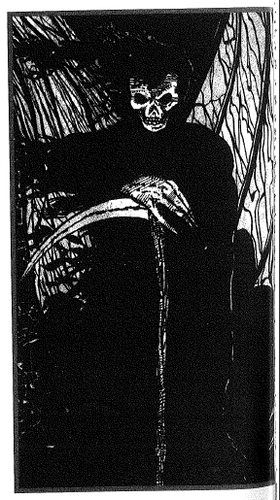
The police in your town would dress like this if they could.
Ankou are the servants of Death. Their duties include cutting the “silver cord” that binds souls to their recently deceased bodies, guarding and escorting the newly dead to the afterlife, and stopping Dead Souls from possessing mortals, which is stealing life that doesn’t belong to them. Everyone else has to call them “Lord/Lady Deathbringer” and they’re dicks.
Life Cords and Death Chains
All Dead Souls have Life Cords and Death Chains , which are positive and negative connections to their mortal lives. Life Cords are things like your love for your family, your career, or a happy childhood, whereas Death Chains are regretful things like having had a bad temper, a drug addiction, or wronging someone you loved. You assign 20 points to Life Cords and 20 points to Death Chains to represent your connections and how strongly you identify them, but the ratings don’t actually matter. Even better, the Guide isn’t encouraged to punish you for not roleplaying your Cords and Chains correctly. Instead, you can act on your Cords and Chains to your benefit.
Dead Souls’ Torment is Imprisonment , which they have along with Freedom . As one goes up, the other goes down. Accepting your place in the Underworld and doing things to increase your wealth and power there increases your Imprisonment--that’s why shades live in the Dreadlands, to forget their old lives, give in to Imprisonment, and try to make the best of life in the Underworld instead of resolving their issues and moving on.
You can increase Freedom and reduce Imprisonment by working with your Cords and Chains.You act on your Cords by remembering your old life, doing the earthly activities you enjoyed, and contacting the living. You act on your Chains by changing yourself for the better, forgiving yourself and others, and making contact with the living to help them and obtain closure.

Sonnn…Lose the trenchcoat and the fedora, sonnn
Playing with Dead Things
In the Dreadlands, everything is made from nekrum, and Dead Souls can reshape simple rocks and dirt into more complex objects if they make rolls and expend enough animus. Any Dead Soul anywhere in the Underworld or the Reverie can use ambient nekrum to conjure objects related to their Life Cords and Death Chains--even vehicles and weapons, with enough effort and animus. Guides are encouraged to disallow abusive or “silly” Life Chains to have an excuse to conjure whatever you want. B-b-but my character really loved clown college!
There are lots of ways that Dead Souls interact with mortals. For one, there are a lot of “ancient laws” which the dead have to obey just because. They can’t use their powers on holy ground, they’re drawn to their own funerals, they have to answer questions posed through ouija boards while they’re around, they must serve magicians who hold their former possessions, etc. Basically the Guide gets to fuck with you whenever he pleases.
There’s about a page worth of difrerent methods mortals use to contact the dead--seances, voodoo rituals, channeling, and even contact by telephone, but there are no rules for it. Likewise the means of repelling the dead, such as horseshoes , white candles, and pouring salt across thresholds. Some humans have the natural ability to see the dead; Dead Souls call them “bonekith.” Others, called Flatliners, can travel astrally. There are no rules for human stats in the Underworld.
There are sects obsessed with Dead Souls. The Charontes are obsessed with creating revenants; some of them even deliberately become revenants, and they murder beautiful people so they can use their corpses, sort of like rock journalists. There’s also a sect of Dead Souls called the Keres, who hunt down and kill certain mortals for unknown reasons.
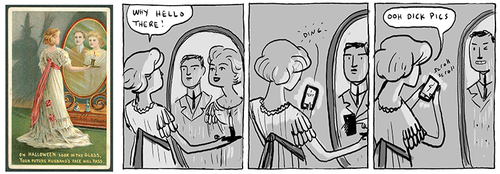
Ghost’s Anatomy
Dead Souls only suffer debilitating wounds from magickal attacks and fire, and even then, the attack has to be “real” to the ghost, so only other spirits can hurt them while they’re intangibly floating around in the real world. There is no True Death for ghosts--if they die, they collapse into ectoplasmic goop and eventually reform, amidst a pile of other corpses in Ethereus. (When people die, their astral form leaves a nekrum corpse, so there are corpses all over Ethereus.)
As discussed, all Dead Souls have the power to conjure equipment, change their appearance, and float around. They also have the ability to provoke a strong emotion in mortals by touching them, and the ability to possess mortals. Possession, like everything else, requires spending animus and rolling. Depending on how well you do, you can simply ride along, or compel them to take an action, or speak through them, or probe their innermost thoughts. It lasts for a few minutes unless you spend more animus.
Like the other types, Dead Souls have preternaturae :
Apparitions : Create illusions as the vampire power.
Black Ratchet : Take the form of a fearsome black dog.
Black Water : Create “shadowy arms” in water that drag people down to drown. Cause I'd like to hear some funky Dixieland, pretty mama come and take me by the hand. By the hand, take me by the hand pretty mama come and dance with your daddy all night long.
Call the Black Storm : As the vampire power, it causes nasty shitty rainy weather.
Corpse Candle : Create a floating eerie light to lure people.
Corpse Melding : You can drastically change your voice, sex, etc. to resemble someone else.
Hand of Death : Kill people by touching them.
Midsight : Read surface thoughts.
Poltergeist : It’s a telekinesis power, whaddaya want?
Secrets of the Dead : Learn things about someone just by being near them and concentrating. This is how ghosts glean the secrets they reveal through ouija boards. If you have nothing better to do than use your magick powers to tell a teenage girl who has a crush on her, you definitely deserve to be a Dead Soul.
Shadow of Death : Makes it difficult for others to perceive you (even other ghosts).
Stalker from Beyond : Become invisible and write letters to Jodie Foster.
Strangely, unlike the other chapters, this one has some sample characters . One is Crazy Gretchen, who lost her family in the crossfire of a mob shootout and started hunting down and killing mobsters with a meat cleaver. Do not taunt Ghostly Kitchen Punisher.
Henry O’Keenly, killed by his wife for being keen on another woman. Used to be a ghost handyman, wants to buy a body and become a revenant.
Peaches Monroe, a circus clown who was killed by an escaped tiger. Peaches is a phantom whose Shadoworld is like an old-fashioned traveling circus. This is clearly an attempt to run a campaign full of Kingu and I’m not having it. Stop watching Joe Bob Briggs at 3 o’clock in the goddamn morning and forget about the fucking carnivals you juggalo motherfucker!
Thus concludes this shitty depressing version of Golden Sky Stories .
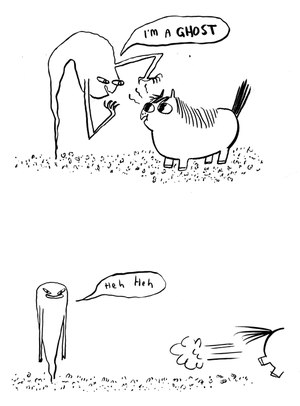
Next time, on The Everlasting : What they believe, like the stars and stripes of corruption. FRANKENSTEIN!
That’s “Fronckensteen!”
Original SA post
Chapter 8: That’s “Fronckensteen!”
The “do you believe?” paragraph at the beginning of the reanimates chapter is particularly corny--even the waterheads who believe in vampires and buy books by people with names like Konstantinos and Starhawk aren’t out buying torches and pitchforks in case Frankenstein’s monster attacks. It mentions the people who have their heads cryogenically frozen, and wonders if scientists might be capable of reanimating the dead already. (Even as a zombie, the creepiest thing about Walt Disney would still be that goddamn moustache.) As somebody who works for a pathology department, let me assure you that Victor Frankenstein wouldn’t have gotten anywhere without a job at Pfizer or a grant from the NIH.
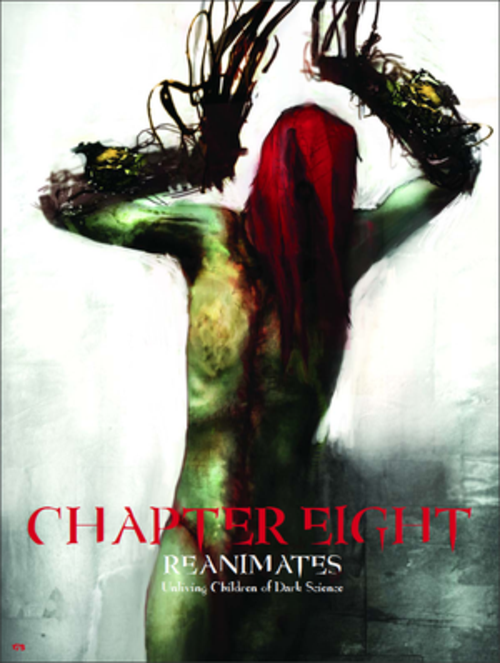
Increase the Flash Gordon noise and put more science stuff around.
Reanimates are created by “dark scientists” who combine medical and occult science to trap a Dead Soul and implant it in a dead body. There isn’t one correct method, but any way you slice it (sorry) reanimation requires a large laboratory with things like meat lockers, chemical baths, intimidating orthopedic surgery tools, and spooky machines with lights and dials and Tesla coils and shit like that. Even an experienced mad scientist with cutting-edge (sorry) equipment can only get it right about 25% of the time.
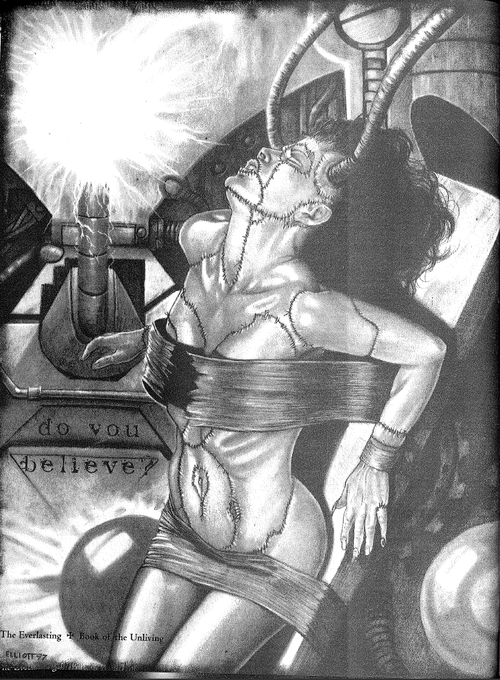
The “scientist” in charge picked out individual lips, cheeks, breasts, and a navel. The first woman designed with the help of r/MensRights/ and a suave fedora.
Reanimates come in three basic varieties. The first is fleshfreaks , who are created from parts of recently-dead bodies. A reanimator may harvest parts from more than two dozen fresh corpses to assemble a specimen. The most interesting thing about fleshfreaks, and indeed the whole chapter, is that their creation is driven by a group called the Friends of the Automatons, scientists who create reanimates “for the betterment of mankind.” They’re competitive, they circulate an underground medical journal (called The Re-Animator Monthly
 ), and they prize creations that are healthy, attractive, and resistant to aging and disease. The first fleshfreaks were created 275 years ago with chemicals and galvanism. (When this book was published, that would be 1720, more than a century before the publication of
Frankenstein
.) Fleshfreaks themselves come in three subtypes.
Superiors
are walking masterpieces and indeed physically superior to most people.
Patchworks
are, well, not-so-seamless attempts, and often suffer from visible scarring and mismatched body parts, while
Obscenities
are twisted and deformed. Fleshfreaks often have the “advantage” of cybernetic implants and extra organs, transplanted from both humans and animals. Most reanimators aren’t deliberately trying to create monstrous deformities, so subtle advantages like a second heart and night vision are much more common than extra limbs and eyes.
), and they prize creations that are healthy, attractive, and resistant to aging and disease. The first fleshfreaks were created 275 years ago with chemicals and galvanism. (When this book was published, that would be 1720, more than a century before the publication of
Frankenstein
.) Fleshfreaks themselves come in three subtypes.
Superiors
are walking masterpieces and indeed physically superior to most people.
Patchworks
are, well, not-so-seamless attempts, and often suffer from visible scarring and mismatched body parts, while
Obscenities
are twisted and deformed. Fleshfreaks often have the “advantage” of cybernetic implants and extra organs, transplanted from both humans and animals. Most reanimators aren’t deliberately trying to create monstrous deformities, so subtle advantages like a second heart and night vision are much more common than extra limbs and eyes.
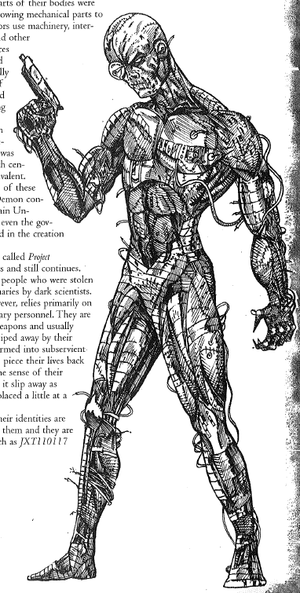
Hey, sexy mama...wanna kill all humans?
Deathmechs are reanimated bodies who have had some of their parts replaced with cybernetics. Several governments and powerful eldritch have discovered the secret of creating deathmechs to serve them, including a US government program called Project Ghostwalker which has been around since the late ‘40s. Deathmechs have a sorry lot--most of them are built to be perfectly effective, obedient killing machines, not to enjoy quality of life or have the physique of a Greek god. Most of them are dehumanized with names like KLFK-9000 and discouraged from developing their humanity or recovering memories of “past lives.” They often have scarring and visible cybernetic implants, need regular maintenance, and worst of all, may have to have more and more necrotic tissue excised and replaced with machinery. Their bodies are often implanted with weapons, armor, reinforced tissues, and all kinds of sensors.
Golems are entirely magickal, entirely inorganic reanimates. The first was created by Kabbalists, but other magickal traditions have copied their methods. Golems don’t need to eat, sleep, or breathe, and they’re hard as stone, but they still enjoy five senses and the ability to speak and move with the suppleness of a human body. Many can pass for human, they’re just square-featured and plain, unless their creator deliberately sculpts them to have monstrous features or extra limbs and eyes and such.

Maybe it’s a good thing Robert Smith got fat.
Reanimates’ Torment is literally Angst, and needs little explanation, though “monstrosity” might be a better word. Reanimates are created fully-formed without a natural origin or identity, so they struggle with self-loathing, disgust with their own capacity for violence, and a tendency toward depression and impulsive violent behaviour. Revenants fight Angst by developing relationships and finding meaning and emotion in their lives, and give in to Angst by giving up their free will and becoming distant from humans.
Like other unliving, reanimates lose 3 animus a day, but their means of regaining it is left almost entirely to the Guide. Fleshfreaks and deathmechs usually need electricity or chemical baths; the process can be as simple as attaching a gadget plugged into a wall outlet, while there are guidelines for how much daily chemical baths should cost. Magickal means of recharging, like herbal concoctions or spending time recharging in a magic circle are completely up to the Guide. Some reanimates have to eat human flesh, in which case they gain animus from it just like ghuls.
Reanimates all get increased Aspects, rapid healing (but not regeneration), and resistance to disease, poison, and drowning. Deathmechs also get body armor, golems get more body armor, and any reanimate may have enhanced senses. They take debilitating damage from fire (except golems) and can be “killed” by decapitation or damage that’s more than twice their Life score, but as long as the brain is mostly intact, they can be rebuilt.
If you’re playing a reanimate, your innate advantages and disadvantages can vary wildly with the Guide’s attitude. Fortunately, beyond “maybe you need to eat plutonium to power your railgun penis, just wing it” reanimates do have a few preternature available.
Revenant powers are called Augmentations and are as follows:
Animal Sensory Organ Transplant : You get a bonus to tests using a particular sense.
Chemically/Pneumatically Enhanced Musculature : Permanently boosts Strength.
Electromagnetic Metabolic Enhancement : You have regeneration and the ability to regrow lost limbs.
Fringe Lurker : Like powers for several other character types, this makes you unnoticeable without conveying true invisibility.
Human Perfection : You can force mortals to revere and be in awe of you.
Neuro-Net : Permanently boosts Speed.
Post-mortem Memory Retention : You fully remember your past lives, and levels in this augmentation permanently boosts Intellect and gives you free skill points.
Synthetic Flesh : Permanently boosts Resilience.
Wallcrawl : Like several other powers, you can climb walls like a spider.
The sample character is named Alexandra Cruesoe who is actually interesting. She was a ballerina who died in a fire, and whose husband reanimated her as a patchwork fleshfreak. She lives in seclusion as a science fiction writer and makeup prosthetic artist, which allows her to leave her home from time to time. Her writing has been very successful, and now her agent is pressuring her to do a book signing tour to promote a book that’s been made into a film.
Next time, on The Everlasting : Join the Everlasting Fun Club, Mac!
The Othered Everlasting
Original SA post
Chapter 9: The Othered Everlasting
The original World of Darkness games each included a brief chapter on antagonists, including rules for thugs, cops, guard dogs...and the other supernatural races “translated” into stats for the game you were reading. A vampire campaign could include mage antagonists or vice versa, without having to buy two books.
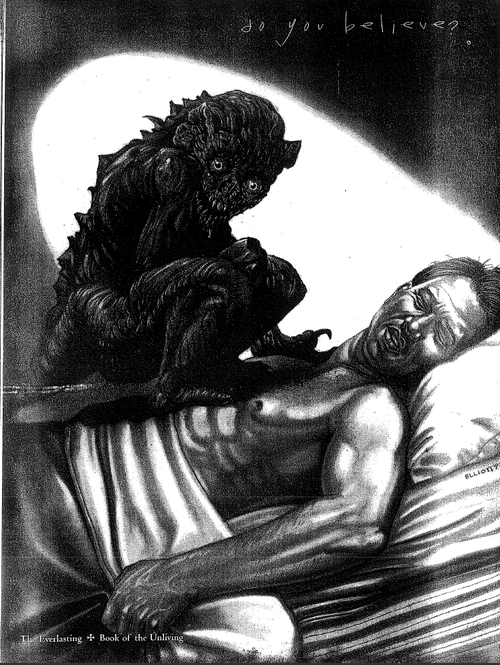
MOM DON’T LOOK
This chapter of The Everlasting is like that, only shitty. It gives an overview of the other races of Everlasting, along with their Torment and their innate abilities. Yet it doesn’t include any explicit powers, statblocks, or other things that would actually encourage you to use these other supernaturals in your campaign. Instead, it feels more like a 15-page advertisement for the other books in the Everlasting product line--which have already chewed up too much space in this book, which spent its introduction dealing with daevas and demons which seem to be of little interest to any of the unliving races.
Angels are timeless beings from a “higher spiritual plane” who watch over humanity. They have several different forms depending on what layer of reality they’re currently occupying (ooh, purple haze). They all know that they have some kind of special destiny to serve the cosmos, but they also have free will and worldly desires, leading to fallen angels. Their Torment is Imperfection--the temptation to give in to worldly concerns.
Angel powers include enhanced senses, Aspects, regeneration, flying on wings of light, and telepathic angel speech that transcends dimensional boundaries. They regain animus by spending time on the higher planes. They can be killed, but they’ll form a new earthly body--it’s impossible to really kill these hippie bastards.
Daevas are humans who are transformed into demigods reminiscent of pagan myth. They all have precognitive ability related to their ability to perceive the “Web of Destiny.” They used to be the most numerous eldritch, but half of them vanished in the setting’s big metaplot event. They organize themselves into “households” modeled after pagan pantheons. Their Torment is Doom--they become trapped by their visions of the future, and fear their ultimate destiny in a final apocalyptic battle. Some become obsessed with trying to change their fate, others with clinging to ritual and routine.
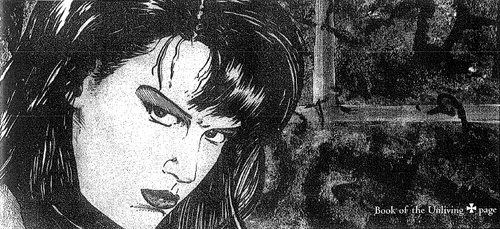
Hey baby, do you have inside you blood of kings? Would you like some?
Daevas get the standard package of enhanced senses, Aspects, and regeneration, plus a prescient ability to predict likely futures and an aura that projects their emotions into others. They recover animus simply through food, rest, and meditation. Each has a particular vulnerability (the guy from the sample fiction was allergic to gold).
Dragons are literal forces of nature who ruled a prehistoric fantasy civilization until they were overthrown. They spend most of their time in human form; transforming into their dragon forms is difficult. They hate demons and evil versions of their own kind, the leviathans and azhi dahaka. Their Torment is Furor; their anger at being overthrown tempts them to despoil the world for their own gain and destroy anyone who gets in their way.
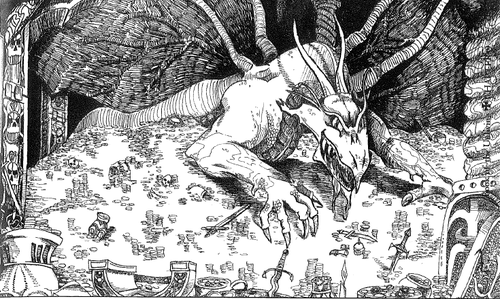
Oh yeah, you’re a dirty little treasure horde, aren’t you? Yeah, take it baby.
Dragons have a lot of powers. Each dragon has an elemental connection and is adapted to survive in some kind of lethal environment (like the Antarctic or the inside of a volcano). They have body armor, acid blood, enhanced memory, enhanced senses, increased Aspects, rapid healing, resistance to toxins, disease, and pressure, low-light and infravision, the ability to comprehend all languages, and in dragon form, the ability to swallow enemies whole. They regain animus from food, rest, and eating gems. Dragons have no particular weaknesses, but can be permanently killed with enough damage.
Elves are hybrids of humans and creatures from the realm of Faerie. Their civilization has lasted for millennia and they exist on many parallel worlds, resulting in many elven nations. They inspired many human epics, and they breed and keep fantastic beasts. Although elves are more closely connected to humanity than to Faerie, which they consider strange and bizarre, their Torment is Yearning, a weariness with worldly concerns and a desire to pass into their spiritual afterlife.

Shovelface
Elves benefit from enhanced memory, senses, agility, increased Aspects, rapid healing, and night vision. They regain animus from food and meditation (just like D&D). They’re vulnerable to intense cold and fire, and enough damage will kill them.
Faerie is a broad classification of creatures from a magickal dimension with strong ties to the primal force of nature. There are dozens of differently kinds of faerie, some of which aren’t even humanoid. Their bodies are a combination of spirit and matter, and they only age when they’re in an earthly realm. They’re often identified as nature spirits, but it’s more accurate to say that they’re embodiments of chaos and infinite possibility. Their Torment is a conflict between Fayerie and Lucidity--as Fayerie increases, they become more chaotic and imaginative to the point where the line between the real and unreal blurs, and they transcend beyond three-dimensional reality.
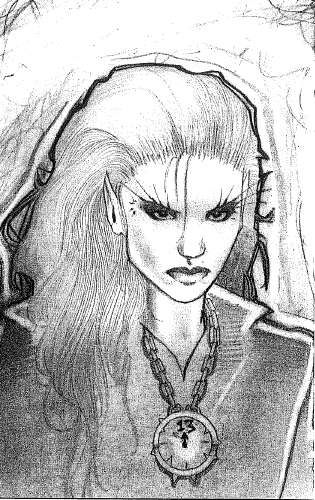
The difference between elves and faeries? Eyebrow quills.
Faerie have enhanced senses, Aspects, and regeneration, the ability to “recognize patterns in chaos,” resistance to disease, and the ability to alter their voice and appearance. They regain animus by draining the foyson, that is, the innate power from everything. This is harmless and unnoticeable when they drain it from the lands they protect, but they can also steal it from individual objects, causing milk to spoil, plants to wither, metal to rust, and electronics to malfunction. They’re vulnerable to fire and specific faerie foils that aren’t listed here. Faerie who die may reincarnate sooner or later.
Gargoyles are confusing. Original, as near as I can tell, but confusing. They’re a race of celestial spirits, bound into stone bodies by an ancient cult. They were created to guard sacred places and fight demons. They’re also called “Sin-Eaters” because...oh, I’ll let the book try to explain itself:
quote:
The gargoyles are called Sin Eaters, as they are attracted to evildoers like moths to the flame. Part of the curse the Servants of the Flame imposed upon them is that the gargoyles must pass on the Curse of Absolution by touching people, thereby taking on the memories of any sins the people have committed. The gargoyle is simply the conduit for the curse; its punishment is chosen by some higher power, and the gargoyles are forced by their very nature to do what is required of them. Sometimes the curse requires the gargoyles to carry out the punishment themselves; this often involves maiming or killing the evildoer. Often the gargoyles do not have to do anything, because the curse often takes the form of Backlash or specific tragedies that will soon occur in the sinner’s life.
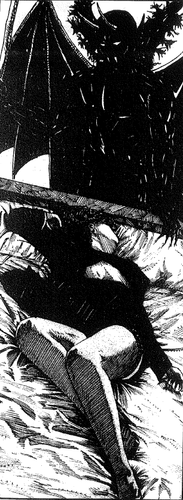
You eat the Rohypnol, he eats your sins.
Gargoyles have enhanced senses, including seeing spirits and sensing sin, rapid healing, and can shapeshift into more or less monstrous forms. They can be killed with enough damage, but the gargoyle’s spirit is free to reincarnate in a new body, free from any madness induced by Horrification.
Manitou are animal spirits who possess humans, until the human and totem powers merge. It’s implied that manitou possess desperate people who could benefit from the merging. They’re allies with the dragons (since both have a strong respect for nature) but feel lonely because they don’t entirely fit in with people, spirits, or animals. Their Torment is Animalism, in which they lose their human reason and live like animals.
Manitou have enhanced senses (like everyone else), rapid healing, and the ability to communicate with animals and spirits. They regain animus from eating and meditating, and they’re vulnerable to fire and cold.
Osirians are pretty cool guys. They’re mortals who reincarnate again and again to serve the “Cosmic cycle,” and their dozens of lifetimes instills them with compassion for others. They begin their new lives ignorant of their nature until another Osirian finds them and gives them the yer-a-wizard-Harry routine. They’re ruled by a council of the first nine Osirians, who are all still around. Their Torment is Ennui, which is self-explanatory.
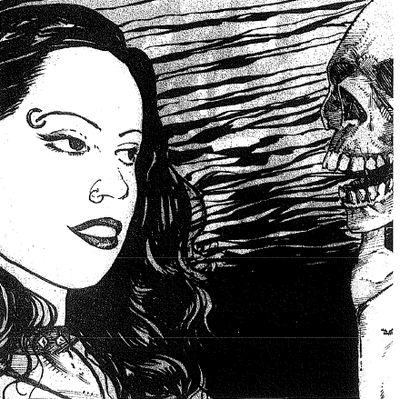
Osirians have the ability to analyze the auras of people and magickal forces, and they have enhanced senses (yawn) and rapid healing (yawn). Their main power is in their magickal paths.
The Possessed are totally uncool. They’re dream entities called ochelum who, when they’re not possessing a host, live in gems or amulets. When a mortal acquires the amulet, the ochelum corrupts them with promises of power and begins a slow process of possession. After possessing the host, they slowly consume their soul. There’s a race of evil ochelum who possess good people for kicks, while the “good” ochelum possess evil people because only evil people deserve such a fate, but all ochelum hate each other, they just hate members of the other race more. Their Torment is corruption, and they don’t really fight for or against it--when they’ve completely consumed their host’s soul, they must move on to another body.
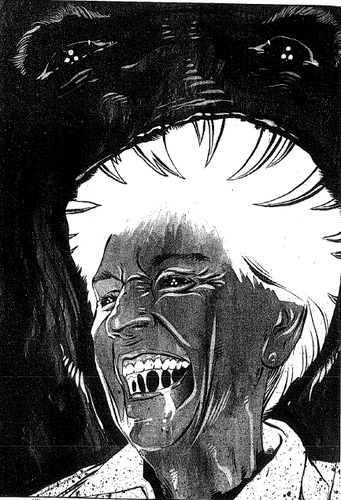
Grandma got devoured by a monster
Coming home from work All Hallows’ Eve
You can say there’s no such thing as Santa
But as for Everlasting, DO YOU BELIEVE?
Possessed have the power to change their appearance, create illusions, and a tediously-explained ability to manipulate dreams. They don’t have enhanced senses. Strangely, they regain animus by compelling Persona trait tests in others (evoking emotion). Possessed are vulnerable to fire and cold and can be killed in the usual way, but to kill the ochelum, you have to destroy its host and its soul-prison.
Questers are another of the cooler and more interesting factions. They’re mortals who devote themselves to a just cause so completely that they receive a divine vision (again that vague and mysterious “Divine”) that grants immortality. The Grail Quest is just one particular ideal which inspired many questers. Their Torment is Doubt, in which they lose faith in themselves and in the purpose of a Quest against evil that can never really end. Questers who give into Doubt can actually lose their memories and begin aging normally.
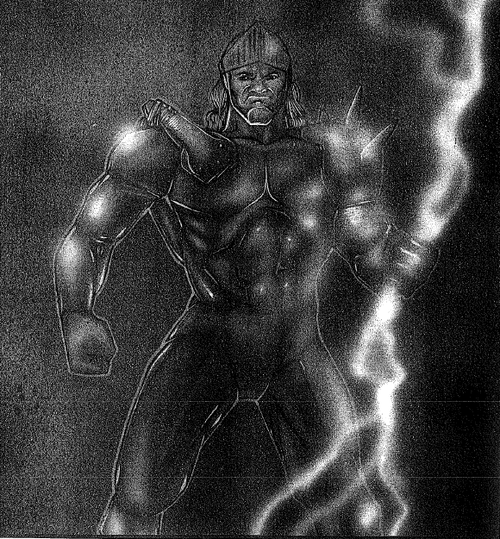
SNAP INTO A SLIM JIM
Questers benefit from rapid healing, spiritual armor (especially effective against demons), and even the ability to invoke a miracle to save themselves if they’re in a hopeless situation. They regain animus from rest and meditation. They’re particularly vulnerable to fire and cold, but can be killed conventionally.
With all the magickal critters running around this setting, I’m surprised that there are no advertisements descriptions for letters S-Z. Then again, there are three different ways to play a zombie in this book.
Next time, on The Everlasting : Have you wondered what kind of setting we’re actually playing in? Lonesome no more!
Mysteeerious Worlds
Original SA post
Chapter 10: Mysteeerious Worlds
This bullshit seems particularly apropos given Ningyou’s excellent Mage/Changeling sourcebook reviews. You know what? I’m just going to let the author dig his own grave:
quote:
Are things we take for granted as real actually part of everyone’s reality, or are they real only within our own minds? Think of how no two people perceive or recall things the exact same way – reality is colored by personal perception. Hallucinations, delusions, insanity, and imaginings may all be altered senses, but they are just as real to the person experiencing them as anything you have ever experienced.We cannot define a sense out of context, so there can be other senses, or perception ranges, beyond our own. The Reverie is the easiest extension of human senses into what lies Beyond.
The supernatural is all around us; we simply do not see it. Science, education,work, and dreary mundane life have dulled our senses of magick and put blinders on us that allow us to see reality as a set of parameters, not as limitless possibilities. With mundane pressures and the replacement of our own imagination by television, the innate magickal sense within us atrophies.Yet magick lies before us. There are things science cannot explain – wondrous, magickal, dangerous, mysterious, and exciting things. True magick exists within us in the form of imagination.
If I wanted to live in a squalid world ruled by bloodsucking monsters, I’d vote Republican.
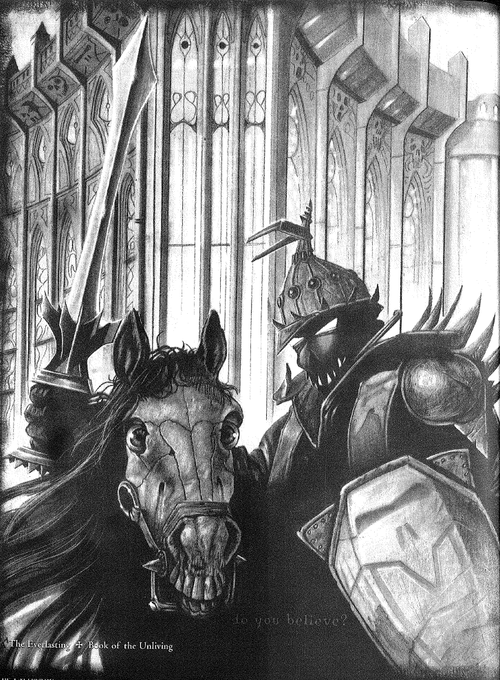
Do you believe this guy dug up a horse for his Darknut cosplay?
In this chapter, we get an overview of the setting as most of its inhabitants experience it, and a presentation of the many alternate planes of reality. While it’s not nearly deep enough to run an entire campaign in the Underworld, it’s better than the stultifying infodump from the introduction and the scattered details from previous chapters, which paint the Underworld as part high fantasy setting and part Third World shithole.
The Real World is the world as experienced by normal people who have no contact with the supernatural. It’s a polite fiction formed by broad consensus, but everybody brings their own perspective to it--some people believe in angels but not aliens, and vice versa.
Most of the eldritch spend most of their time in the Real World, too, working jobs, paying bills, joining bowling leagues, taking yoga classes, buying Girl Scout cookies, watching "Survivor," picking up girls in bars without eating them, the works. The authors’ inconsistent vision crops up again here--haven’t we been told that the unliving dwell in covens of their own kind, or are loners? And that they try to fit in, but dress like goths and hired Morticia Addams to decorate their homes? What does a Dakini vampire say when his book club asks about the collection of human skulls and antique weapons adorning the walls of her palatial estate?
The Real World is contrasted with the Secret World. The Secret World is used synonymously with the Reverie, which is the baroque and awkward catch-all term for the supernatural creatures and happenings which are secretly all around us. (No wonder, since this game line has 19 types of playable bugaboo, plus all their servants, offshoots, and enemies.) The author discusses the Reverie as not just a catch-all for everything supernatural, but as a second layer of reality over top of our own. This layer is “thicker” or “thinner” in some places, making it easier to access other planes and work magick. Despite the fact that most eldritch spend most of their time preoccupied with mundane lives, we're also told that most eldritch still make their homes where the Reverie is strong.
Particularly sensitive mortals, called Sensitives or fantasts, posses the “active imaginations, open minds, and powerful wills” necessary to perceive the Reverie. Oh, bother. In the author’s defense, it’s made clear that this is more of a hazard than anything. Skeptics, scientists, and other boring people are less likely to perceive the Reverie. Children, the mentally ill, and hallucinogen users are also more likely to perceive the Reverie, but they aren’t well-equipped to deal with the Real World or the Secret one.
Eldritch sometimes “awaken” mortals by demonstrating their powers, or when they choose them as servants and companions. (For example, vampire drones.) Some of the awakened mortals who don’t become minions of the eldritch will become monster hunters. So what does it mean for a mortal to “awaken?” It’s strongly implied, but not stated plainly, that mortals will react to supernatural displays with mass hysteria or total denial, to the point that they can rationalize a battle between a dragon and a ghostly knight as a drive-by shooting. This is why eldritch don’t show off their powers in public, which also nets them Backlash points. (There’s no solid explanation for why flashing powers creates Backlash, which isn’t an in-setting concept like Paradox in Mage: the Ascension or Delirium in Werewolf: the Apocalypse . So it’s another encouragement for the Guide to employ Backlash as a stick to punish PCs for not propping up the assumptions of this house-of-cards setting.)
The different races of eldritch broadly perceive the Reverie in different ways. Angels see everything in accordance with the divine clockwork and whether or not it’s running smoothly. Dragons see things in terms of interactions of the primal elements. Questers see the world in terms of a battle between good and evil, while demons see layers of sin to exploit. The unliving--you know, the ones this book is supposed to be about--see the world through the eyes of a predator, and see everything in terms of its eventual decay and death.
The Inner Worlds
So how about them actual alternate realities that aren’t just symptoms of schizophrenia? I thought they would be simpler, but no such luck.
The first category of unearthly realm is the Inner Worlds , or otherlands, which are sustained by the minds of the living. They include the Astra , an astral plane of thought, the Dreamworlds , where living things go when they dream, and the Underworld , a “theorized realm where ghosts exist, but it has never truly been explored by the living.” (Despite being “theoretical,” the Underworld is the only realm that gets a lengthy description.) Living things usually only enter the Inner Worlds through their subconscious minds, so there’s no way to prove their existence or bring objects into or out of them. Since the Big Metaplot Event happened, physical portals into the otherlands have appeared sporadically, not to mention we know that ghuls can physically travel to the Underworld by hiking.
The Agarthic Spheres , collectively called Agartha , are alternate realities that one can enter physically. They’re fairly secure for those who control them, since you can’t just go hunting for one; you need a magick spell or key or to do something like turn the hands on the grandfather clock in Kaufman’s pawnshop to midnight at noon during a solar eclipse, or something like that. Agarthic spheres worth mentioning are controlled by cults and covens and government conspiracies and suchlike.
The book is so busy categorizing these otherworlds and talking about how to get in and out of them that it has no time to tell us about any of the Agarthic spheres. Except Faeryland, which is a wild land full of magical kingdoms. Thanks, I would never have thought of that myself. Instead, Everlasting actually does something right for a change, and spends most of the Unliving book's chapter on other realms describing...
The Underworld
“Little is truly known about the Underworld,” we are told, which made it a stupid idea to suggest setting entire campaigns there. The Underworld is sort of a way-station between the Real World and the Afterlife. Only a tiny fraction of people who die become Dead Souls; most pass on to the unknown Afterlife. However, anyone who dies leaves behind their astral body, too, so the Underworld is full of astral corpses. Many condemned are placed on cadaver duty, but the astral bodies never completely decompose, so we can safely assume that the surface of the Underworld is a thick layer of undead chum.
As discussed in the Dead Souls chapter, all those Dead Souls and astral corpses wind up in Ethereus , the “corpse of the Earth” and a depressing mirror of the real world. Ashy soil, overcast skies, and chilly air that always stinks of corpses are par for the course in Ethereus, not to mention the Black Storms that periodically bring rains of blood, bile, even more ashes, black frogs, black eyeliner, Olestra, all kinds of nasty stuff. It’s also lonely; the Earthbound are stuck in Ethereus, and besides them few ghosts make their home in Ethereus. Underneath Ethereus is a network of tunnels which leads to the labyrinth-city of the Iblis, which facilitates commerce between the ghuls and the Underworld.
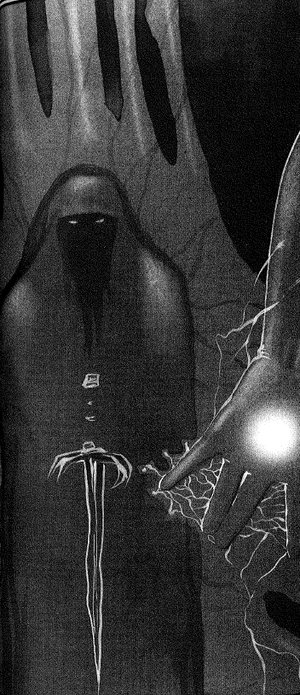
Dammit, Jackson, there are no ringwraiths in this game!
Most people in the Underworld are Dead Souls, but there are also angels, demons, and assorted others. There is animal life, including pale and unhealthy-looking versions of pigs and cattle as well as cats, rats, and birds.
Beyond Ethereus are the Dreadlands , the roughly Earth-sized “core” of the Underworld. The ankou send most Dead Souls who aren’t Earthbound to the Dreadlands, where they’re left on their own. Technology is valuable here, so Dead Souls whose life memories equipped them to conjure working tools are the most likely to find gainful employment. Many more will wind up as laborers and servants. Besides what the Dead Souls chapter told us, we know that the architecture of the Dreadlands looks like it was “designed by H. R. Giger and Anton Furst.”

Prince of the Land of Stench!
There are 13 empires of the Dreadlands remaining; a significant portion has been overtaken by the rakshasa, an invading force of malevolent spirits, and become the Forbidden Lands . When they’re not infiltrating the Dreadlandic empires, the rakshasa keep to themselves.
Shadoworlds are pockets of altered reality which change and move with the phantoms who create them. Within a Shadoworld, its creator is godlike and absolutely anything can happen, so there’s no reason to elaborate on that point again and again.
Of less interest to PCs are realms like the Chasm of Lost Souls , a five-mile-wide pit in a great ashen desert, which leads to a feared but unknown realm called Tartarus. Being tossed into the Chasm is the most severe method of execution the ankou have at their disposal--even worse than being sentenced to the Circles of Atrocity , which are pretty much Dante’s Inferno.
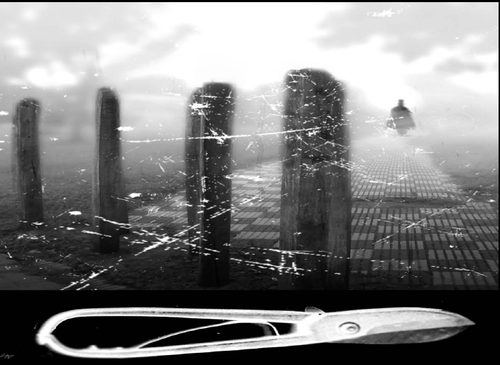
Remember, we’re parked in Lot B, next to the standing stones in Section That Dream Where Your Mother Threatens to Castrate You.
For some reason, the Underworld also contains Paridisio , the heavenly realm from which the angels “look down over all.” That’s quite a trick, since the ghuls travel to the Underworld by going deep underground. Paradisio doesn’t matter because only angels are allowed; it’s supposed to be a beautiful city of gold and white marble. There are, of course, rumours that the angels have let certain Dead Souls into their secret clubhouse, but come on--these are people who look down on the cosmology of Everlasting to say “Eh, not bad for gummint work.” You don’t want to be invited to their meetings.
There is neither a map nor a clear explanation of where these realms are in relation to one another or how one travels from one to another.
Next time, on The Everlasting : “Advanced guidelines.” Remember, there are no rules in this game. But if this game had rules, and you wanted more of them, this would be the chapter for it.
Advanced Guidelines. Advanced. As in stomach cancer.
Original SA post
Chapter 11, Part 1: Advanced Guidelines. Advanced. As in stomach cancer.
Oh boy, this one’s going to be a doozy. After my last update, I realized that this chapter contains not only a bunch of finicky “advanced guidelines,” it also has all the rules for magickal paths.
Do you remember how the character creation chapter just glossed over attributes and skills in favour of “legendmaking” rules like Persona (rules for caring about things), Distinctions (rules for being Mary Sue), Destiny/Backlash points (rules for being the Guide’s bitch), Torment (rules for being sad about having superpowers), and shit like that? The details for mundane skills and how to use them got crammed into this chapter.
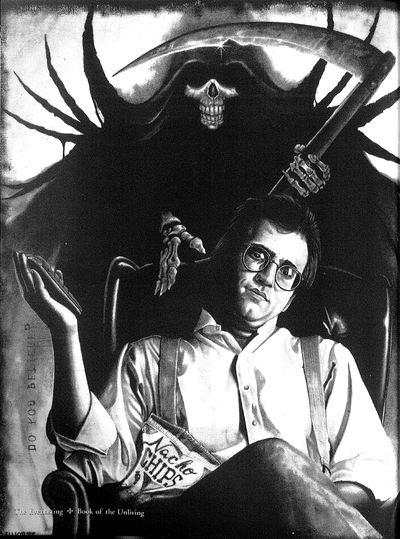
Do you believe this author watched every episode of “Gravedale High?”
The first part of this chapter reminds me of the “Systems” chapter that used to appear toward the back of the old World of Darkness corebooks. They were a smart move by White Wolf; those chapters would give you not just combat rules, but rules for resolving common scenarios that begged for more than a single skill check, such as car chases, surveillance, seduction, and so on. This chapter has a bit of that, but it’s a fat grab-bag of skill descriptions, advanced combat and injury rules, more rules for using those Persona, Distinction, and Torment traits in gameplay, live-action rules, miscellaneous junk...and magick, which we'll cover later. By and large, these rules and the writing style employed to convey them are both 90s as fuck. Lots of droning on about roleplaying, yet so much preoccupation with how a gun works.
Skill descriptions
This part is kind of important, because they not only tell you what skills do, but the skills’ “primary Aspects.” As in the Storyteller system, skills aren’t always associated with one Aspect; the Guide can ask you to test Resilience+History or Intellect+Flails if they think it’s appropriate. Of note is that not a single skill is linked to Strength; all the physical skills, even Climb and Swim, are commonly linked to Dexterity. There’s no skill for lifting; I guess Strength is only good for carrying luggage and a little extra melee damage. Eat shit, jocks.
It’s a waste of time to go through every skill in the game, so I’ll just share the highlights:
Accuracy: For throwing weapons, but not for bows or slings.
Acrobatics: Gymnastics, and of course, you can use it to reduce falling damage.
Climb: They think you need to be told what a climb skill is for. It does include the use of climbing equipment.
Dance: For dancing. Characters should choose a specialty, such as ballroom or folk, because it’s really important that I know my centuries-old ghul character is an expert clogger but can’t tango.
Focus: A weird catch-all for “extreme feats involving the body,” including controlling your body functions like a master yogi, unliving characters trying to seem lifelike, and summoning “ki” to perform martial arts feats. (I don’t think there are actually any rules for that.)
Run: For running.
Swim: For swimming.
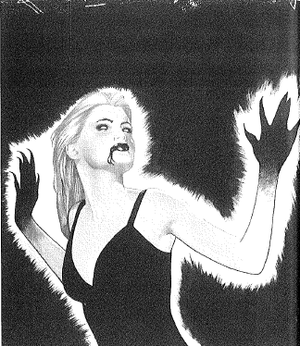
Murder: A strangely specific skill for planning, executing, and getting away with murder, including knowledge of execution methods, disposing of bodies, erasing evidence, and basic forensics.
Stealth: For stealth.
Streetwise: Surviving on the streets
Antiquities: There is a skill separate from History for “knowledge of physical artifacts of history, whereas History covers academic knowledge of times and events.” I guess you use this skill to play Duncan MacLeod’s day job.
Romance: A more holistic and, uh, wholesome skill than just seduction.
Blind Fighting, Block, Evasion, Grapple, Kick, Punch: These are each their own separate skill.
Axes, Clubs, Knives, Flails, Polearms, Staves, Swords: Ditto.
Management: For running a business as well as white-collar crime. In an unusual moment of insight, the book points out that this is useful to eldritch who want to transfer their assets from one identity to another.
Rationalize: There is actually a skill for convincing your self that the supernatural does not exist; I suppose mortals roll it to avoid awakening.
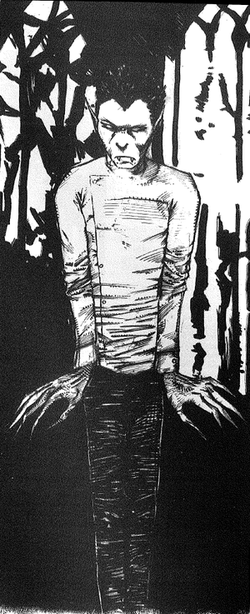
Now is the time on Sprockets when we dance.
Astra: Traversing the Astra.
Dream: Ditto for the Dreamworlds.
Eldritch: Knowledge of the eldritch genii and identifying them on sight.
Empower: For instilling supernatural power into objects or people.
Illumination: Perceiving the Reverie.
Using Distinctions
Those weird semi-innate, semi-social backgrounds from character creation, that are sort of like Backgrounds and Merits & Flaws from Storyteller games? We get some suggestions for what you can actually do with them.
Biography : Remembering historical details from your own lifetime, or having a Highlander-style flashback.
Eldritch Ties : “Throwing your weight around” with your reputation, getting in touch with another eldritch, diplomacy between eldritch factions, using eldritch contacts.
Servitors : Gathering information through minions, having mundane tasks performed.
Resources : Bribery, aquiring expensive things, or “getting invited to a country club.”
Temporal ties : Using mortal contacts, getting an appointment with a politician, or manipulating local government, law enforcement, etc.
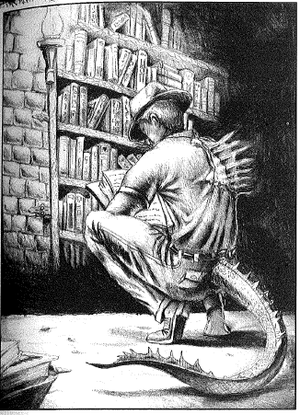
fedorasofLV-426.tumblr.com
Uh, that’s all. There’s no advice on how to use your beautiful cheekbones (Physique) or level-headedness (Psyche) to get ahead in unlife.
Advanced Combat & Injury (3 credits)
This section includes rules for armor, damage from environmental hazards, and an odd collection of combat hacks.
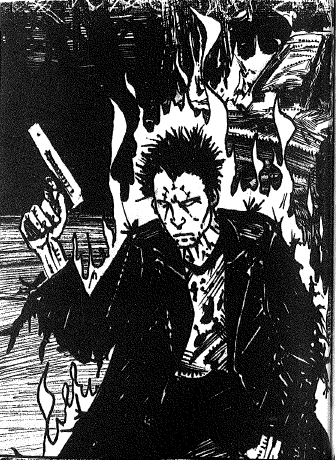
You just pick up a gun, go bang, and you’ve got legendmaking.
First is a mook rule --two of them, actually. The more complicated one says that if you inflict 5 points of damage before your enemy’s Resistance roll (4 if you have a weapon), the Guide can say he’s knocked out of the fight. Doing 7 points means you’re maimed or killed him. The simpler rule simply says to take 1/5th of your Dex+Weapon skill...that’s how many nameless mooks you can take out in a round.
Next are rules for concealment , letting people draw Perception to notice “one weapon per success,” with modifiers to represent the length of your katanas and your trenchcoat.
The rule for “ hair-trigger reactions ” allows you to react to ambush by firing a preemptive shot. That’s useful, since the default combat rules heavily favour surprise.
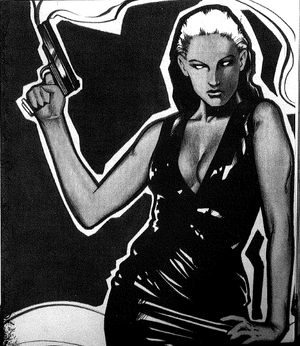
I have a hair-trigger reaction to this.
Pistol-whipping is a “rule” that doesn’t need to be a rule...it adds +1 to an unarmed attack. Neither is the use of silencers , which reduce damage and halve range. Gun jams are what happens if you roll a Disaster while using a gun; you need a few cumulative successes to clear a jam.
The rules for armor are in this chapter instead of the main combat rules. There’s a chart covering everything from lacquered wooden armor to plated mail to riot gear, in case your game requires you to send a SWAT team after a Tlingit raiding party. Armor adds cards to your Resistance roll, and may reduce the damage of blunt weapons, edged weapons, bullets, fire, electricity, and cold depending on its type.
There is a whole section on how to stop PCs from ruining the campaign with guns . The most sensible bit of advice is to emphasize that it’s difficult to get away with carrying and firing guns in a modern setting. There are decent suggestions specific to the fact that the PCs and their enemies are largely magical creatures--have guns do less damage, emphasize that amputation is more effective against creatures that regenerate, and remember that guns can only fire so many shots in a round even if you have superhuman speed. There’s a really dumb suggestion that you go with “cinematic gunfire” where no one ever hits with the first shot, and automatic fire just scares people by peppering the ground near them.
The worst suggestion is that you just give out Backlash points to eldritch who use guns. There’s no rationalization whatsoever for why using guns creates bad karma while sucking someone’s soul out through their asshole is okay; the author is just encouraged to use Backlash to paddle PCs for using guns instead of having dramatic katana fights on top of a Steam and Flame Factory like they’re supposed to.
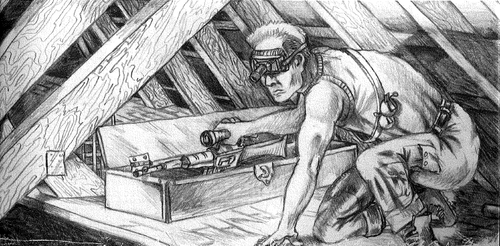
Solid Owl in Metal Gear Solid: Barns of the Patriots
Rules for amputation say that a called shot that reduces you to 0 life points can sever the targeted part, causing permanent reduction of life points and debilitating damage. Eldritch with regeneration can regrow severed limbs faster by holding them in place until they reattach.
Rules for asphyxiation and drowning are a simple affair doing debilitating damage each round, while the rules on damage from fire and sunlight provide much-needed illumination (ho, ho) for the creatures who are vulnerable to that stuff. Fire does damage based on intensity and exposure; sunlight is the same, with modifiers for thick clothing and cloudy days. There are even similar rules for exposure to burning chemicals and radiation.
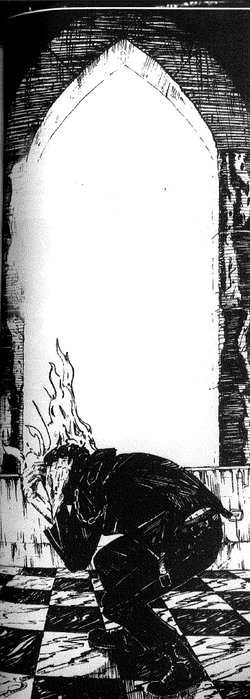
Always dilute the Dr. Bronner’s first.
There are lots more rules for ways you can die which are too tedious and too similar to a dozen other games to bother detailing here. There are rules for resisting torture with Spirit rolls, falling damage, frostbite, extreme heat, illness, and poisoning. We’re instructed that if a PC dies, “every effort should be made to make the moment a very dramatic one.” Dying heroes can perform one last action, and can linger until the end of a combat so they get the opportunity to give their dying soliloquy.
There are even more rules for emotions , and in practice they’re another way for the Guide to fuck over the PCs in the name of roleplaying! I am so completely surprised, aren’t you?
For example, being defeated in battle could temporarily give the entire party a Depression 3 Persona trait. A “tragic battle with werewolves” could inflict both Despair 4 and Hate Werewolves 5. The numerical values of these various forms of sadness come straight from the gothic darkness of Stephen Brown’s butthole.
If something happens that could provoke strong emotion in any of your Persona traits, you’re supposed to make a roll/draw. The more successes you get the more you “give in to emotion” and there is a fucking chart for this as well as suggestions that if you roll 3 successes to be sad, you should have a sad look on your face!
To my genuine surprise, giving in to emotion is not necessarily synonymous with getting fucked over by the Guide. There’s a list of emotions and the mechanical results of being overcome by them. Persona traits related to Fear, Lust, and Revulsion make you take penalties to your rolls, those related to Hatred and Love give you bonuses to attack or protect, and Rage gives bonuses to attack and penalties to defend. Dementia traits work the same as emotions for the purposes of these rules. Remember, this game refers to all mental illness as “Dementia” because it gets off on spooky Latin.
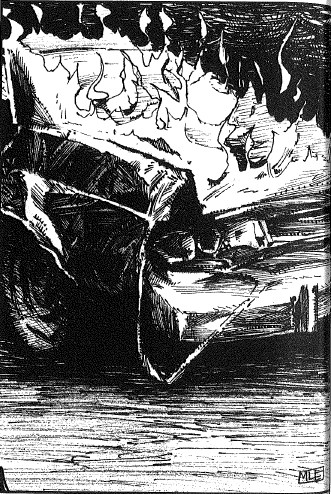
It is a game design metaphor.
Next time, on The Everlasting : Try to understand. He’s a magick man.
It’s a Magickal World, Lestat old buddy! Let’s go legendmaking!
Original SA post
Chapter 11, Part 2: It’s a Magickal World, Lestat old buddy! Let’s go legendmaking!
Magick in the Everlasting is based on an airy-fairy, hippie-dippy, crystal-waving I-think-you-get-the-point view of the universe, which is explained to us in a rambling fashion without adding any new detail to the setting. When the raw quintessence of the universe cohered into matter and energy, the first magicians appeared. They were called Worldsingers, because they had the power to simply will things into creation. Supposedly, they persist as the sort of “Secret Chiefs” that people like Helena Blavatsky and Dion Fortune wrote about.
Magick requires suspending belief in mundane laws of science and causality in order to tap into occult “reservoirs” of energy associated with gods and other dimensions and stuff. Magick can’t be scientifically tested or measured because doing magick requires believing that it will work.
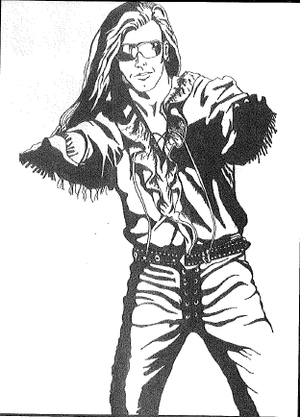
This guy doesn’t believe in the magick of zippers.
There is at least a full page on low magick vs. high magick, the “five powers of the magus” and other New Agey crap. None of it seems to matter in play, so I’m not detailing it. But here’s a clue that the author is a fruitbat:
quote:
A good way to explain magickal currents is to liken them to the poster for Pink Floyd’s Dark Side of the Moon. Raw magickal energy is the white light passing into the prism. On the opposite side of the prism, the white light is split into many different colors; these colors represent the magickal currents.The prism represents the mechanism by which the world itself adapts magickal energy to a usable form. The Worldsingers were part of the pure white light entering the prism. All magicians since the Worldsingers’ departure have utilized the various individual currents – the colored bands of light passing out of the prism. Magicians attune themselves to the particular currents of magick that work for them.
As an aside, an annoying thing about this chapter is the constant mention of Osirians. Osirians are the eldritch most attuned to magick, and when they cast magick it’s like they’re standing inside the Pink Floyd prism. Every single explanation of some aspect of the magick system has an aside mentioning that it’s easier for Osirians. I have nothing against Osirians; in fact, they sound like one of the most original and playable factions, but it’s yet another example of Brown’s tendency to lose focus on the book he’s actually writing and ramble on about PC classes covered in another book.
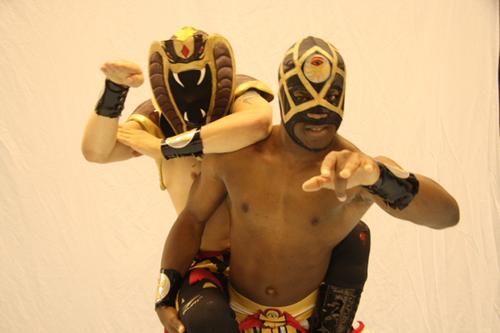
I would so much rather be playing these guys .
Most magickal effects can’t be plainly seen, even by eldritch. For example, even a spell that kills someone by summoning a spirit to tear out their soul will probably only be visible as a sudden heart attack. Instead, the main limits on magick are that it requires study, it’s draining, it leaves magickal traces, and it becomes much more difficult and draining if you need to pull a magickal effect out of your ass right now.
Casting spells, or, How to Drain Your Dragon
A magick effect consists of intent , subject , spellcasting type , and magnitude . This determines the Difficulty to cast it, and how much animus it costs.
Magickal effects in this game aren’t categorized according to what they accomplish from a gameplay point of view. (For example, Shadowrun, which has Combat, Detection, and Healing categories.) Nor are they categorized according to some geeky pseudo-physics internal to the setting. (For example, D&D 3rd edition, where teleport and acid arrow are both conjuration spells because they make a thing be in a place it wasn’t before, and cause fear and raise dead are both necromantic spells because of some hokum about “negative energy.”)
Instead, magick is classified as one of the “four intents .” These are ill-defined but unfortunately important, because they determine the base Difficulty of your spells. Spiritual magick usually takes the form of rituals and religious rites; it covers communing with spirit realms, astral travel, and for some reason, enchantment. Focus magick involves a being’s relationship with magick itself and is usually used to increase magickal power, take up or change a magickal path, or change someone’s sensitivity to magick. Mental magick is much easier to grasp and includes all kinds of telepathy, divination, and clairvoyance. Physical magick includes anything and everything that physically alters something, from shapeshifting to conjuring to throwing fireballs at people.
Subject is much more clear, and it determines how much animus the magick is going to cost you. The four subjects are self, ally, neutral , and hostile . Self is yourself, ally is a willing subject, neutral is something nonliving (like a door, or an area, or the weather) and hostile is any unwilling subject. In an example effect, it’s hostile magick to subtly influence a crowd of people so you can pass through them with ease.
Spellcasting type depends on whether you’re creating a spontaneous magickal effect, casting a rote spell (which is easier), performing a lengthy ritual (easier still), or enchanting something with a persistent magickal effect, which is not detailed here and is covered in a sourcebook.
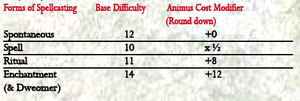
”Dweomer” sounds like something you call a wizard before shoving him in a locker.
Here, let the “Magick Matrix” help you figure out those Difficulty/cost modifiers in a flash!
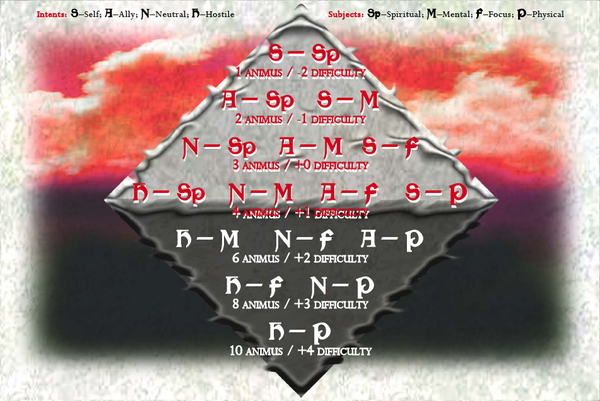
Shine on, you crazy fucking diamond.
Finally, Magnitude measures the complexity and blatancy of a magickal effect. Things that can be mistaken for “tricks” and sleight-of-hand are called cantrips, and are Magnitude 0, whereas any kind of blatant magic is at least Magnitude 1. The guidelines for magnitude are vague (of course), but Spells have a listed Magnitude, and there’s a helpful list of charts for broad categories of magick, from astral travel to teleportation, with examples of magnitude 1-5. For example, conjuring a napkin from your pocket is Magnitude 0, while conjuring a fully-functioning house is Magnitude 5. Especially powerful effects, like communing with a god, have a high complexity even if the effects aren’t obvious to mortals.
Now, how do you actually cast a spell? After those other four factors determine the Difficulty and the animus cost, the stats you use to roll/draw are Magickal Art and Magickal Lore . Each Magickal Path has an Art stat, representing raw power, and a Lore stat representing knowledge of the path. You have to buy these separately for every Path, so your magician can have Voodoo Art 3/Lore 4, and Shamanism Art 5/Lore 2.
You treat Art as your Aspect and Lore as your skill, and treat it like an ordinary skill check, drawing Aspect against Difficulty-Lore.
Odds and ends
Spell creation is actually pretty easy--to learn a given effect as a spell, you have to cast it spontaneously a few times, and pay its animus cost in XP. It’s up to the Guide to put restrictions on whether or not a magickal effect “belongs” to a given path. With XP and the Guide’s discretion, you can also convert spells from one Path to another.
Another peculiar rule is reservoirs . Basically, it’s possible to make an Art roll in order to draw animus from an occult reservoir of power. You can only access a given reservoir once per scene. The reservoirs any magician can use are ambience and “transitional energies.” Ambience is the inherent magickal power of, say, an ancient abandoned church or Stonehenge. Transitional energy is the free-floating raw magick available in certain astronomical events, like an equinox, solstice, or eclipse. Other reservoirs require magicians to swear oaths, undertake spiritual quests, etc. in order to be “attuned” to them; for example, you might be subject to a geas like Cú Chulainn in order to draw power from the faerie realm.
Magickal Paths
Hey, we finally get to look at various magickal paths , including the vampiric “blood magick” we’ve heard so much about. Each path gets a description along with what its practitioners call themselves, restrictions, bonuses and penalties to working different kinds of magick, and a long list of ritual methods and tools. The last is actually very useful for being evocative in a minimum of space, but since there are something like a few dozen implements listed for each path, it ends up being too vague, like the dozen “common” occupations listed for each vampire bloodline.
Bathoran Sanguimancy : Bathoran sanguimancers use their command over blood for divination, animating creatures from blood, and to heal or harm other creatures. They’re sworn to keep the Path within their bloodline, and being an initiated member involves quite a lot of murder and human sacrifice, to the point where they gain points in Cruelty as their Art advances. Their most interesting ritual methods include surgical tools, razor wire, and torture devices as well as “traditional” witchcraft tools like pentagrams, candles, and goblets of blood. These bitches are walking talking Rob Zombie movies.
Bruja Magick : The cihuatateo have been practicing magick stretching all the way back to the ancient Moche culture in honor of their bloodthirsty spider god. Their magick focuses on illusions, dreams, and power over animals. Like the Bathora, they keep the Path within their bloodline, and initiation requires an astral journey to visit the Decapitator himself to be found worthy...or not. Their ritual tools include masks, costumes, body paint, and all kinds of things you would associate with Native American mysticism, not to mention pyramids, idols, and sacred numerology and astrology.
Obayifo Necromancy : All the damn vampires! Obayifo have an ancient form of necromancy reminiscent of voodoo, but it’s much older than the religious syncretism that produced voodoo. It’s not quite as focused on zombies and spooky curses and such as you might expect; the focus is more on astral travel and control over spirits and ghosts. Obayifo methods include a lot of shocking, frenzied activities like ecstatic dancing, sleep deprivation and drug use, not to mention offerings ranging from prayer and food to human sacrifice. Bokors choose spirit patrons whom they must serve from time to time, and over time they acquire Persona traits making them more like their patrons.
Solomaris : This is a spooooky synthesis of alchemy, necromancy, Hermetic magick and mad science, supposedly invented by the first ghul, Azazel, and built upon by his “descendants.” It’s a very broad school of magick, but receives bonuses to working with potions, dead souls, and inanimate subjects, not to mention brewing Anecro and crafting Skinsuits. Students become “Solomars” by apprenticing under a master and undertaking a pilgrimage to the Underworld. It appears the author was a little hazy on what ghul magick involves, since their most notable ritual tools include such things as “dramatic rituals” and “arcane incantations in ancient gibberish” along with stuff like sacred geometry and building strange mad science devices involving chemicals and electricity. Ghul magick requires a lot of study; the primary effect it has on its practitioners is that over time they become more eccentric and secluded, even from other ghuls, and have to spend hours in study each week or take penalties on their magick rolls.
Uh, that’s all. For once, this book actually focused on the playable character types it contains, so we only get details on undead-specific magickal paths.
Types of Magick
Let it not be said that I’m an Internet bully. I have to give credit where credit is due, and I like the fact that Everlasting gives a list of broad categories of magick with Magnitude listings for each, like so:
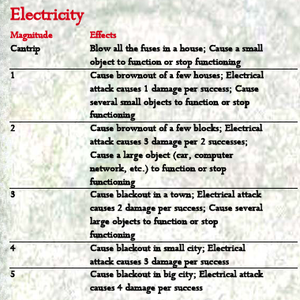
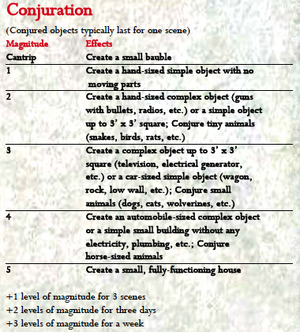
Maybe it’s because I’m carefully reading this book as a 30-year-old whereas I was an impatient 13-year-old when I read Mage: the Ascension , but having a scale of Magnitude is easier for me to sort out than Mage ’s iffy coincidental/vulgar dichotomy. The biggest problem with it is that it gives a lot of focus to astral travel, dream magick, and controlling spirits, which aren’t really detailed in this book. On the whole, I think it does a good job of squeezing a freeform magick system into limited pagecount...but the one the Osirians get is probably better.
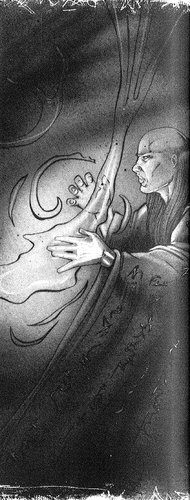
Even Osirian magick can’t cure mage-pattern baldness.
Spiritual magick:
Astral : Ranges from simply navigating the Astra to traveling through time via the Astra.
Blessings and curses : Cantrips create minor instances of good or bad luck, greater affects influence Destiny and Backlash points, while Magnitude 5 effects are beyond the scope of such things and negotiated between the PC and the Guide.
Dream : Like the Astra, but for the Dreamworlds.
Spirit alteration : Allows you to heal and transform spirits, from minor cosmetic augmentations up to completing remaking their astral body.
Spirit control : The magnitude measures the experience level of the spirit you can command.
Spirit possession : This allows you to exorcise or channel spirits into yourself or others; greater magnitude allows you to control a more powerful spirit, or use the abilities of a spirit you’re channeling.
Spirit shield : Bonus cards/dice to resist any actions by spirits.
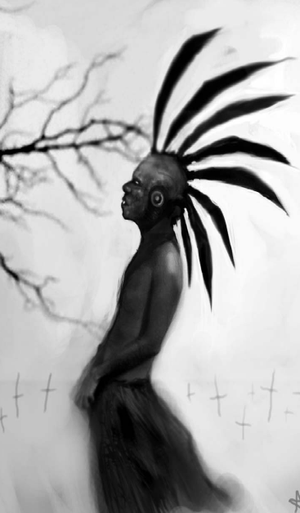
Finally, headphones that won’t muss your mohawk!
Focus magick :
Anti-Magick Shield : Does what it says. This is for use in combat, so you can’t walk around immune to magick at all times. All of the “shield” categories can only be cast once in a scene.
Communion with Higher Forces : Cantrips allow for mysterious hints and portents, whereas Magnitude 5 will net you a god to personally escort you on a vision quest.
Countermagick : This allows you to dispel an effect of the matching Magnitude. At a penalty, you can cause spells to fizzle as they’re being cast.
Magick Sensitivity : Allows you to sense magick and eldritch, and at higher levels, you can make the Reverie manifest itself in the real world.
Mental magick :
Cause Insanity : Creates temporary Dementia qualities with points based on the Magnitude and number of successes.
Clairvoyance : Ranges from remote viewing within the same room to spying on an acquaintance on another continent.
Divination : A cantrip will grant a flash of intuition, whereas a Magnitude 5 spell will give you an overview of the Web of Destiny itself.
Domination : Even a cantrip can give you bonuses to social rolls, but more powerful effects create full-on mind control and even enhancing people’s Aspects by granting them confidence.
Illusions : Cantrips can create a nonexistent odor or cause someone to see something out of the corner of their eye, whereas powerful effects can trap victims in an illusory world.
Mental attack : Ranges from causing mild irritation and distraction to agonizing pain or knocking someone out.
Telepathy : Sensing nearby minds, ranging up to transmitting an entire lifetime’s worth of memories in a few seconds.
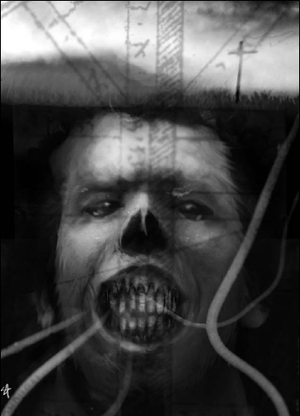
Clearly in need of a dental wizard.
Physical magick :
Air, Earth, Electricity, Fire, Ice : Invoking the elements lets you control a 10 square foot area times Magnitude; when used in offensive spells, you do Magnitude damage per success.
Conjuration : Summons something from nothing. Cantrips let you summon an insignificant bauble, whereas greater Magnitude allows you to summon tools, weapons, even a house.
Healing : Magnitude determines how many Life Points you can heal per success; Magnitude 5 allows reviving the recently-dead.
Physical Boost : Boosts the Body Aspect; Magnitude determines points per success.
Telekinesis : Does what it says, including flight. Magnitude determines pounds per success or speed of flight.
Teleportation : Works on people and objects. Magnitude determines distance and the mass you can teleport.
Additional Guidelines, or how to be a schizophrenic junkie rapist at the mall food court
For some reason, there are more “advanced guidelines” squeezed in at the end of the chapter after the magick rules. First is addiction . Every time you use an addictive substance there’s a chance, based on the frequency of use and the strength of the substance, that you’ll become addicted. Strangely, we aren’t specifically instructed to add points to Persona traits.

Clive Barker’s The Scream
Aging is simple. For every five years after age 55, mortals draw (age/10) cards against Difficulty 9-11 (Guide’s choice). For each “success” they lose 1 Aspect point (Guide’s choice). The Guide is instructed to frequently remind eldritch characters that all the mortals they love are inevitably going to die. Who waaants to liiive foreveeer, yeah, we get it.
Awakening mortals to the supernatural is a hilarious process. To spontaneously awaken, a mortal must witness supernatural happenings and get a Disaster result on an Intellect+Rationalize roll. Then, they have to get 3 successes on an Inspiration check. So the kind of people who become “fantasts” are the same sort of people as the kind I can see actually playing this game: artsy but dumb as a bag of hair.
Strength and encumbrance takes the form of a chart listing maximum lifting weight (but not carrying weight), leaping height and distance, and throwing distance. An eldritch with Strength 13 can lift 5 tons.
There are rules for hunting mortals with a simple roll. You simply choose your method: stalker (mugging), monster (intimidation), romantic (date rapist), kidnapper (yep), or thief (cat burglar) and check the appropriate Aspect+Skill. More successes mean an easier hunt; Disaster means you got caught and ran into some kind of trouble.
Detecting magick is a Perception+Illumination check, with bonuses or penalties based on proximity and animus spent. Lots of successes allows you to trace the effect right to the source.
There’s a chart for “ Resilience feats ,” like forced marching, hard labor, holding your breath, etc. It is boring.
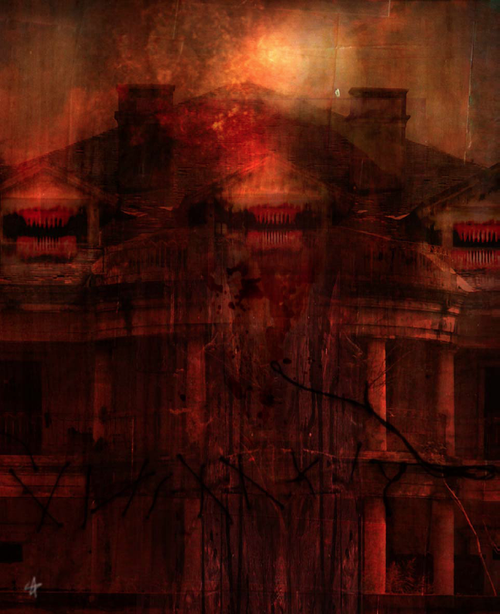
The House that Dripped Pretense
The next section is about perceiving the Reverie and it’s confusing as hell. Whenever you’re trying to perceive the Reverie or something supernatural happens around you, you make an Inspiration+Illumination roll, and more successes means you perceive the Reverie more fully, from noticing slight changes in lighting all the way up to physically vanishing into the Reverie. We’re told that “There are said to be at least 13 levels of the Reverie, but no eldritch has been able to verify this claim, so there may be even deeper levels,” as if that means anything. So, uh, what if I get enough successes to physically step into an alternate dimension, what if there’s not actually a portal to the otherlands here? Does that mean that the Reverie is everywhere, and if I do a really good job of noticing a spell I might vanish into Never Never Land?
Like everything else concerning the Reverie, this seems like a half-formed idea, a mental cloud of stuff Stephen Brown saw in movies. The problem is not that it’s unoriginal, though, it’s that he can’t define it concretely enough for it to be useful in gameplay or even convey it in sensible language. The quote at the beginning of this section is from Hellraiser ’s Pinhead, and it seems like the idea he was going for was stories where characters can take a turn or go through a door and suddenly be in a different world without anything as obvious as a glowing magic portal, from The Secret Garden to Silent Hill . Again, it’s poorly conveyed, and it drones on and on about dimmed lighting, “changes in mood,” weird smells, ghostly figures, psychic vibrations, crystal blue persuasions, and did I mention lighting and mood? I think this book may be Stephen C. Brown’s way of asking me out to a candlelit dinner. Unfortunately, I am not impressed by his Bullshit Vampire Narnia and I wish he’d shut the fuck up about the mystical power of his imagination. All this Reverie crap is like astronaut food; it may seem novel at first, but it’s insipid pabulum for space cadets.
Okay. Okay. Deep breaths. Uh, moving on...there are rules for running and swimming , fuck that.
There are more rules for Torment and Degradation , but not really. There’s a totally pointless chart with Difficulties to resist Torment and descriptions ranging from “slight compulsion” to “super-intense urge to obey Torment.” Again, too vague and stupid to be worth putting numbers to it.
Freeformin’ now I’m freeformin’
The Everlasting discusses the different methods of task resolution (cards, dice, freeform) and seriously instructs you that your group should take a democratic vote on what kind of rules to use. (What? But the introduction chapter said that each participant gets to choose their own method!) You’re also meant to be going through a process of “rules creation” in which you decide which optional rules to include and not include in the first session of play. Ooh, a pretentious 90s narrative-obsessed campaign where we also spend the first few sessions arguing about how bullets should work against vampires? Sounds fun!
There is also the suggestion of totally freeforming it. The book spends 227 words explaining how to just make shit up.
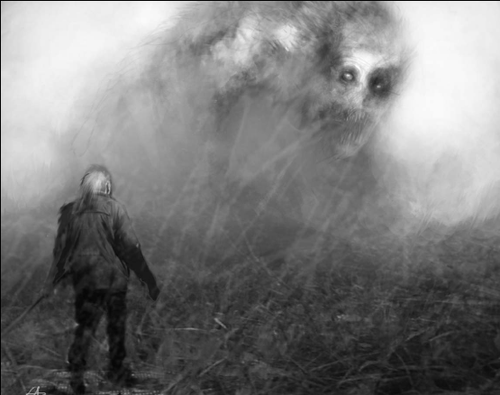
Poor Ithaqua. Reduced to trolling for victims at field raves.
Finally there are a couple pages of rules for LARPing . Yes, rules, because live action is the only thing that has definite rules: no weapons, no physically dangerous activity, no unruly players allowed, no playing in places where you’ll scare passersby, and no touching . Unfortunately, we are told, LARPing “cannot capture the altered state of consciousness achieved through table-top legendmaking,” but it has the advantage of never being boring (ha!) and allowing you to pretend you can act.
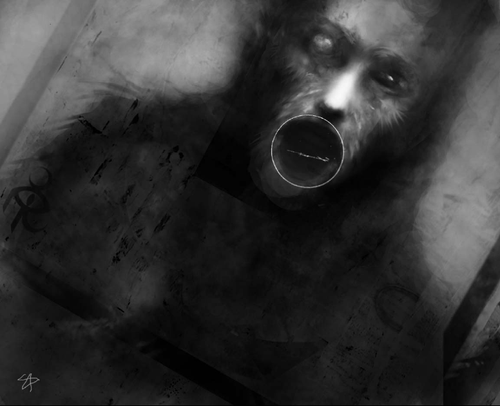
The first rule of LARP club is don’t eat safety pins.
As somebody who LARPs very little, it seems like a common-sense set of guidelines for LARPing about staying in character and such. But notably, characters have the same stats, and there are no suggestions for simpler rules and easier resolution with rock-paper-scissors or whatever. I guess everyone has to carry around a deck of cards. The norms really will think you’re gothic magicians!
Next time, on The Everlasting : Storytelling. Not to be confused with legendmaking.
Storytelling: Rediscovering the Magick of Life.
Original SA post
Chapter 12: Storytelling: Rediscovering the Magick of Life.
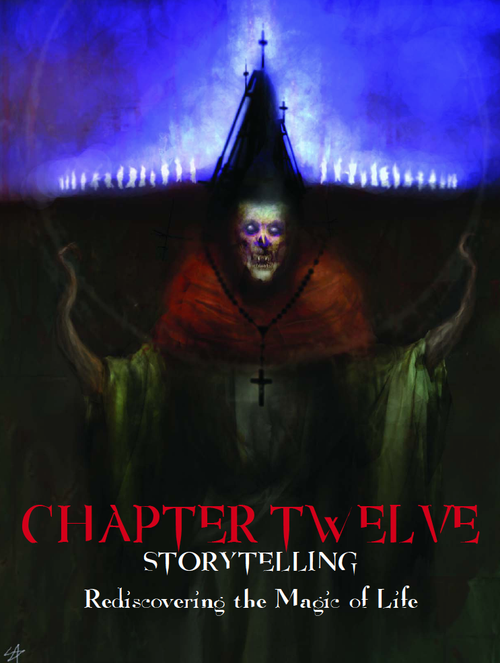
Rediscover the magick of fireflies building a church on your sweet zombie hat.
This is the chapter where Everlasting lays out all its roleplaying and gamemastering advice, and it starts out...pretty damn good. Everyone at the table is a storyteller. Nobody’s fun/character is more important than anyone else’s. Keep everyone involved. Stress teamwork, but give everyone a chance to shine. “Winning” and accumulating power isn’t the most important thing. Everyone should try to embody their character and stay in character, but honest effort is what deserves the most reward. Accept criticism, and be prepared to improvise. So far, so good. Then it jumps off the deep end.
There is a page on different “ approaches to the mythic system ,” a fancy way of discussing what the game will actually be about. It’s obvious that despite the author’s protestations, Everlasting is meant to be a setting in which you can hopefully tell many different types of stories, rather than a setting built around a theme. (And that’s okay. Not every game needs to be a tightly-focused narrative indie game.) The advice here, though, is several different ways of saying. “This is a thing you can do, just don’t do it too much.” Action is fun, but too much combat is a lot of meaningless die-rolling. In-depth roleplaying is fun, but too much and nothing actually happens. Intrigue is good, but too much becomes ridiculous and the Guide won’t be able to keep it all straight, and so on.
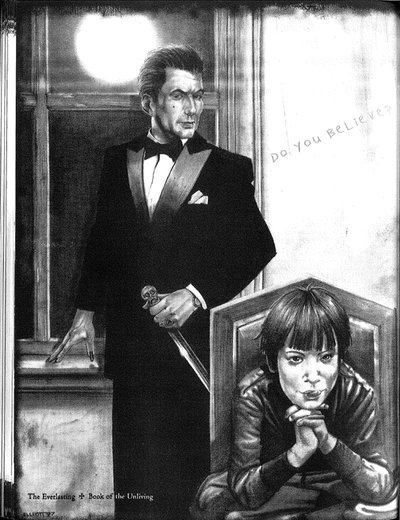
Do you believe this sweet swordcane was only $19.99 on BUDK.com?
The advice on hosting a game session is mostly common-sense stuff, but assumes that you’re going to play for hours and hours, “often into the wee hours of the night (and sometimes on into the next day).” Granted, in the 90s I also believed that this was a necessary part of roleplaying, but I was in high school, and since then I haven’t had enough free time for that kind of gaming. I would rather they give useful advice on how to cram a satisfying legendmaking experience into 2-3 hours. Instead there is ho-hum stuff like “CDs of sound effects are good” and “pizza is tasty.”
It’s suggested that the Guide receive rewards along with the players. This can take the form of XP for a character in someone else’s game, or even cash and gifts, under the rationale that we tip waiters for good service. Then it suggests putting time limits on scenes and sessions to prevent boredom and playing into the aforementioned wee hours of the morning, but like everything related to the Persona traits, it does so in the most fussy and mathematical way it can. It’s recommended for the Guide to estimate how long they think a scene will take, allot 2/3rds for the main plot and 1/3rd for the secondary plot, and allot 25% of overall time for scenes that overrun the time limit.
What follows is an example of play--sorry, example of legendmaking. How do I keep forgetting that?
quote:
Four people have gathered in a basement for a night of legendmaking. They have exchanged the light bulbs for red lights and have placed some lit candles on the large table they are seated around. Also on the table are two fake skulls, hand-scrawled directions to a haunted house on what looks to be the brown paper of a grocery sack, and everyone’s cards, dice, and protagonist profiles.
Okay, it’s nice to see that Everlasting hasn’t just unceremoniously dispensed with all those half-baked GMing experiments it rambled about in the introduction. Assuming this game actually happened, and the participants actually divided up the GM’s duties this way, actually getting legendmaking done must have been a lurching, crippled miracle, like three handicapped kids in a trenchcoat sneaking in to see Underworld .
Because SteveNate is Guiding and playing at the same time, he describes everything with what sounds like the royal “we” of a king’s footman or a frustrated dental hygienist. “As the scene opens we find ourselves walking stealthily through a dark wood, led by Avery the ghost.” Avery the ghost was murdered by Efram the necromancer, and now he’s leading the party to the necromancer’s dilapidated mansion. They beat up some zombie minions, and while breaking into the house, SteveNate rolls a Disaster, and thus has to decide what kind of bad thing happens to his own character. He steps through a rotten board, spoiling the element of surprise and attracting a mob of ghosts and zombies. The example of legendmaking ends on a cliffhanger as someone pulls out a submachine gun.
Some choice quotes:
quote:
I’ll bet you those dead souls are supposed to get put into the corpses over there in those graves.
quote:
You don’t mess me up, genitor. Stay clear so I can do some killin’.
quote:
(Directing Alexandra’s anger at Grauss) You bastard. I’m gonna rip you limb from limb, and your soul too if I can catch it. (Marie and Alexandra’s relationship and the strength of their friendship were modeled on Owen’s friendship with one of his own friends, so Owen knows that Alexandra is really mad.)
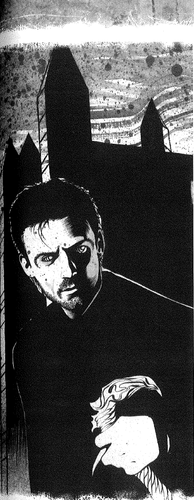
And this one was $15 at the flea market!
Adventure Creation
There is a large section on crafting campaigns . At this point, reviewing the chapter becomes difficult. This section is divided into Conflict, Plot, Theme, Construction, Character, Special Elements, Storytelling Tools, and Special Storytelling Techniques. Does that start to sound redundant? It is, and it scatters topics around while wandering aimlessly among them. Advice on details, like cue cards and props, are stuck in between treatments of more holistic issues like plot and theme.
It’s possible that I’m being too harsh on Everlasting compared to other games published in the same era. (If I had any of my 1st and 2nd edition World of Darkness books at hand, I’d skim them for comparison.) That said, a big problem with most of the discussion of storytelling in this chapter is that it often consists merely of lists of things , along with frequent reminders to make this important or that important, without really telling you how or even defining terms, and the facile advice that you could do this or you could also do this other thing. Plots and motivations are especially prone to being conveyed through lists of possibilities, whereas stuff like “mood” and atmosphere” are often subject to nagging reminders. “Don’t leave the house without remembering that it’s every player’s responsibility to maintain the atmosphere! Your campaign will catch its death of bathos!” Yes, Grandma.
It begins with the suggestion that you define the central conflict of the campaign. Most of these boil down to one faction of monsters opposing another in a gang war, in fine White Wolf tradition. Dominion vs. Dominion, Dominion vs. Intruders, Faction vs. Faction, Genos vs. Genos, etc. Then there are very vague ones, like “Immortal vs. Self” for a game focusing on Torment, “Immortal vs. Mortals,” which is very broad, and even more vague stuff like “Law vs. Chaos.” “Ancients vs. Ancients” would presumably work like Vampire’s Jyhad, of course, but we have little sense of the ancient eldritch in the setting and what they want. “Daevan Household vs. Kingdom of Night:” is kind of interesting because the daevas are at the center of the metaplot, and the daeva families are getting weaker while the Kingdoms of Night are getting stronger. Too bad we don’t have stats for daevas, or any reason to care about them. (And hey, looks like the author decided whether they’re “courts” or “kingdoms.”)
Next we are advised to come up with a high-concept central plot in the form of a one-sentence description of what the game will be about. The given examples are “the party exorcises the many spirits in a haunted house” and “the party busts a human trafficking ring making people into eldritch food.”
Everlasting is also kind of hung up on subplots , which it seems to define as an episodic adventure that’s somewhat tangential to the plot. As you’ve already read, it suggests weird things like specifically allotting time to subplots and having a different person GM when a subplot comes up. It recommends subplots either centered on a single protagonist and their motivations, “historical subplots” which take the form of continuity-establishing flashbacks (because this game needs more excuses to imitate “Highlander: the Series”), or Very Special Episodes wherein, for example, the players play NPC ghosts who visit their regular PCs to warn them about evil necromancers (or perhaps the consequences of losing their Christmas spirit).
Next comes a section on creating NPCs , but it’s mostly concerned with antagonists . The advice here is listy but pretty solid; a good antagonist usually believes they’re in the right, you should consider the villain’s perspective and what they’re doing when they’re doing when they’re not menacing the PCs, and their villainy should be conveyed to the PCs in a show-don’t-tell fashion. There’s also a list of types of villains, encompassing the villain’s nature and/or how they go about menacing the party, from misunderstood creatures to simple maniacs to mysterious schemers or corruptors. Following this is a single paragraph on, well, all the other PCs, dividing them into helpful, neutral, and opposing.
After this we get a very long list of examples of action and suspense without combat , including things like car chases, being detained by police, and some questionable ones like “showing off to impress others.” I wish more games did something similar, but not in the form of a 1½ page list.
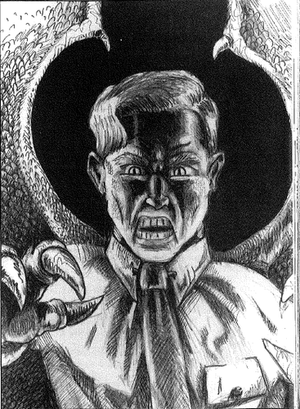
Don't look, dadragon! I'm legendmaking, okay? Can't a guy let a little privacy in this house?
The page on adventure construction recommends dividing your story into an introduction, body, transitional scenes, climax, and a denouement, as if it’s advising you on crafting a short story or screenplay. It suggests dividing the story into “chapters” if it’s going to take more than one session, and I think you’ll agree there’s a structural mishmash here that doesn’t quite work. By the way, it even suggests training montages as one example of a transitional scene. Cause you’re the best! Around! Nothing’s ever gonna keep you down! Unless they chop off your head or put a stake in your heart and leave you out in the sun. Afterward there are a few paragraphs suggesting you keep cue cards with notes on everything from the plot outline and planned scenes to locations, supporting characters, and even important magick items.
The pages on Special Story Elements , Storytelling Tools , and Special Storytelling Techniques are collectively a big grab-bag of 1-3 paragraph long sections providing tips on storytelling details, some useful, some less so. The division between sections doesn’t make sense; any topic from one section could go in one of the others. I’m at a loss to summarize the whole thing, but going through it page-by-page would be redundant and plodding. Here’s the Cliff’s notes:
Dream sequences : Wankity wank.
Flashback sequences : Wanky wankity Highlander wankity wank.
Epilogues , Prologues : Have scenes that don’t actually include the PCs, but show the players what happened before or after the adventure, like maybe a villain escaped on a boat. More evidence that this game is based on too much late-night television.
Foreshadowing : It’s good. You should foreshadow things.
Story Handouts : Have you ever used these? In a game that wasn’t Call of Cthulhu ? Me neither.
Humor : Humor is good! Be funny.
Plot devices : Your plots should have devices.
Surrealism : Have you ever considered making your games like "Twin Peaks?" No?
Symbolism : It’s good. Your game should have symbols.
Appearance : There is the understandable suggestion that you not wear a Hawaiian shirt while trying to scare the shit out of your players, and the less-understandable suggestion that you reward players for wearing period costume, and even that the entire group wear costumes and makeup, up to and including liquid latex zombie and ghul makeup.
Conversations prior to Sessions : To set the mood, you could talk about Stephen King or “The X-Files” before you play. Okay.
Lighting : Candles. Coloured lights. Remember to keep a flashlight so you can find the bathroom.
Music and Sound Effects : Music. Sound Effects.
Locations : If you’re going to LARP, you should LARP in...a location of some kind.
Props and decorations : “Most participants are happy just to experience legendmaking without going to any trouble to decorate or bring out props.” But why not decorate your gaming table with skulls and swords and a bunch of other geeky shit you bought online?
Seasons and Weather : A treatise on different seasons and how different adventures could be set in different seasons. I don’t know why (for example) demons are associated with autumn, but then again, the cast of “Supernatural” is always dressed like they’re hiking the Appalachian trail in October.
Smells : Have you ever considered evoking a forested setting by covering the table in pine straw, or burning incense whenever a recurring villain appears? No, you haven’t, because you’re not a goddamned lunatic.
Endangerment of Protagonists or Things They Value : Do this.
Handling Boring Scenes : Wrap it up, eldritchailures.
Imagery : Remember to describe things.
Motivation : Give the PCs this.
Mystery : Not bloody likely when you’re GMing and playing at the same time.
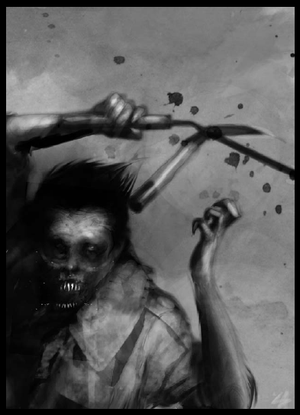
Oh look, exactly what this chapter needs!
Here’s an aside that probably won’t make sense to anyone, but fuck you, it’s my show. I started the season’s rugby practice last night, and I was really lost. I knew that my skills would be rusty, since I’m a novice and I missed the whole last season to injury. But it’s striking when you realize how difficult it is to not only perform basic skills like keeping pace with your teammates, maintaining a defensive line, catching, passing, tackling, and so on...but to do all of these things simultaneously, or in sequence, when someone else is trying to stop you. If our coach just blathered “Run good. Stay in your zone. Keep pace. Stay on the point man. Keep the line. Tackle. Tackle like this. Put your hands out to catch. Remember what I said about zoning. Pass good, don’t pass bad,” he’d be as bad at coaching as The Everlasting is at teaching us how to run...whatever kind of game it thinks it’s trying to be. And if he suggested that the whole team do a haka before every drill or dress up in Jonah Lomu costumes, he’d be just as crazy, too.
Next time, on The Everlasting :

 Xv*~LEGENDMAKING~*vX
Xv*~LEGENDMAKING~*vX


Legendmaking Part 1: This Joke Breaks Wikis
Original SA post Chapter 13, Legendmaking Part 1: [REDACTED] the [REDACTED] of [REDACTED]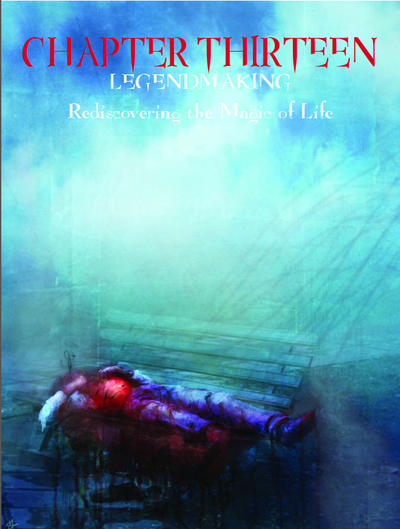
If I think of a better metaphor for this chapter than a guy running with scissors until he gives himself a lobotomy, I’ll tell you.
The “Legendmaking” chapter is unique insofar as there are two versions of it: one from the original print edition, and a very different version in the PDF release. It’s no coincidence that the “Legendmaking” chapter corresponds to the mystical thirteen , and the original version does indeed contain all the New Agey bullshit you might have heard rumours about : ceremonies, guided meditation, and more candles than your girlfriend’s bathroom closet.
It seems that when the creators released the PDF version, they were a little more collected and at little embarrassed, and cut out most of the hocus-pocus. I will argue that they weren’t nearly embarrassed enough , because what we get instead is a preachy 7-page essay on “living mythically,” and it is incredibly tiresome. Slogging through all the homily and hokum was like shoveling unicorn shit; it may be unique and magical, but it’s still horseshit, and it stinks.
Regardless of which version of the chapter you’re reading, it begins with a sermon on Personal Mythology . Most of us, we are told, are so wrapped up in worrying about our jobs and families to truly experience magic and myth, but it's not too late! The Everlasting is here to help you "explore your personal mythology" by using your player character as a repository of your greatest hopes and fears. That certainly sounds healthy!
By the way, while the ideas in this chapter are crazy and stupid, the tone is more like that of a kindergarten teacher who doesn’t know how to stop being patronizing when not speaking to little children. Behold:
quote:
We have given up all our dreams, imagination, and aspirations in life in exchange for security and stability.We are happy to just sit back and let other people entertain us with their stories, without any effort on our part. But it is never, ever too late to rediscover the wonders of life… all we have to do is try.
Storytelling, we are told, is a ritual as old as the oldest humans, and from the stories that "had the greatest value and meaning" to the cultures that created them, we get the first myths. Myths are the stories that give meaning to our lives and give us a sense of our place in the universe. The author believes that the "main problem" of the modern age is that we haven't found our new mythology.
This is why " The Everlasting is more than a roleplaying game; it is a tool for mythic experiences." It's designed to help you create stories which have deep personal meaning which you share with your fellow participants, and which you can use to examine your life, question and reevaluate your beliefs, and achieve greater enlightenment and spirituality. Isn't that exciting? So what is "legendmaking" and how is it different from roleplaying? Simply put, legendmaking combines roleplaying with mystical rituals and meditation exercises, with the end goal of self-improvement.
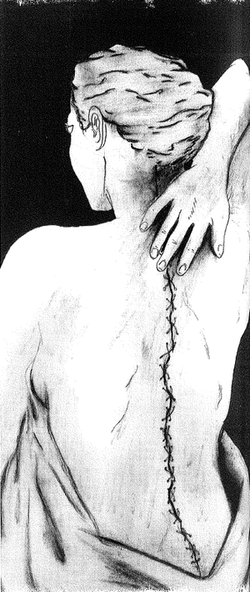
Be a dear and zip me up.
The key to understanding what Stephen Brown is trying to communicate is understanding that his entire theory of mind revolves around the idea of "personal mythology." Everyone, he believes, has a personal mythology that is a highly individualized version of the mythology of their culture. Most people in the modern age really understand mythology because we're so inundated by cultural memes that we can't see the big picture. As a result, "long-enduring myths are not holding up." This is good and bad, because it allows for greater individuality, but leaves many people lost and with no understanding of why they do what they do.
Popular songs, television shows, books, films, art, advertising, and news all contain "mythic images" that impact our culture, and we look for guidance from athletes, musicians, politicians, and other celebrities. In short, Brown conflates absolutely any kind of media with mythology, and any kind of public figure with mythic heroes--given examples of "heroes" include Michael Jordan, Mahatma Gandhi, Bill Gates, Batman, the President, and the Terminator.
As a general rule, I'm sympathetic to the idea that fleeting cultural memes and influences may influence our thinking much more than we realize, and are worthy of study. (That is, until my Facebook feed is flooded with clickbait articles purporting to discuss the implicit bigotry in something on television, coming to the facile conclusion that it's "problematic." I digress.) That said, Brown takes every aspect of the human experience, which could be approached differently through anthropology, sociology, psychology, or media criticism, and chucks it all into a big sack marked "personal mythology." It's ironic that in the process, he utterly trivializes the word "myth” to the point of losing all meaning. He even goes so far as to say that “"Every thought and deed you have performed or witnessed has been a stroke upon the tapestry of your personal mythology." Every experience you have supposedly contributes to your personal mythology, and Lady Gaga and Gilgamesh are grouped together as "mythic images." We're dealing with an intellect that can't draw a categorical distinction between Barack Obama and Bruce Wayne.
The whole endeavour comes across as incredibly sophomoric, with Brown taking the role of That Guy in your introductory philosophy class who just read a book that changed his life because it explains everything, and surely it will change you too, if you let him drone on and on long enough. The book in question is Joseph Campbell's Hero with a Thousand Faces , which is quoted several times along with such great thinkers as Sophocles, Shakespeare, George Bernard Shaw, and someone named Lord Pumpkin.
It's lazy and facile in its attempt to be a comprehensive Theory of Everything, and verges on being offensive in its treatment of psychological problems. It is true that you could take some concepts from humanistic psychology and rephrase them as "myths" and "living mythically" rather than "values" and "mindfulness," but this becomes downright insane when it leads to suggesting that you resolve your deep-seated personal issues by practicing meditation exercises to get in touch with an imaginary character.
Critiquing Campbell, Goldenberg, or psychoanalysis at large is beyond the scope of this review. For that matter, so is critiquing Stephen Brown's syncretic New Age mysticism per se. As for "legendmaking" and the bizarre practices he suggests you use to transform roleplaying into therapy...I have some things to say about that.
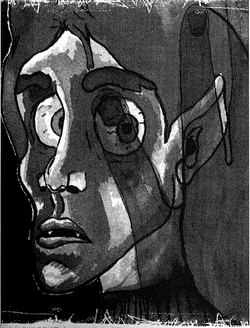
Where the art budget ends, legendmaking begins.
How does Brown recommend we reconnect with mythology and find meaning in our lives? The answer is “living mythically.” Living mythically means “understanding that there are underlying forces at work in your unconscious mind that play themselves out in your life,” developing “the power to choose who you are,” and learning to make “better, more creative, and self-empowering choices within your life.” Brown asserts that when your values conflict and your actions don’t align with your beliefs, these are “warning signs from your unconscious mind that you need to renew your mythology.” In fact, “People who suffer stress and nameless anxiety may be following myths that are not attuned to their needs.”
In other words, any healthy, well-adjusted, self-aware person is “living mythically.” As someone who’s completed a course of therapy, I can tell you that psychologists--the kind who actually help people instead of musing about the Goddess--refer to this active and empowering self-awareness as mindfulness, and there are many therapeutic techniques designed to develop it. None of them involve pretending to be a zombie with a machine gun.
To be fair, the “personal mythology” and “living mythically” approaches to psychology aren’t Brown’s own invention; Brown quotes the terms as used by feminist theologian Naomi Goldenberg, and the concept traces its lineage to Jung. But when Brown implies that the difference between Nicki Minaj and the Nowell Codex is one of degree, that’s his own problem.
Creating Personal Mythology
Now The Everlasting is ready to actually tell us how to legendmake ourselves some seriously personal myths, beginning with direct quotes from Joseph Campbell. Unfortunately, the advice here follows the familiar “Don’t forget to do…” style from the last chapter, without actually giving examples or concrete advice on how to implement these principles using the characters and setting the game presents.
The first is “The mythology should reveal the wonder and mystery of the universe and one’s self.” That means you should evoke mystery and wonder. Who knew?
Second is that “The mythology should provide form to the cosmos while retaining its mystical qualities.” This means your game should have structure, like a sonnet. Uh, more specifically it should have a basis in realism, then embellish it with mystical stuff. I can’t think of a better setting for that than 90s gothic action horror where the world is like the real world but the skyscrapers have gargoyles and also the milkman is a vampire.
Third, “The mythology should provide validation and support to a certain social order.” That means your game should take a moral stance on what’s right and just, and even if the characters deviate it, the story shows the consequences of their actions. This is the point where I must ask, if this game wants you to get really invested in your characters and use them as tools for self-reflection and personal growth, was it a good idea to write most of the character types in this game as self-centered undead serial killers?
Finally, “The mythology should teach people about living.” This means your game should teach the players things, but you should be subtle about it.
Another really important topic (you should make this important in your game) is Symbolism . The game should have symbols, totally. In fact, the players should all make a list of symbols that mean things to them so that the Guide can include them in the game. Oh, but be careful with symbols because they don’t always mean the same thing to everyone! If there’s someone new in the game, or you’re afraid a player has forgotten the symbolism, you can use subtle clues to bring them up to speed. For example, if the players agreed that a wise old woman represents Mother Earth, you could say “You meet a very old wise woman living at the edge of the forest. Her eyes are bright green and there is a lot of life in the woman. Her hands are soiled because she has been tending her small garden. She tells you the history of the land and how the humans have destroyed it.” Oh no, not the land! Those damn dirty humans! Remember: subtlety.
So. Symbols. Important.
There is a section on Exploring Yourself , and it’s...well, it’s not literally a guide to masturbation. The Everlasting recommends that you make your game experience mythic by weaving symbolism from your own life into characters and events in the story. You’re encouraged to project “deep-rooted personal beliefs, emotions, and experiences” onto characters, your own and otherwise.Thus you can vicariously achieve your goals, relive past experiences, and thus examine your own life.
We’re warned not to emotionally invest ourselves in our campaigns too much, because that might actually lead to a negative emotional experience! For example, if you have a romantic crush and you project that onto how your character feels about an NPC, imagine how you’d feel if that NPC was killed! (Nevermind that it would be pathetic and creepy.) Or, you know, your family could have you committed because you decided you were too bound by “mundane concerns” and decided to seek personal growth by pretending to be a psychopathic vampire while practicing witchcraft in a basement with red light bulbs.
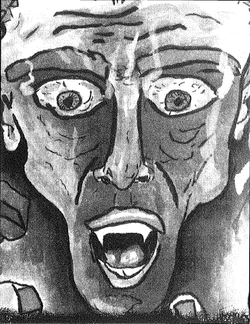
Where we’re going, we won’t need an art budget.
Spell, Book, and Candle
People use rituals to acknowledge important life events, like births, deaths, marriages, graduations, and so on. Since pretending to be a ghost is at least as important as any of these, The Everlasting recommends a special opening ceremony to get everyone in the proper mood and remind them that this is no mere roleplaying, but legendmaking.
The ceremony starts with everyone “agreeing to start since the ceremony requires everyone to be quiet, serious, and attentive. If participants are not going to take the ceremony serious then it will hold no value in setting apart the legendmaking.” I mean it, Todd! I don’t care if you can burp the alphabet backwards, tonight’s the night that Konstantinos Ravynchylde becomes a lord of the underworld and I don’t want you screwing up my mythology!
After agreeing to take all this very seriously so that our legendmaking will have a “mythic quality,” it’s recommended that we have low lighting, soft music playing the background, and a candle for every participant. (At this point, you could just ask the players out on a date to see an Air Supply concert.) Okay, now I’ll stop cracking wise and just quote the ceremony in its entirety:
The Guide posted:
Here we gather, we who seek admittance into the Secret World of magic and wonder, we who seek entry into the worlds of legend, we who shall be eldritch for our allotted time.
The Players posted:
Before us lie the mysteries of the universe. We shall seek the light and cast off the darkness. We shall seek adventure and heroic deeds.
The book’s example posted:
I am Sheila Krusoe, Osirian, Magician, everdying immortal. I am of the Bennu, an enforcer of Osirian law, arbiter of justice, agent of the Ennead. I have come here to join in this legendmaking.
Louis posted:
I'm flesh and blood, but not human. I haven't been human for 200 years. Please, how shall I put you at ease? Shall we begin like David Copperfield ? 'I am born...I grew up.' Or shall we begin when I was born to darkness, as I call it? That's really where we should start, don't you think?...1791 was the year it happened. I was 24. Younger than you are now. But times were different then. I was a man at that age. The master of a large plantation, just south of New Orleans. I had lost my wife in childbirth. She and the infant had been buried less than half a year. I would've been happy to join them. I couldn't bear the pain of their loss. I longed to be released from it. I wanted to lose it all: my wealth, my estate, my sanity....Most of all, I longed for death. I know that now. I invited it. A release from the pain of living. My invitation was open to anyone. To the whore at my side. To the pimp that followed. But it was a vampire that accepted.
Galstaff posted:
I am Galstaff, sorcerer of light!
Jack posted:
Bob. Bob had bitch tits.
When all the players have sufficiently introduced themselves, the Guide continues.
The Guide posted:
Let us walk now, past the shadows of the flame that cast upon the cave’s wall, beyond our mundane world. Our protagonists shall be our representatives. They shall symbolize a deeper truth than our everyday activities. Let us close our eyes.
There is more to reality than waht we see. More than what we hear. Can you feel it? Look with your imagination. Listen for the spirits in the air.
The Players posted:
And so, it begins.
The Guide posted:
For now we are in the Secret World.
The Guide posted:
And so this mythic journey comes to an end...for now.
Sheila posted:
I, Sheila Krusoe, have journeyed far into this adventure and I have discovered that my enemies know many of my secrets. I am not yet ready for this life to end. When next we meet I must find the courage I have lost through fear.
The Guide posted:
We cast off our masks revealing our true selves. We release our protagonists back into the mists of legendry. But they will always be there, and though they may wear different names and faces, they will return to us again in the neverending cycle of myth.
Butchers, Bakers, Candlestick Stakers
Did you know that candles can be used to “express particular themes, character types, and settings?” The Everlasting has a handy chart telling you what different colours of candle can represent. There are no tips on how to coordinate your coloured candles with your coloured lightbulbs. They’re listed here as in the book; I have no clue why they’re ordered as such.
Red: Demons
Grey: Ghosts and revenants
White: Astral
Brown: Nature, Manitou
Dark Red: Yetis (just kidding, of course it’s vampires)
Dark Blue: Magick
Dark Green: Nature
Yellow: Questers
Light Blue: Fantasy
Gold: Osirians
Black: Horror
Pink: Romance
Purple: Dream
Orange: Dragons
Off-White: Ghuls (not kidding, this is in the book)
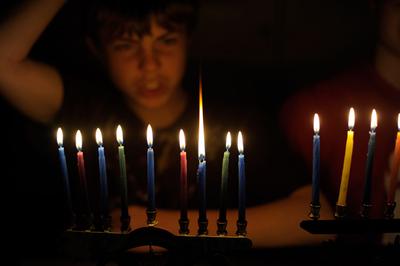
I need to pad the picture count for this chapter, so here’s a kid evoking some seriously magickal shit with his leftover Chanukah candles.
Solitary Legendmaking
If you can’t find anyone who wants to make legends with you, The Everlasting has more “guidelines” for solitary legendmaking. Don’t worry, you won’t go blind! That’s just the red lightbulbs.
Well, it sort of has guidelines. You remember when I explained that this book can be aggravatingly vague and noncommital, saying that you can do this or that but only if you want to, and not too much? This section is an entire page of the author not telling you to do anything in particular, which he calls the Free-form Creative method of solitary legendmaking.
Obviously, The Everlasting isn’t the same kind of game as the original brown-box edition of Dungeons & Dragons , which you really can play by yourself using the encounter tables . In order to Free-form creatively legendmake by yourself, you don’t need rules, or cards, or a character sheet...unless you want to, since it can inform what your character can and can’t do.
So what is free-form creative solitary legendmaking? Basically, you sit down and write fanfiction about your character, stream-of-consciousness style, without any outlines, editing, or any other constraints associated with good writing. Remember, you’re not writing for an audience, you’re writing to develop your personal mythology. Just writing out the characters’ actions as they come to you is upheld as an amazing and revelatory experience, and it’s suggested outright that you examine relationships with people in your own life and project them onto the protagonist’s relationship with other characters in the story.
There is the admonition that your protagonist shouldn’t succeed at everything lest the story get boring, but otherwise, “solitary legendmaking” consists of writing the most self-indulgent and masturbatory sort of fanfiction.
Alright, I can’t take any more of this shit for the time being. Next time, on The Everlasting :
http://vimeo.com/9880377
Legendmaking Part 2: Feel the Limpness Move Through You (long pause)
Original SA post
Chapter 13, Legendmaking Part 2: Feel the Limpness Move Through You (long pause)
After teaching us how to write fanfiction, The Everlasting ’s chapter on Legendmaking delves into Achieving Altered States of Consciousness .
quote:
Legendmaking is more than creating personal mythology; it is also about transcending your own conscious state to reach some magical level of heightened awareness.
You mean you’re going to teach me how to have the real power?
The first magickal altered consciousness legendmaking technique we’re supposed to learn is visualization , which simply means vividly imagining all the sights, sounds, smells, and feels so that the interactive legendmaking session is more real to you. We are told that some people are “high-imagers” and others are “low-imagers” but that everyone can learn to be a better “imager” by practicing meditation exercises--for example, focusing on objects and then closing your eyes and trying to visualize them in detail. We are specifically cautioned to avoid visualizing things contrary to how the Guide describes them, so you shouldn’t imagine a dark hallway as well-lit.
Meditation
The Everlasting is really high on using meditation exercises to enhance your legendmaking skills. First, it recommends spending 10 or 15 minutes in “character meditation” before sessions, closing your eyes and thinking deeply about your character’s personality and motivations so that you can roleplay them better. The second method it recommends is a more universal, less geeky practice in which you sit quietly, close your eyes, breathe deeply, ignore distractions, and relax fully so that you emerge from meditation feeling refreshed. (This is how a lot of normal people meditate; you don’t have to have a boner for a gun-toting mummy wizard.)
Finally, The Everlasting recommends that players go through a process of “ guided imagery similar to light hypnosis .” You can do this exercise with a partner, or by making a recording of your own voice reading the prompts below. The goal of this exercise is to delve deep into your own unconscious mind and develop a character concept for a protagonist that will reflect your innermost desires and fears and whatnot. Once again, I’ll let the book speak for itself. At length.
The Everlasting posted:
Okay then, let’s start now.
Please stand up and stretch your muscles. Stretch until you feel limber and relaxed.
(long pause)
Now have a seat and relax. Close your eyes and begin taking deep, full breaths. Breathe slowly and relax. Inhale. Exhale. Inhale. Exhale. Inhale. Exhale. good. Now take a deep breath. Hold it. Feel yourself relaxing all over.
(long pause)
Concentrate your attention on your toes. Now relax them. Let the limpness and relaxing energy move up into your feet.
(short pause)
Now relax your calves. Feel the light energies relaxing your muscles. Now relax your knees...now your thighs.
(short pause)
Relax your stomach muscles, feel the relaxation move into your lower back. Release the tension. You are feeling no itches, no pains. Feel the relaxation move up your back and chest and all through your shoulders. Feel the limpness move through you.
(short pause)
Now relax your arms. Feel the muscles energized with relaxing energy. Let the relaxation move into your hands, and now into your fingers. Allow your neck to relax as the tension in it slips away. Let the relaxation move into your face and head. Now focus on your eyelids. Relax all the muscles around them. Feel your eyelids growing smoother, heavier. Now your whole body is relaxed. There is no tension left in your body. A light energy spreads throughout releasing all the stress and discomfort you still feel.
(short pause)
I want you to forget your worries for now. Relax even more deeply now. We are going to go through the relaxation exercise again.
(repeat the previous section)
Once more let’s go through the relaxation exercise. This time you will become as relaxed as you have ever been.
(repeat the first section(
Now feel the relaxation double throughout your body. Feel as if you are twice as relaxed. You feel heavy, loose, and limp. All the tension has flowed from your body.
(short pause)
As you are breathing imagine you are inhaling anesthesia that is pure, odorless, and safe. Feel your body relax even more now. You feel more tranquil than you have felt in a very long time. As you breathe. your breaths become deeper, even more peaceful and soothing. From now until the end of the session your breathing will be easy, allowing you to maintain the deepest peace, tranquility, and relaxation. You will remain awake and aware, but focused only on what we are doing. I want you to imagine a chalkboard in your mind. Now I want you to imagine you are holding a piece of chalk. On the chalkboard you see a circle. Inside that circle I want you to write the letter Z. Look at it. Now erase it. Write the letter X in the circle. Look at it. Now erase it. Now do the same with the following:
(read even more slowly here)
W.V.U.T.S.R.Q.P.O.N.M.L.K.J.I.H.G.F.E.D.C.B.A. Relax. Now erase the circle and forget about the chalkboard. Feel yourself becoming even more relaxed now. Feel a pleasant breeze blowing now, bringing you even greater peace and tranquility.
(short pause)
Try to open your eyes...now relax them. Now feel your bdbodyoy covered in sand. Heaviness is settling over your body. You feel numbness and your body is too heavy to move. Feel your toes and feet growing heavier. Sinking. Feel your ankles and calves growing heavier and sinking. Feel your knees and thighs now, growing heavier and sinking. Your breathing is deep and easy. Feel your hips, butt, groin, and waist grow heavier and sinking. Feel your stomach, back, and chest grow heavier and sinking. Feel your shoulders and arms grow heavier and sinking. Feel your hands and fingers grow heavier and sinking. You feel great peace and tranquility. Feel your neck, head, and face grow heavy and sinking. It seems your upper and lower eyelids have joined together as one.
(short pause)
Try to open your eyes...now relax them.
None of this made it into the PDF edition of the game, probably in the interests of making it more pure, odorless, and safe. I don’t know about you, but imagining myself being anesthetized, forced to write the alphabet, and buried alive in sand doesn’t make me feel relaxed and peaceful.
Now for the next part!
A game designer who would make a pretty good Dexter villain posted:
In a few minutes I want you to create a character for a roleplaying game, a hero. Someone who is good, someone you can look up to. I want you to bring to mind all the people, real and imaginary, you admire or want to be more like. I want you to consider the qualities you most admire about them, the reasons you wish you could be more like them.
(long pause)
Relax and consider. Take your time.
(long pause)
Now I want you to go on a journey into a magickal world in your mind - a secret world of heroes, quests, magic, and wonders. Reaffirm in yourself the need to find a guide for yourself, a hero, one who embodies the good qualities you most admire. In a short while you will come face to face with this hero. But this hero will not be perfect. This hero will share some of your own greatest flaws - one you wish you could overcome. Those flaws will be recognizable by you and together you and the hero will work together in overcoming the flaws by learning to best utilize the strengths of the hero. Now we begin the journey.
(short pause)
From a point on your brown [sic], just between your eyes, your consciousness leaves your body taking your own physical form, only much smaller. You are now the small version of yourself standing before your larger self. You are not troubled in the least by this. It is magical journey [sic] and you are ready to proceed. For the next three breaths feel yourself shrinking, becoming smaller. You are now ready to enter your own body, for it is your own inner secret world. You fly into it without any harm. You are surrounded by darkness in this timeless, dreamlike place. You are unafraid and notice it is strangely familiar to you. You are even more relaxed and comfortable here. Yet you are without landmarks and you are deeply aware of your vulnerabilities, failings, needs, and hopes.
(short pause)
You see a soft, dim light ahead in the darkness. You fly toward it and see that it is a monument. On this monument are written the commandments and beliefs by which you have lived your life thus far. Take your time and read these commandments to yourself silently. Now consider them. Remember them.
(long pause)
Now move on, back into the darkness. Feel your courage growing stronger, you are fying deeper now into the hidden places of your soul. Below you, you see your past passing by, with all its pain, pleasures, securities, love, fear, and confusion you have felt. Your past is not to be pitied, condemned, or ridiculed. It gives you strength, courage, and the power to survive. You have flown beyond your past now and you have entered a more magical land. Somewhere below you, you see a special, sacred location, picture how it looks to you. Your hero waits for you there. You land and find a magical building or place outdoors. You see an entrance and go through it. Once inside, you see your hero for the first time.
(short pause)
Walk up and greet our hero. Use your senses and impressions to discover all you can concerning the hero’s appearance and temperament. Thank the hero for meeting with you in whatever words or gestures you please. You recognize that your hero loves you and respects you. Your hero is totally loyal and committed to you. You look into one another’s eyes now. You may now ask the hero some questions of importance to you concerning your life. You will receive valid answers, even ones you might not expect.
(long pause)
You will need to revisit your hero. You may do so in your dreams, all you have to do is call out for the hero and the hero will appear. You can also use meditation, and once you reach deep relaxation you can mentally travel her to be with your hero. Now, with reassurance from your hero, you can leave this magical place. Fly back into the light to return to your ordinary world. You may find other routes in and out of your secret world, but the one you have just used will always be available to you.
(short pause)
When you awaken in a few moments, you will be fully conscious and aware of the magical journey you have just made. You will be deeply relaxed, even more so that [sic] you are now, but you will also feel awake and refreshed and capable of moving freely. You will remember your hero and from this hero you can create different characters based for use in legendmaking. The session is now coming to a close Remember at the start that I told you that at the end I really wanted you to wake up.
(short pause)
When I count backwards from ive and reach one, I want you to open your eyesand be fully conscious and awake. 5...4...3...2...1
Next time, on The Everlasting : (long pause)
Legendmaking Part 3: Everybody Dreams
Original SA post
Chapter 13, Legendmaking Part 3: Everybody dreams
The final leg of our journey down the rabbit hole is an exegesis on lucid dreaming. Here’s a “visualization” exercise for you: Picture HP Lovecraft handout out crystal necklaces at a Vampire LARP. There, now you can skip this section.
Dreams constitute “another reality as powerful as the one you are experiencing right now,” or so Everlasting tells us. It does discuss the phases of sleep on a more-or-less scientific fashion, but it also discusses dreaming states using language that sound more like the fictional realm of dreams in a game setting than what dreaming is actually like. For example, a whole section on “dream physics” belabors the point that in dreams, things can suddenly disappear or change completely, as if anyone needs to be told.
You spend a quarter to a third of your life asleep, so it behooves you to understand the “wondrous, fantastical realm” of dreaming! The Everlasting purports to teach lucid dreaming. It plays up using lucid dreams as an opportunity to play out the fantasy of your choice--being a pirate, knight, monster, Joseph Campbell--in God Mode. Of course, lucid dreams are also a chance to delve into your personal mythology and work out your personal issues, blah blah blah.
We also get a little “history” on dreaming. The ancient Babylonians, Egyptians, Greeks, and Romans all studied dreams and believed in their power. St. Augustine believed that dreams contained divine messages, but “later Church leaders stressed itself as the intermediary between Christians and God’s Will. The Church convinced people that dreams should be ignored.” If you thought you were going to squeak through a 90s Dark Modern Fantasy game without some needless potshots at Christianity for ruining somebody’s childhood, you were wrong.
How does one become a lucid dreamer, or as the book calls it, Oneironaut? Sleep longer, record your dreams in as much detail as possible as soon as you wake up, and add anything you remember during the course of the day. (This is, as far as I know, a very effective means of remembering your dreams and increasing the likelihood of lucid dreaming.) We’re also instructed to look out for “Dreamsigns,” which are sights, sounds, settings, and even moods which are common in dreams even when haven’t experienced them in real life. Once you’ve done this, you’re reading to follow the procedure for lucid dreaming. Mostly, this boils down to relaxing as you wait to fall asleep, and focusing on what you would like to dream about and that you would like to be able to remember it. More alarmingly, we’re told to practice asking ourselves whether we’re awake or dreaming at least ten times a day.
Once you are successfully lucid dreaming (uh, oneironauting?), Everlasting has some suggestions for what you can do with your newfound superpowers. Flying, for example, or altering the laws of physics. You can also alter your own body and create dream characters. If your first suspicion is that this sounds like a setup for zero-gravity furry sex, then you read this thread too often.
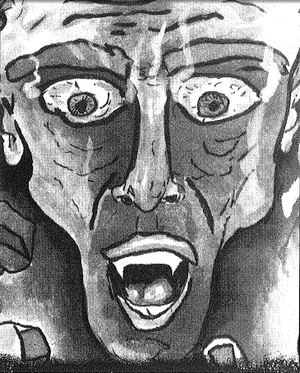
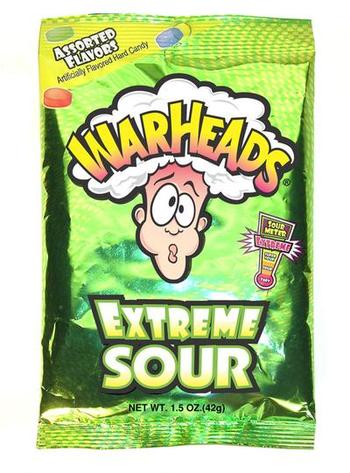
Lucid dreaming is also supposedly a great way to get ideas for a campaign--sorry, Odyssey. This is the same as “ordinary” lucid dreaming, except that you should jot down an outline for a legendmaking adventure during the day. Supposedly, the symbolism and all that other Campbell shit will just come to you while you’re dreaming. There is also a brief section on nightmares, which encourages you to confront the painful and scary experiences and images that show up in nightmares, rather than fleeing from them. We are also reassured that you will not really die in real life if you die in a dream. Seriously.
And now, a final word from our author:
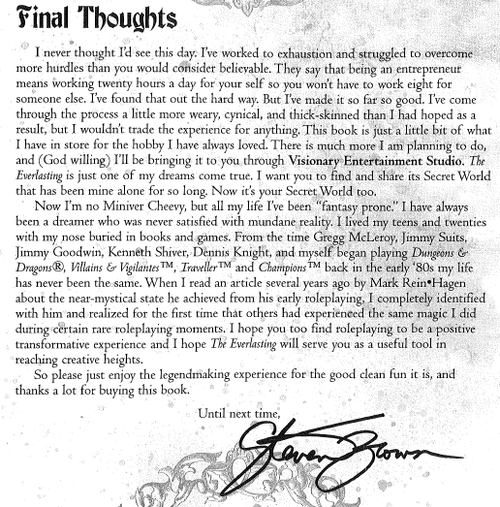
My only reaction to this is that I can’t believe this game was written by someone old enough to have played in the early 80s. I mean, most of what’s wrong with SLA Industries is attributable to the fact that the design team was only old enough to drink because they grew up in Scotland.
Next time, on Everlasting : Oh, but there's more! A brief chapter giving you a starting Odyssey, "Time of the Dark Ones." The forecast calls for trenchcoats and katanas with a chance of submachineguns.
The Long Dark Magical Tea Party of the Soul
Original SA post
Chapter 14: The Long Dark Magical Tea Party of the Soul
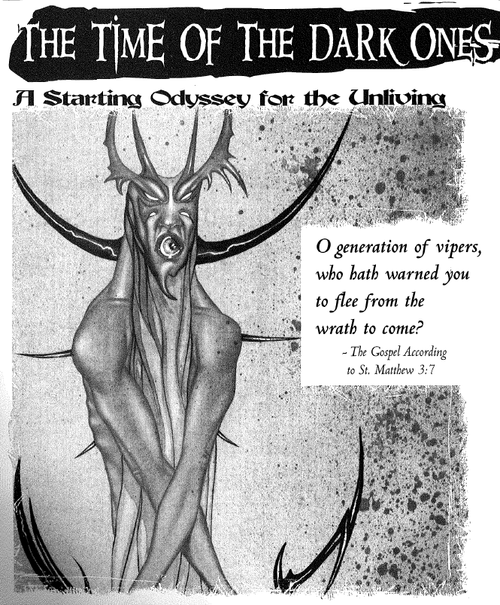
This chapter is a sample Odyssey. It’s divided into chapters, and each chapter has an entry for each of the 6 or 7 plot threads running throughout the campaign. Those plot threads are:
1. A vampire army
2. A werwulf cult
3. A massive influx of dead souls
4. A conflict with daevas
5. A revenant conspiracy
6. An onslaught of demons
7. Other eldritch doing random things.
I must be more naive than I thought, because Everlasting still manages to surprise me with its failure to...well, to be about what it claims to be about. There’s nothing at all in this guide about theme or mood, much less the bizarre New Age pop-psych exercises that have been preached to us for the last two chapters. Everything in this chapter is organized based on what kind of monsters the PCs are dealing with, and yes, there are way too many of them.
“Time of the Dark Ones” reads like a parody of one of those World of Darkness sourcebooks that came out late in the game’s lifecycle, with little oversight, videogamey plots, and packs of monsters from the other game lines showing up just because. When the elves and orcs appeared, I thought they must be fucking with me.
Speaking of elves, you could use this as a guide for a D&D campaign with little or no tweaking. This campaign doesn’t display any of the modernity of the setting, which doesn’t surprise me--this game is clearly more interested in the eldritch and their shenanigans than in making any of it relevant.
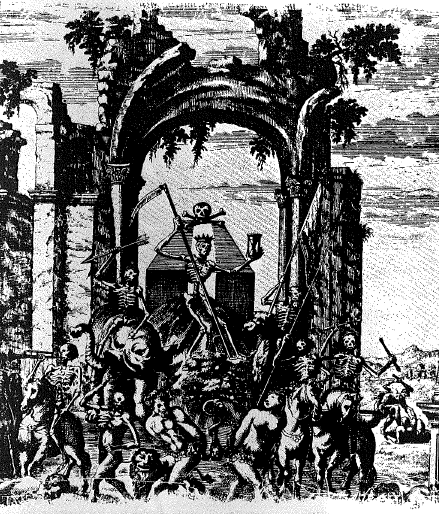
The art budget’s finally run out! We takin’ over this bitch! Woodcut skeleton party 4 lyfe!
Chapter 1: The PCs are invited to a gala event hosted by the Court of Night . They learn that vampires are amassing an army and werwulfs are killing people. One of the PCs has a dream about a half- demon torturing some vampires. The daevas issue a demand for the vampires to stop killing people indiscriminately, and the vampires kill the messenger and send him back in pieces. A dark elf requests a private audience with the Court, a revenant tries to feed on him, and he defeats his attacker with magick. Sounds like one hell of a party.
Chapter 2: The Court of Night tries to recruit the PCs. Ghuls share gossip about the vampire army and a secret faction within the Court. An NPC takes a romantic interest in one of the PCs. The PCs learn that many dead souls are coming to the city through an unknown portal to the Underworld. They also encounter werwulfs killing mortals. A PC has a dream telling him that the demons control a company called Blackstone. Another PC sees orcs and dark elves skulking in the ghul catacombs.
Chapter 3: The PCs and Court members are invited to a ghul meeting. The ghuls reveal that many bodies are being stolen, but the Court doesn’t care. The grim reapers show up hunting dead souls who are members of a cult called the Black Circle. Werwulfs spy on the PCs. The PCs can join a daeva attack on a Blackstone facility. The Dracul and the daevas declare war on each other, and an Osirian shows up to lead the PCs to an evil necromancer. He dies before revealing any information.
Chapter 4: The PCs are framed for attacking Court members, but the Court learns they were set up by the Black Circle. The Dracul expect a favour for exonerating the PCs. A ghul wizard invites to PCs to exchange information about the dead souls , and evil ghosts attack. The werwulfs are killing more mortals and selling the bodies to revenants. The Black Circle spies on the PCs and tries to recruit them. The daevas start fighting the demons and werwulfs. Gargoyles appear and hunt down murderers in the city.
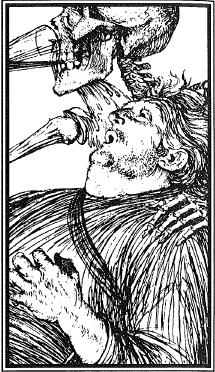
Eat, drink, and be merry, for yesterday I died. Tomorrow you die. Probably from eating and drinking.
Chapter 5: The Court invites the PCs to a holiday party where three mortal vampire hunters are burned alive as a celebration. Then werwulfs attack. Some Court members call for the formation of a group to protect neutral eldritch from the warring factions, calling themselves the “Peace Faction.” They try to recruit the PCs with the promise of reward. Some dead souls approach the PCs asking for protection from Underworld monsters, the “Brood of Lilith,” coming through the underworld portals. Demons try to seduce the PCs. The daevas bring in angels, questers, and elves to help them fight the demons. The dark elves offer the PCs a magickal device, claiming that they don’t know what it is, but that it will be necessary in the future. (I guess one of them had a dream about it?)
Chapter 6: The PCs “overhear” two vampires talk about burning down the Draculs’ castle. A ghul whose packmates were all killed by werwulfs , offers information in exchange for protection. The NPC who had showed romantic interest in one of the PCs asks them to help her kill her creator.
The PCs also get a map to the underworld portals from the Osirians , and Lilim vampires and ghuls ask for help closing them. They have to travel into the underworld and close the gates one by one. Later, werwulfs attack. The PC who’s been having dreams about demons gets kidnapped and the other PCs must rescue them. Some daevas agree to stir up trouble among their own kind in exchange for favours from revenants.
Chapter 7: The attempted arson sets off a Blood War between the Dracul and Tantalusi. The Brood of Lilith are killing eldritch. The werwulfs control a human cult. The dream-plagued PC dreams about Lilim suspended over a pit by demons , and the PCs have to rescue them in time. The daeva faction begins to collapse. Manitou show up to fight the Black Circle.
Chapter 8: Other vampire consanguinities (ugh) take sides in the Blood War. A PC discovers that a Peace Faction leader is a Black Circle member. Grim reapers continue hunting dead souls. A PC is betrayed by a friend who is secretly a Black Circle member. The PCs track the werwulf cult to their headquarters where they learn the werwulfs sell humans (alive and dead, including some allies of the PCs) to a necromancer. Angels join the Lilim in fighting demons. The Black Circle tries to frame the PCs again, this time for attacking daevas . Again, it doesn’t work. The dark elves “grow in number, but remain in hiding.” Okay.
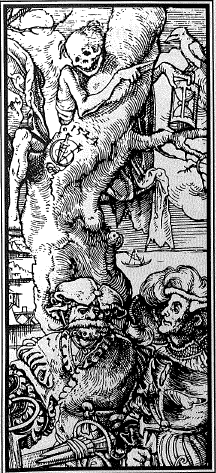
Necromancer Lair: This Way
Chapter 9: Ghuls warn of more disappearing corpses. Werwulfs try to destroy the PCs’ homes. Fifty demon worshippers sacrifice themselves to open a temporary gate and let more demons into the world. The daevas realize they’ve been manipulated, sort out their internal issues, and focus on fighting the Black Circle.
Chapter 10: The Dracul defeat the Tantalusi, but are quickly defeated themselves by the Peace Faction. The leaders are entombed. The PCs discover another evil necromancer serving the Black Circle, and is helping evil revenants possess the bodies of mortals the PCs know. The werwulfs collect bodies, the war with the demons continues, while the Shiny Happy Eldritch (daevas, angels, questers, etc.) have a series of pitched battles against the Black Circle.
Chapter 11: The PCs discover that the Blood War was orchestrated by the “Peace Faction” all along, and the Peaceniks are members of the Black Circle. The Black Circle has been collecting bodies so that they can summon a “dark god” to inhabit a gigantic monstrous human centipede. Dead souls warn of an “oncoming storm” before vanishing. Werwulfs stop doing stuff. Demons arm their human cultists. Dark elves and orcs move into the city.
Chapter 12: The PCs rush to stop the summoning of the dark god. If they can’t stop the ritual, the God sucks the lifeforce from its summoners before going on a rampage. If they fail, it will inflict heavy casualties before the Shiny Happy Eldritch army stops it. The grim reapers show up to hold the revenants at bay. The werwulfs join the revenants. The demons fight the questers and angels.
Chapter 13: Other eldritch fill the power vacuum left by the Peace Faction, the Blood War factions, and the casualties of the dark god. This means the PCs will receive great renown and dominions of their own. The ghuls lay claim to former vampire dominions. The Brood of Lilith are still out there. The remaining werwulfs and demons flee or go into hiding. The dark elves also emerge and lay claim to abandoned territories, but only fight in self-defense.
I’ve got to admit, this campaign definitely has its merits. There is plenty of stuff for the PCs to do, an impressive absence of godlike NPCs controlling everything, and it even ends with sensible rewards for the PCs and setups for future conflicts. On the other hand, I was surprised by the straight-up dungeoncrawls to close magic portals, a videogamey boss battle to save someone from being dropped into a pit, and another videogamey boss fight against an Exalted rapemonster. That’s not to mention getting a magical doodad from an elf just because, and head-scratching incidents where orcs and gargoyles show up just for its own sake.
On the other hand, all that stuff is either innocuous or forgivably indulgent. The real problem with this campaign is that there is a set series of major events that the PCs can’t really change, although they can engage with them and reap rewards. What happens if the PCs go whole-hog on joining one of the warring factions? What if they wanted to side with the Black Circle?
There are no answers. The Everlasting: Book of the Unliving ends the way all its sessions should begin: without ceremony.
